Definitely the statement that some of the best things in life are free applies here. And I was lucky to get this invitation!
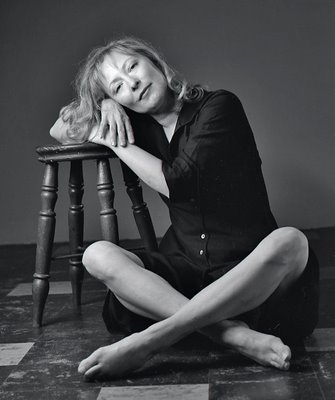
If you are available to come to one of these two rehearsals we would be very happy to see you there.
Please feel free to pass this information on.
Dancers Dancing Open Rehearsals:
WHEN
Monday, March 31 from 3-5
and
Tuesday, April 1 from 1-3
WHERE
3rd floor at the Scotiabank Dance Centre. (corner of Granville and Davie)
You are welcome to attend part of a rehearsal.
WHAT
We will be running our tour program before our final Made in BC - Dance on Tour Dates
The Program includes:
TWO, The Late Edition
Trio of Duets
ONE, The Catwalk
Quicksilver
Danced by: Desirée Dunbar, Christopher Duban, Vanessa Goodman, Kiri Figueiredo, Bevin Poole
Choreography by: Judith Garay
Original music by: Ted Hamilton, Patrick Pennefather
Cheers,
Judith
Often my students or young phtographer aske me if I would allow them to watch me work during a portrait session in my studio. Most often I answer in the negative. I wrote about it here.
This is why when I get an ivitation to watch dancers dance in pre-performances I make it a point to attend. What seems to be a pattern that is increasing, to my dismay, is that I cannot get Rebecca to attend them. Since we went to a PBO concert on Friday she turned me down for Garay's dance session today. It's the logic of a 10-year-old, "If I go to this I will not go to that." It breaks my heart to think that she may be losing her interest in dance as she increasingly wants to play computer games (the noises during these games make my cringe). But I cannot force the young girl. But this comes with an unforseen surprise. Lauren has said yes and she and I will be watching the dance session at the Scotiabank Dance Centre this afternoon.
There is another reason why I am looking forward to it. At one time I would have been embarrased to admit that I am going to a dance session to watch a particular dancer. But it was Artemis Gordon, the Dance Director of Arts Umbrella who once told me that I have nothing to be ashamed of. "Dance consists of beautifully shaped and fit men and women moving gracefully."

Lauren and I will be there today and I will be watching the deliciously shaped and powerful dancer Desirée Dunbar. Even though se will not be wearing a white raincoat I will not be disappointed.
White Balls Were Falling Outside The Library
Sunday, March 30, 2008
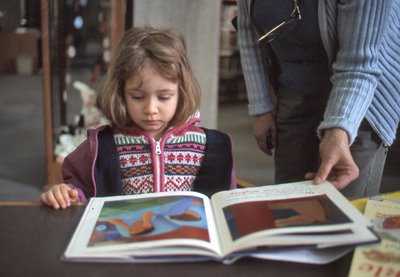
Yesterday the three girls (Rosemary, Rebecca, Lauren) and I went to the main branch of the Vancouver Public Library. We want to make it a routine again as we once did with Rebecca when she was 6. It was then that we started haunting the Spanish book section so that we could read Rebecca in Spanish. We never (at the time) explored the wonderful area dedicated to children in the basement. With lots of big windows overlooking the main plaza it does not seem like a basement and paradoxically it seems airy but intimate, with little chairs and tables. We adults are allowed to sit in the chairs if we are accompanied by a child. Best of all when children talk nobody shushes anybody.
Lauren will accept just about any picture book, be it in French, English or Spanish. Rebecca is more picky. She did not want to look for the Nancy Drews that were not part of her collection. It would seem that she is growing up even though she took Lilly the Cat (a stuffed one) in tow to the library. When Rosemary wanted to find Natalie Babbitt's Tuck Everlasting (we saw the film in Lillooet last week)Rebecca grew angry saying the book had too many big words and that she did not like its style. I asked here where she had read it. She had attempted to read it in school. I told Rebecca that perhaps Rosemary simply wanted to read the book herself as she had liked the film. "Don't be selfish, Rebecca," and help Abi find it in the computer." This we did.
Later on when Rebecca picked some extremely easy books in Spanish, Rosemary saw the light. "As long as she reads in Spanish and or English, that's what's important."
I can state with confidence that there is one virtuous habit that I learned under the firm thumb of the Argentine dictator Juan Domingo Perón. We were told in school that Perón instructed that books were to be treated with awe and respect. They were not to defaced or written on. Reading was to be a goal for all children if Argentina was to be a greater country some day. In the end, around 1955 Perón did not take his own advice and he started to burn books and bibles in churches. That was the beginning of the end for him and the Argentine Navy rebelled. By the time Perón escaped in a Paraguayan gunboat I had learned my lesson well. I have never felt guilty in buying a book even when I have had little money to spend. It is my hope that both Lauren and Rebecca will also learn this lesson.
As we were about to leave Lauren looked out of the window into the street. "Look, white balls are falling." It was hailing!
Saturday, March 29, 2008
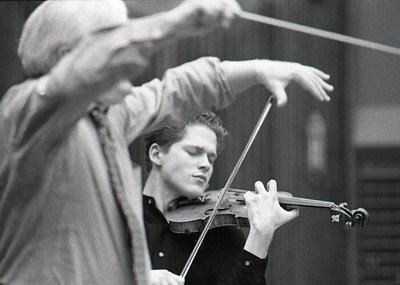
In all the various articles in the Vancouver media of the demise of the CBC Radio Orchestra in September none mention that our nation's orchestra was never Canada's but our very own Vancouver's. When it was first founded by Ira Dilworth in 1938 it was the CBC Vancouver Chamber Orchestra. In 1980 it became the CBC Vancouver Orchestra. Toronto took possesion only in 2000 when it acquired its present name the CBC Radio Orchestra.
In the 60s I used to listen to Willis Conover's jazz program in Voice of America. From Mexico City I was able to find the station in short wave. Conover familiarized me with cool jazz, the Westcoast California brand of jazz and performers such as Gerry Mulligan, Les McCann and many others. These were unavailable in Mexico City record stores. I was not aware that I was listening to propaganda.
I now love my Canada with its billboard-free highways. But we have more to offer to the world than that. Consider just Vancouver. My daughter Ale returned from Mexico City, not too long ago with a Mexico City Sunday paper. I noted that it had two pages of dance venues, two for theater and the same for classical music. This was astounding until I noticed the music was a surefire 19th century repertoire, the plays (the best of them) were Travels With My Aunt and the worst glorified soap operas. Dance was a legion of dancing swans. There was no experimental music or theatre or modern dance. There was nothing that cannot be found on any given day in our own "struggling world-class" city with its rich modern and classical dance culture, just penned experimental plays and new music concerts or concerts of the lesser known fantastic period of the 17th century, and a new music scene that struggles but still surprises.
Last night I attended a concert of the Pacific Baroque Orchestra with my daughter Hilary and her two daughters, Rebecca and Lauren. This was a reduced orchestra (the normal one is bigger) of a violin, viola, viola da gamba (or cello), violon and fortepiano. Even the PBO knows of troubled times and often performs in a "pocket orchestra" form. Many national orchestras are beginning to do the same. They spread the work around.
In the 50 and 60s I drew enough maps of Africa using a red pencil to mark the borders of the British properties, protectorates and colonies to learn that the world was being swallowed up into empires. I thought that nationalism was dead and we would soon become one happy capitalist conglomerate nation. I was wrong and so were the experts. Nationalism is alive and well and the concept is spreading.
I was talking to a CBC producer friend. I asked him, "Why didn't the CBC Radio Orchestra travel to the north of Canada to promote its brand of music?" I was astounded when he answered, "They went in September." All the good things that this Vancouver-based orchestra has done to spread culture in Canada has been unreported. That emminent and cultured American Senator, the late Daniel Patrick Moynihan would only smile.
When I wrote about the CBC Radio Orchestra here Bernardi had not yet stepped down (to be replaced by trombonist Alain Trudel, in itself an unique Canadian concept). I did not mention that the patrician conductor, John Eliot Gardiner avoids mentioning his stay in Vancouver in his lofty curriuculum vitae. Benign neglect must have been in full force by then. I state my fears that the CBC Radio Orchestra is one of the last bastions for the performance and (very important) recording of works by Canadian contemporary composers.
All the above and specifically my mentioning Wilis Conover and the Voice of America is patent evidence that the CBC Vancouver Orchestra (as I will always remember it) was a potential Canadian cultural gift to the world that was never used to its true potential. Can you imagine the columns of copy that would have been generated by :
Canadian Cultural Icon Plays To Its Troops in Afghanistan
Or:
Canadian Orchestra Plays In The West Bank.
Our much lauded but strained concept that Canada is a peace keeping nation would be far better promoted with cultural contributions to the world with our music, theater, dance and visual arts. A cultural peace corps of sorts under the umbrella of the CBC would promote our way of life to the world. Unfortunately the concept of culture in the modern CBC is to announce and promote, ad nauseum, the name of Jian Ghomeshi. A one-man-orchestra is cheaper.
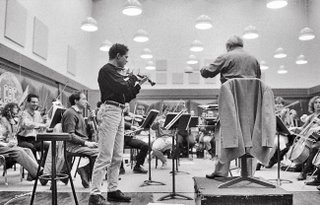
Also not generally known nor have they ever been acknowledged is how CBC producers George Laverock and Karen Wilson (in other countries they would have been a legion, not two) and the CBC Radio Orchestra put together wonderful concerts, recorded for the radio and on CDs between 1979 and 1989. I can remember the gaunt and over-worked faces of those two (Laverock and Wilson) who with the help of virtuoso recording engineers like Don Harder made music that dazzled Europe. I know that Harder was often wooed by European recording companies and we all know how happy Cecilia Bartoli is when Mario Bernardi is present in her performances.
In the pictures here that's conductor Mario Bernardi and violinist Corey Cerovsek in rehearsal in the CBC's Studio One.
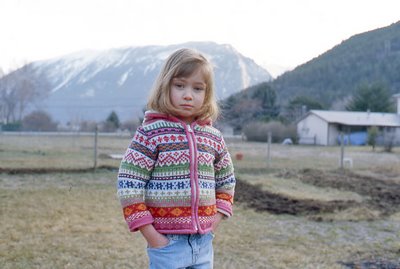
There's nothing more comforting for us, specially for Lauren and for Rebecca, than routine. An evening in Lillooet, an afternoon at VanDusen. The seasons change both locations but the places somehow seem the same in a comforting way. The mountains may have snow or not, but they are always there in the same spot. In VanDusen Lauren and Rebecca like to take the same paths. The like to go to the maze or look for turtles having a siesta on the rocks.

Rain or shine, summer or winter, VanDusen is always a delight for them. Lillooet promises the adventure of "camping out", of strange insects or the possible sighting of a bear. Lillooet is getting there. "How long before we get to Lytton?" Rebecca might say or Lauren will count the tunnels. Are there 7 or 8? We always forget. But we like the Alexandra Tunnel as it is almost the longest one.

Lillooet is fire. Ale slashes and burns the grass. She burns the dead wood that falls from the willows. She makes fires for marshmallows. I fire up the small gas Webber for the ham stakes or the meat tacos. Ale chops wood for the wood stove that heats the living room as we sit to watch a DVD film.

We know that the red rhodo at VanDusen would not survive the intense desert cold or the scorching heat of Lillooet. But Lillooet is our experiment. We divide up our plants to see which will slowly (as we think most plants do) adapt to a new climate. We have been taking clumps of Miscanthus sinensis 'Gracillimus" and the smaller 'Yaku Jima'. We think this ornamental grass might survive. I have given Ale some old roses with Japanese Rugosa parentage. They will surely be hardy.
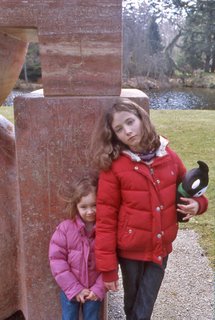
At Ale's you can see forever which is exactly as far as the mountains on both sides of the canyon. When we return to Vancouver it is odd to look out on our garden. The smaller scale plays tricks and it is almost unnerving.
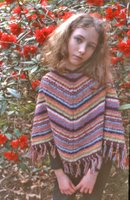
In going to Lillooet I pass the ghosts of my memory. A biker bash in Boston Bar, a night drive to the Charles Hotel (also in Boston Bar) in my blue Fiat X-19 with Les to exorcise daemons with the help of Lou Reed. Taking pictures of elite Canadian Pacific scalers near Lytton. They induced small landslides to prevent big ones from destroying track and rail equipment. Walking through Spences Bridge one afternoon with Mac Parry. I have forgotten why we went and why we did it. I do remember Mac saying, "I want to show you something neat." Mac had a way of pronouncing neat in a special way.
Some day Lauren and Rebecca will have their own memory ghosts to pass on their way to Lillooet. And they might even decide on exactly how many of those tunnels there are.
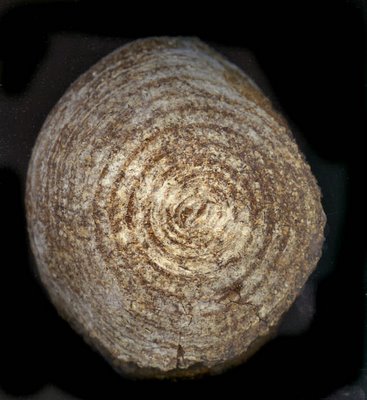
Riding the B-Line bus on Broadway to teach my class at Focalpoint on 10th Avenue I was startled by the sign Transilvania Peasant Bread near Collingwood. I decided that one day I would stop and have a look. I wanted to know if the baker was Hungarian or Romanian. As Erdély, Transylvania was Hungarian until recent times. This area which means beyond the forest in Latin is now Romanian. Yesterday I finally satisfied my curiousity.
The pleasant baker that greeted me in the cozy brick oven store had mostly empty shelves with only five loaves of the Sprouted Wheat Bread to testify that I was indeed in a bakery. Florin Moldovan told me he was Romanian and the brochure he handed me stated that Transilvania (with an i and not with a y as the Romans did not have a y) Peasant Bread bakes only two other varieties besides the one I purchased. These are the Peasant Bread and a Light Rye Bread.
A woman arrived, an obvious steady client who was disappointed not to find her favourite Peasant Bread on the shelf. She bought the Sprouted Wheat Bread and told me I would like mine. This I did as I ate approximately one third of the still warm loaf on my way home.
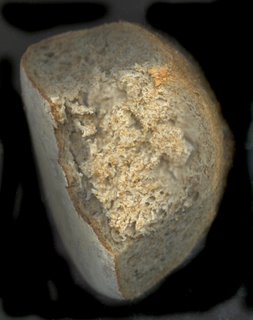
The whole pleasant affair made me think of bread. It made me think of bread in my native language - Spanish. I realized that even though bread plays an important role in all cultures it plays an innordinate role in my Spanish language.
Consider the word for baker in Spanish is panadero. That means one who sells or bakes bread. In English your baker could bake pies beside bread, pan. We are more bread specific in Spanish! Since bread and water are obvious necessities for our survival the surname Pan y Agua (modernized to Paniagua) has been in existence since the 16th century. The surname originated in the province of León where it spread to Extremadura from whence it came to the New World in the ships of conquistadors like Cortez and Pizarro who were from Extremadura.
Un pan de dios, (literally bread from God) is not equivalent to manna from heaven. In Spanish it describes a kindly person who will do anything to help those in need. There are many more expressions in Spanish with pan in them. My favourite is pan comido (bread that has been eaten). It means that a particular activity or job is an easy job to accomplish. Easy as pie?
When we first came to Canada 37 years ago we missed the tasty Mexican bolillo similar to the Argentine flauta (flute) or what we would call French bread. When we lived in Arboledas I used to buy bolillo dough at a nearby bakery to make the best pizza ever. I never told Rosemary what makes the bolillos in some Mexican bakeries saltier than in others. They say that bakers, who sweat lots being near the hot ovens usually bake topless. Sweat runs down and they wipe it off with the dough they are kneading.
The only bread that had any kind of taste was a Safeway brand of Dutch Crunch Bread. Everything else tasted of cardboard to us. It tasted of that Mexican white bread called Bimbo.
Bimbo, pan Bimbo
¡Hay! Que re-rico
Es el pan Bimbo.
Now I would challenge anybody who would say that a good loaf of bread cannot be found in Vancouver. Rosemary particularly loves the Safeway brand of medias lunas or croissants. I favour the IGA pizza bagels.
And with my discovery of Transilvania Peasant Bread on 3474 West Broadway it has never been more evident.
In the evening when Rebecca and I went to Opera Sushi I was only able to have a miso soup. The bread had filled me. Taking Rebecca home, she asked, "Can you put the Dracula music?" I knew exactly what she meant. I turned on the CD player and we listened to Bach's Toccata in D minor for organ. That piece of organ music is as much the bread of life as Florin Moldovan's loaves.
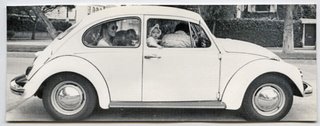
I first met Jorge Urréchaga in 1972. Both of us were teaching at a private high school for rich kids. Jorge was born in Cuba of Basque heritage and he and his family had moved to Mexico City during the Batista defeat by Fidel Castro. We had not spoken much at first. His English, while not perfect was precise and he taught English Literature. His Spanish was perfect and precise. We talked to each other in the formal usted. Instead of ¿Cómo estás? (How are you?) we said ¿Cómo está usted? which was stiffly formal. Until the last day we saw each other, when he came to Vancouver by bus from San Francisco in 1995 we used the usted. Just before Christmas on the first school year both Jorge and I (I am called Jorge Alejandro and Jorge always called me Jorge) had a boy from the Korean Embassy as a student. Jorge was given a bottle of Möet Chandon Champagne and I received a bottle of The Glenlivet Single Malt (the 18 year old one). We both eyed our bottles and without saying any words we exchanged them. The next morning a very terrible looking Jorge with deep bags told me, "No matter how much water I used to dilute that whiskey it was always strong! The colour was always dark." We became very good friends then.
By 1972 we were living in the outskirts of Mexico City in a neighbourhood called Arboledas. Jorge, who lived with his mother and younger sister (his father had died) would visit me in his souped up Ford Falcon. When I was in that car I was always terrified. He drove it as if he wanted to die. Jorge had a fine tenor voice and was a fan of opera. He would would stay late, even after Rosemary had gone up to bed. He would sing his favourite arias. Rosemary would have to close Ale's (our daughter was 4) room door. His favourite opera was Umberto Giordano's Andrea Chénier. I soon knew this opera very well. He also introduced me to Vivaldi's Gloria in D major. He brought the Vivaldi one day and convinced me to buy his Acoustic Research transistor amplifier and his Acoustic Research turntable. I would say that Jorge fine tuned my ears and taught me to appreciate music I was ignorant of.
One of the most interesting moments of our friendship happened one day when he called to tell me that we were going to see Andrea Chénier at Bellas Artes, the Mexico City opera house. A young Mexican tenor was singing the part. His name was Plácido Domingo. Because Domingo's mother sang in a review theatre, el Teatro Blanquita, Mexicans considered him a Mexican then and do so even now. We listened to the first act in a TV station technical van. Jorge had connections. We then went to a loading bay and Jorge knocked in a special way. The doors opened and we were whisked to an empty box. This was the media box which was always empty.
Jorge would call for other reasons. "Tell Rosemary that we are going to the horse races in the afternoon and we are dining in the evening." We would meet Jorge at the Hipódromo de las Américas. Jorge always chatted with a Jewish friend who owned a horse hair brush company. The would do this as the horsed paraded for the paddock inspection. It seems the man knew his horses. He knew his horses by the sheen of their coats. We would pass on most races and then Jorge would tell us to bet on a particular one. I was always cautious but we always won. With part of the money the three of us would then dine at our favourite restaurant, Sep's, which featured Alsatian food. I don't think I ever bought the Jewish horse hair expert know his horses and I suspected that Jorge knew a few of the jockey who probably threw races.
Another time Jorge called and said, "Tell your cousin Robby (he lived nearby) that we want to play some bridge." I told Jorge that Robby was an uncommonly good player. "Don't worry about it. If he asks just tell him we use the Schenken Convention." We of course won all night in spite of the fact that I have never been a good card player. I soon found out why Jorge won at bridge and at any other card game. No matter how perfect a set of cards was, within 15 minutes Jorge had every car memorized by the nicks or irregularities in the back. After 15 minutes our oponents could just as well have been playing with their cards facing the other way.
Jorge was into chess and he told me the history, play by play, of the world's most interesting players. He had a preference for a man called José Raúl Capablanca who happened to be a Cuban diplomat. From Jorge I found out all the ways chess masters cheated and how they bullied their oponents into making mistakes. I felt I knew both Bobby Fischer and Boris Spassky intimately. But then I also knew all about Maria Callas and Alfredo di Stéfano.
But the most unnerving calls were the ones were Jorge asked, "Is your mother deaf?" My mother lived with us and she suffered Meniere's which made her very deaf and very dizzy on some days. When that happened Jorge would come and my mother would read his cards. My mother, according to Jorge, was extremly good at it when she was deaf.
A month before my mother died she read her own cards at a function at the Filipino Embassy. She was reading her cards in the presence of the Cultural Attaché who was also good at card reading. We called her "la bruja", the witch. Something happened (I was there) because there was a sudden silence. We all asked but neither my mother or the Attaché made any comments. After my mother died the Attaché called to tell me that my mother had dealt herself the Queen of Spades and she knew she was going to die.
My mother was very deaf the one last day that Jorge came to visit us. She read his cards and told him he would be flying to Europe soon with a friend who was not good for him and that an accident would happen.
Jorge went to Europe without telling me who his friend was. A couple of months later he called from Rome. "I have to return home now." On the spur of the moment I said, "Did you run over some old lady?" There was silence and Jorge asked, "How did you know? I have to leave town or I will be put in jail.She just stepped from the curb. There was nothing I could do."
Once Jorge returned I was walking in the Zona Rosa in Mexico City when I spotted him wearing a black leather jacket as he emerged from his Falcon with a young man (perhaps a boy). It was then that I realized that Jorge was gay and being gay in macho Mexico was not easy. I kept this to myself and I never asked.
Shortly before we came to Vancouver Jorge called me. We met at a cafe and he told me this story.
When I was in my teens I joined the Cuban Communist Party. It was the fashionable thing to do. I soon lost interest and gave it up. Recently I went to Houston for a nose operation. I had a blockage that prevented me from singing to my best potential. When I entered the US I was asked if I had ever been a member of the Communist party. I knew that if I was affirmative they would have prevented me from entering. So I told them no. The operation was successful and when I returned home my mother gave me a letter that had arrived from the US Government. I was banned for life for ever entering the US. When I returned from Rome after that accident my direct flight to Mexico City was diverted to Miami becaused of engine trouble. As soon as the plane landed two FBI agents met at my seat and took me to a room where they strip searched me and then put me on the first plane out which happened to be to Paris. I had many problems securing enough funds to fly back to Mexico City.
In 1995 Jorge called me, out of the blue. He was in Vancouver to visit a friend and he wanted to see me. I picked him up at the Greyhound Bus Station and he proceded to tell me that he was gay, that he was married to a man and that he lived in San Francisco. He told me had AIDS and that he was alive because of a potent cocktail that he took every day. He had dinner at home and with Rosemary we reminisced about the horse races and dining at Sep's. I looked at Jorge's gaunt and sad face and I knew I would never see him again. He gave me his phone number in San Francisco. By the time I remembered to call the line had been disconnected.
To me Jorge had a little of Byron in him. He was neither good nor bad. He was a complex mixture. He was a faithful friend who introduced me to opera. I respected him for never taking advantage of his talent for cards or for winning horse races to become very rich. He seemed to have in check that ambition all of us have for power and wealth. I think he was a bit of a hood. We all need to know a hood. It makes our life that much more interesting, that much more understandable.
If there was one tragedy in our friendship it is that I never thought to take his picture. The closest I ever got was this snap of our new arctic blue VW which according to Rosemary's (that's Rosemary in the back seat with Ale, an baby Hilary in the front) I took it near the Etchegaray post office were we kept a postal box. That's Jorge's back in the front.
Since I was a little boy I often heard my mother tell me, "Hay poca gente fina como nosotros." This sort of meant, "There are few people around with our bearing, good sense, taste and manners."
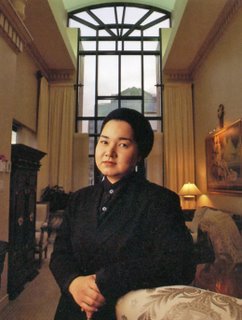
For the spring issue, 2000, of Nuvo Magazine (a magazine for which I worked for short while) I was assigned to photograph an emerging Vancouver fashion designer called Yumi Eto. Because this magazine had foresight (it is now standard editorial procedure) they arranged for me to photograph Miss Eto at a small Vancouver boutique hotel called Le Soleil on Hornby Street. It was not that she ever stayed there but the art director told me it would look good in the photo credit department.
I have never really had much of desire to dress fashionably although I have had my moments. Back in the early 50s in Buenos Aires I was extremely ashamed of my Argentine jeans when my fellow American students at the American School wore Lees, Levis and Wranglers. I could not explain to my mother that all jeans were the same. I remember nagging her until she bought me a pair of black high top Pirelli tennis shoes. We called them tennis shoes then. And in Rosita, Northern Mexico I could never make my Lees look quite like Sammy Simpson's.
In the late 50s I discovered the button-down shirt and black cordovan loafers. I have never lost my love affair with former and I have long lost interest in expensive shoes. In the late 80s I went to New York City and went directly to Brooks Brothers to buy a blue Oxford button-down shirt. When it got time to pay, my American Express Card was rejected and I was most embarrased when the man behind the till (he looked and sounded like a failed Holywood British actor) said, "There seems to be a problem, sir, with your plastic." The problem was resolved to my satisfaction when I called up the folks at American Express but somehow the shine was off in wanting to be fashionable.
I now have no fashion drive or sense. I buy blue and black jeans at Mark's Wear Warehouse. Of late I have been indulging in the stretch variety of blue jeans. They would have been anathema a couple of years ago. I buy my black oxford shoes at Mark's, too. Every couple of years I get some dark blue and black mock turtle neck long sleeved cotton shirts. I used to wear all kinds of T-shirts (my collection hovered around 75) but now I will either wear pictures of my granddaughters on white T-shirts or black or blue plain T-shirts (from Mark's). I buy my boxer shorts at Simpson Sears.
While I insist in writing here that I was never crazy about fashion, my daughters never fail to remind me how I used to carefully dress before going to a punk concert at the Smiling Buddha. I wore tight black jeans, black Big John slip on low cut boots, a black T-shirt and a black leather jacket. The whole package failed on the spot as soon as I pulled out an Irish Peterson pipe (in a stle called Canadian) and filled it with Balkan Sobranie tobacco and lit up.
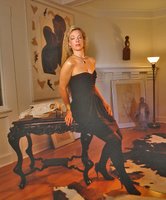
Vancouver Magazine dispatched me to photograph another fashion designer in the late 80s called Katherine Regehr, (right). A young Doug Coupland, (below, left) insisted in coming as he said he would help me style the photo. He did and my photo looked grand.
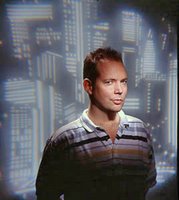
Even though I have no desire to be fashionable I remember some of the nice things that did happen thanks to the fact that through my work with magazines I had to at least know something about fashion. Recently after a successful shoot, a red haired woman with many freckles brought me white roses. It made me remember only one other occasion when something similar happened.
Yumi Eto was so pleased with her portrait that she sent me white roses.

As a boy in Buenos Aires my parents used to send me to the camp. Camp, was word the British living in Argentina had borrowed directly from the Spanish campo as in campo abierto or open country. Right after the Christmas season, when Buenos Aires was its most sweltering, I was sent to some place either in the province of Córdoba, La Pampa or Corrientes. I remember that the one in Córdoba was called Glen Rest and boys and girls from the British and American community in Buenos Aires were shipped there for a couple of weeks to rough it.
According to Rosemary going to Lillooet to visit Ale, our eldest daughter, with our granddaughters, Lauren and Rebecca, is just like camping. But this is a different camping from the one in BA. It is a rougher kind even though my daughter has ammenities that Glen Rest did not have, like central air conditioning. This is so even though the house is not quite one in my opinion and closer to a well appointed shack! Rosemary brings everything we might need, even our own large skillet frying pan so I can make the breakfast pancakes. Watching Ale slash and burn the grass on her property (with the accompanying smell) and her insistence in lighting a fire outside in the evening so that Lauren and Rebecca could cook marshmallows is what made it seem like we were camping. And very pleasant it was!
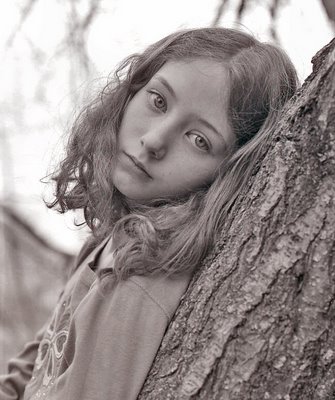
During our two-night stay over the Easter weekend Lauren and Rebecca planted daffodils and they went fishing but caught nothing. They quickly lost interest in flying a kite (I could barely keep it aloft as it seemed to have stall characteristics that made it suicidal) and it was finally "eaten" by one of Ale's fruit trees. I had to constantly cajole (or force) Rebecca from playing computer games. Lauren was much more willing to follow Ale around outside in the sunny but cold weather. And we cooked a lot, it seems.
I almost did not notice that when Ale's 96 year-old friend Margaret arrived, on Saturday evening, with her daughter Lenora for barbecued ham stakes, Rosemary's scalloped potatoes and Rebecca's salad that she (Margaret) noted that both girls had grown from last fall. Once they had gone we sat to watch the Ben Kingsley, Sissy Spacek and William Hurt version of children's author Natalie Babbitt's novel, Tuck Everlasting. Ale, who had not connected her TV to any cable or satellite dish since she arrived in Lillooet last July, had depended on a DVD player to watch movies. It had finally given up the ghost and we had arrived with a new player. I had carefully chosen Tuck Everlasting and the Walt Disney Treasure Island to give us some family amusement but with a challenge. It was interesting the that challenge happened even though both films were Walt Disney. We all noted that Robert Newton's Long John Silver was a full-fledged complex villain. He was neither all good nor all bad. In the end Silver escapes with the treasure. This was most un-Disney most un-Hollywood. Whe I saw the film in 1951 I was 9. I have a feeling that Rebecca understood the villain's very human behaviour much better than I ever did. In fact I am sure that I never caught on until this second time around.
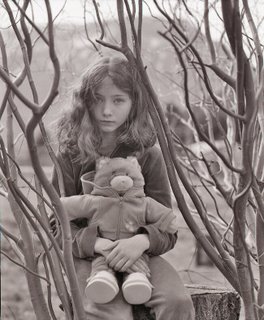
Rebecca had already seen Tuck Everlasting about a gentle family who after drinking from a spring under an oak tree had all stayed the same age for 100 years and were "doomed" not to die. It was most un-childlike that Rebecca refused to tell us about the plot twists or the ending even when we asked!
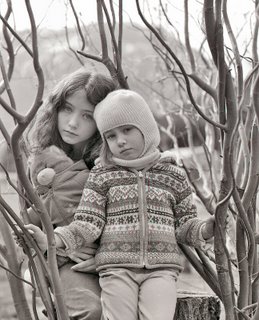
But it was the never-aging family Tuck that shocked me into remembering how Margaret had noted that the children had grown. Earlier that day, in the morning I had told Rebecca to grab Lilly, her stuffed cat and to pose for me by a willow tree and under and apricot tree. It felt different. Indeed both Rebecca and Lauren had grown. Paradoxically Lauren who used to be very difficult and fussy (about what she ate, for example) was easygoing and happy, while Rebecca who had always been easygoing and happy was more morose and even became angry when Ale's internet stopped working.
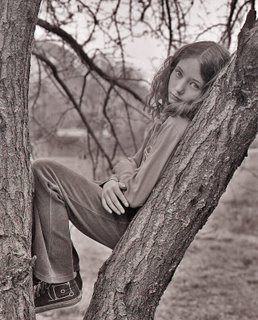
I told her to think about being a child who was becoming a teenager who was currently caught in a bittersweet transition. She seemed to understand and looked at the camera sadly. But when Rebecca asked to take a picture of Lauren (Rebecca had to bring a milk box to stand on so she could look through my large camera) Lauren, the child that she is, saved the day with a pleasant smile.
In a scene in Tuck Everlasting Angus Tuck (William Hurt) takes out Winnie Foster (Alexis Bledel) out in a rowboat to try to explain his and his family's fate. He explains, "We're like rocks stuck a the side of the stream," as all around them leaves rattle in the wind and autumn approaches. I must take Tuck's advice and glory at my own mortality (unlike his immortality) and enjoy every instant as my granddaughters grow up and change.

My on line dictionary of the Spanish language the RAE (Real Academia Española) defines el huevo de Colón or Columbus's egg:
huevo ~ de Colón.
1. m. Cosa que aparenta tener mucha dificultad pero resulta ser fácil al conocer su artificio.
This translates as: That which appears to be very difficult but is easy once the trick is known.
Venetian Girolamo Benzoni in his History of the New World wrote that when Columbus returned from his trip to the New World and sat down with nobles of the Spanish court they tried to diminish his accomplishment telling him that sooner or later some other Spaniard would have discovered it if he (Columbus) had not. Spaniards were so enterprising, the nobles said, that it would have been inevitable. Columbus asked a servant to bring an egg and he dared the nobles to stand it up without any help. The egg went around and no enterprising Spaniard was able to accomplish the feat. Columbus gently tapped the bottom of the egg (he dented it without breaking it) and it stood with no help. The nobles then understood the point that Columbus was trying to make - someone had to be first. To this day we say in Spanish that Columbus was the first man to make and egg stand. Most think this story as apocryphal but it sits well with most of Latin America and Spain where Columbus is still seen with some reverence.
In fact there is a monument to the discovery of America by Columbus in the shape of an egg in Sant Antoni de Portmany, Ibiza, Spain. Inside the hole there is a stylized model of one of Columbus's caravels.
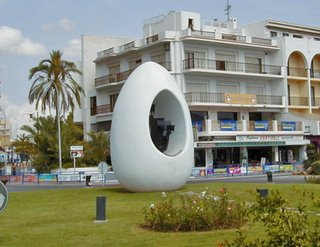
And there is a lesser known one in Seville.

Eggs are very important to Latin Americans. I will never forget seeing an early Mexican talk show on TV in the late 60s. Some comedian was asked what he put on his eggs in the morning. Since eggs are testicles to us, his answer brought down the house, "Talcum powdder, madam." A huevo or testicle is also called a cojón and the expression ,"Me importa un huevo," (or cojón) means, "I don't give a damn." Cartagena-born author Arturo Perez Reverte has written a very funny essay on the subject. Part of it is referenced here.
But the funniest story on Columbus's egg is a Catalonian song by the group La Trinca.
EL HUEVO DE COLON
En toda la historia sin discusión
no hay un huevo mas famoso que el de Colón,
Se hizo amigo de la reina
por medios muy singulares
haciéndole con un huevo
unos juegos malabares
Y le dijo: "isabelita,
a ver si me dáis un barco
que quiero echar un vistazo
al otro lado del charco".
La reina se convenció
no se sabe cómo fué
si no fue por lo del huevo
¡vete a saber porqué!
Y embarcó con los Pinzones
que eran unos marineros
y estuvieron en remojo
mas de tres meses enteros
Y cuando todos decían:
"Colón, ¡que te den morcilla!"
escucharon un calipso
"¡Ya estamos en las Antillas!"
Y feliz de estar en tierra
besó el suelo con unción
como hace el papa de Roma
cuando sale de excursión
y volvieron a España
y aquí se termina el cuento
que empezó como una coña
y acabó en descubrimiento.
Y se trajo de recuerdo
para la reina y el rey
cuatro indios con maracas
que cantaban "Siboney"
Y así gracias a Colón
hay tiendas de ultramarinos
tabaco, patatas, mulatas
y psiquiatras argentinos
y lo de la Madre patria
y los trescientos millones
corridos, guarachas, pachangas
y otros ritmos sabrosones
En toda la historia sin discusión
no hay un huevo más famoso
ni ques sea tan vistoso,
más glorioso, más garboso
más rumboso, más marchoso
que el de Colón.
Lletra i música: LA TRINCA
I will only translate this passage to give you an idea:
Y así gracias a Colón
Thanks to Columbus
hay tiendas de ultramarinos
there are grocery stores that sell products from the New World
tabaco, patatas, mulatas
tobbacco, potatoes, mulattas
y psiquiatras argentinos
and Argentine psychiatrists
y lo de la Madre patria
and that thing about the Mother country
y los trescientos millones
and the three hundred million
corridos, guarachas, pachangas
y otros ritmos sabrosones
and other really juicy rythms
Today, Holy Saturday, Rosemary, Lauren, Rebecca and I are visiting our eldest daughter Ale in Lillooet. We will probably have had a pancake breakfast. "I want to have pancakes under the peach tree," Lauren told me on Thursday. I had to explain to her that weather will not permit us to indulge as we did last fall. Sábado de Gloria is such an uncertain day. Will He rise? I wrote the blog below for Saturday, April 7, 2007. Abraham Rogatnick and I are still friends. There will be little of Abraham this Easter. Two Chritsmases ago he gave me some very expensive and beautiful garden tools. I have used all except a small Japanese saw which I gave to Ale. She called a few days ago, "Thank Abraham for that wonderful knife, it is so useful." But it seems that I had forgotten that this is not my second Sabado de Gloria entry. There was another on Saturday, April 15, 2006!
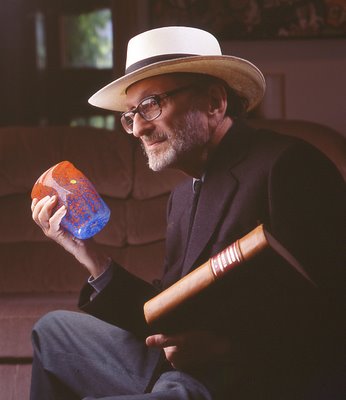
As I sat in the front pew of St Helen's Anglican Church with Abraham Jedediah Rogatnick yesterday evening I had thoughts of my grandmother Lolita and how she directed the Good Friday activities at home in Buenos Aires when I was a boy.
I had called Abraham in the morning to tell him that an unusual version of Mozart's Requiem was being Performed at St Helen's. The Vancouver Voices Quartet and Vancouver Chamber Players were performing the Requiem with only four voices and accompanied by a string quartet.
Many if not most of the patrons seemed to be parishioners of St Helen's (named after Constantine the Great's saintly mother). And there we were, a Catholic and a Jew sitting there discussing how three of the four singers had faulty Latin diction.
Perhaps my grandmother would have been shocked at it all or perhaps her anti-semitic stance was only Spanish 19th century upbringing. On Good Fridays I was not allowed to turn on the radio and sometime around 3 pm we would kneel on the living room floor in our Coghlan home and she would take us through the stations of the cross in Latin. I distinctly remember her telling me how the evil Jews had crucified Him. When describing people's faces she would sometimes say, "She has the map of Jerusalem on her face." Or she would switch to her alternate, "He is one of Jesus' countrymen."
But she never ever uttered a critical word about my best friend who lived across the street on Melián 2779. He was Mario Hertzberg. He, Miguelito (I have long forgotten his Calabrian surname) and I were inseperable and we were known as the inglesito (the english boy) el tano (the Italian) and el judío (the Jew).
Mario had two brothers but he once showed me the photograph of a third who looked much the same as he did except he was fatter and wore glasses. "That was my older brother but he died at a place called Auschwitz."
At age 8 I did not have enough curiousity to pursue the subject any further.
One day Mario and I went to see a Tarzan movie at the Saturday series sponsored by our local Capuchin monks who were building a very large new church next door to the little community center and movie house. They charged us a token fee but we knew our money was going to a good cause. As we left after the show we were approached by a chubby Capucine who asked us our names. He asked me to what church I went to. When he questioned Mario, Mario replied, "I don't go to church I am a Jew." I will never forget the Capuchin's smile as he placed his hand on Mario's arm and told us, "We share the same God and that is what is important." I thought about that for the rest of the day but I never confronted my grandmother with what to me was a clear difference of opinion.
I lost track of Mario Hertzberg when I was 20 but when I am with Abraham, even though he is 85, I find in his warm companionship, traces of that boyhood friendship that I miss but that somehow have come back.
It is appropriate that I write of this today. In Spanish, we call today Sábado de Gloria . It is an important day in Catholic liturgy as Catholics meditate on Easter Sunday. Easter Sunday is the most important feast day of them all. If the Man does not come back from the grave tomorrow it is all words and nothing more.
In my own little way I discovered last night as Abraham and I heard the lyrics:
tuba mirum spagens sonum (the trumpet will send its wondrous sound)
of a friendship reborn.
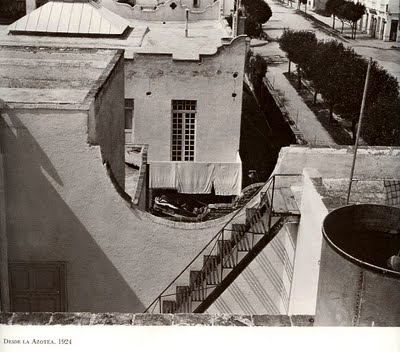
I have such a vivid memory about reading this article on Mexican photographer Manuel Alvarez Bravo on December 16, 1993 that I even remember it was a Thursday!
The idea that the 91 year-old man (he died when he was 100) would wake up every day and have a coffee, pan dulce and then go to his studio and photograph a female nude was astounding. What a routine he had! That he did it in a city without snow or cold, a city (as well as the mountains of the dry season) that is ochre (although Bravo's house was called the Blue House) brown, and red, colours that are inviting and not distancing like the greens, blues, cyans and grays of Vancouver gave me nostalgia for my youth in Mexico City. Reading Tim Golden's interview with Bravo I could imagine the smells of earth, water on sidewalks after a winter drought aguacero and the advent of the rainy season. I could imagine and remember the murals of Diego Rivera and paintings by Rufino Tamayo. But most of all I was grabbed by the last two paragraphs of the interview:
For many years, Mr. Alvarez Bravo used to summarize the philosophy of his method on a piece of paper tacked above the developing pans in his darkroom. "Hay tiempo," it read, "There is time."
When asked, he can't remember exactly what happened to the manifesto. He thinks it is back in the house, just up the crooked street from the blue wall of his studio. he isn't sure. But he smiles as he says this, and his meaning is obvious: there is no longer any need for such reminders.
It was around 1993 that I first read the Daybooks of Edward Weston with special emphasis on the first volume. 1 Mexico. But I skimmed through them without giving Weston's words much thought.
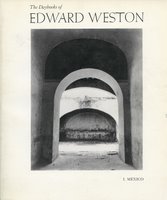
Of late I have given those words much thought and I have read them over and over. It was only a few years ago that I realized, that between 1962 and 1964, when I lived in an apartment on Avenida Tamaulipas in Mexico City, that I was but three blocks from Avenida Veracruz 42, corner with Durango. It was in this house that Edward Weston lived for a while in 1924 with some of his sons and his mistress the Italian photographer Tina Modotti. When Modotti was later expelled from Mexico for her communist views she sold one of Weston's 4x5 cameras to a young Manuel Alvarez Bravo. Weston had noticed Bravo's photographs and commented on his talent.
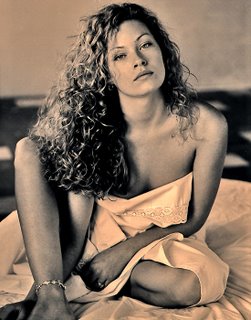 Ona Grauer in my studio, (right)
Ona Grauer in my studio, (right)
On a March 12, 1924 entry Weston writes:
From the negatives made of Tina lying nude on the azotea, (Weston's photograph from his azotea, above left)[a Mexican roof, complete with laundry hanging to dry next to large water tanks] one very excellent result which I have printed: it is among the best nudes I have done...
Or his entry for March 16. 5:30 [Morning or afternoon?] ...Some criticized my latest nude of Tina reclining on the azotea because of "incorrect drawing," but [Jean] Charlot did not mind it: he tells me that Picasso got his "inspiration" to use false perspective from amateur photographs. Diego [Diego Rivera] had another interesting note on Picasso, that he was never influenced or went to nature for inspiration, always to other "schools" of art.
And there is this torrid one, March 23, Sunday Evening:
After a day of loafing and napping, it is well to let the world slip by occasionally in indolent indifference. The twilight was spent in Tina's room and in her arms, for she had sent me a note by Elisa, "Eduardo: Por qué no viene aquí arriba? Es tan bella la luz a esta hora y yo estoy un poco triste. "Why not come up here? The light is beautiful at this hour and I am a little sad.
There is a certain inevitable sadness in the life of a much-sought-for, beautiful woman, one like Tina especially, who, not caring sufficiently for associates among her own sex, craves camaraderie and friendship from men as well as sex love.
There is one entry that mentions a very young and beautiful "starlet" called Dolores del Río. But my favourite is one that sunk in with all its loveliness of a father's affection for his sons, in this case Neil:
March 3. It so happened, Neil, that last night I dreamed of you. I held you on my lap, kissed your broad forehead, and you cuddled close, and asked for stories. We talked long together, of fierce fanged Aztec Gods, of white rabbits in clover fields - and we recalled days of long ago. How it used to be at bed time you would climb upon my back for a good night ride out under the tall black trees, waving farewell to Lady Moon, listening to the little pines whisper, or maybe, picking loquat blossoms fragrant in the night fog. Now you are there[California] and I am here, and perhaps you are so big a boy I could no longer ride you so. Well it came to pass that in my dream your dreamed too...All quiet now, only a distant mocking. I watched your sleeping face, as I looked down upon you, you became not only Neil, but the symbol for all in life of tender hopefulness. They will flout you, insult you, lynch you, but I will protect you, for I have masks that you shall wear, a horned and grinning devil, a sharp beaked bird, a ram in solemn mummery. I have them, I shall keep them for that hour when it must be you shall need them to hide behind and keep inviolate, untouched, the spark within which is yourself. They shall be my only legacy to you, carboard, painted masks, thicker than your thin skin...
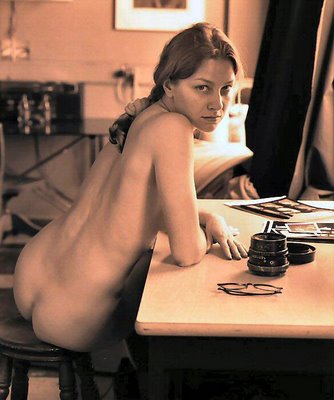
Yuliya Kam'yanska in my studio (left)
As I read and re read Weston's diary and look at the icy cyan sky of the North Shore mountains I remember that I have a warm studio on Robson Street. It is either cold or very hot. There is no in between with that steam radiator. And I have my photographic assignations with some beautiful women who consent to my photography with no fixed purpose except to take pictures, to explore what they are and or what I think they are. I happily send them (after all this is the 21st century) digital contact sheets (of negatives scanned) and print up photographs that smell of fixer which almost smells of Mexico City earth.
I sometimes question my obsession with the undraped female form. Since I am unable to explain it all in brief here I decided to look for an answer in my copy of The Photographic Nudes of Erwin Blumenfeld. The book has Berlin-born Blumenfeld's exquisite and classy (tame by today's standards) and it is nicely written by his son Yorick. Of his father he writes:
Women were the truest of his many obsessions and photography was one way of capturing them, of possessing them. The art historian Joachim Gasquet has described how Cézanne symbolically seduced his nudes in his great canvases, stroking them with 'great coloured caresses'. Gasquet wrote: "Nude flesh made him giddy, he wanted to leap at his models; as soon as they came in he wanted to throw them, half undressed, onto a matress...He had found another wasy to adore those nudes...he bedded them in his paintings, tussled with them." To Gasquet's conjectures about Cézzane, I can only add my own about my father. I don't think that his sublimations were all that different, except that he used the intermediary of the lens instead of the brush. Certainly he placed all kinds of separating elements between himself and his models: veils, grids, glass plates, silks muslin sheets...all used effectively to increase distance, to introduce the element of mystery, to heighten the allure of eroticism.
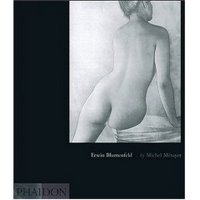
Yorick Blumenfeld has something interesting to say about Edward Weston:
Whatever desires may have been aroused by taking nude pictures were according to Blummenfeld 'sublimated by the lens.' Unlike other contemporary photographers, such as Edward Weston, he rarely focused his camera on the women he loved. He never used his wife, for example, as a nude model.
Of late I have been processing Agfa 400 ISO film after having exposed it to my studio's window lighting and getting blotchy negatives. I have been using the "wrong" developer to get results (the pictures look like they were taken in the 1920s) that Weston would have gone crazy to eliminate or correct. I have revelled in the use of this window lighting that I have so ignored in my years with my American-made, efficient and ever consistent Dynalites. Above you see pictures of two of my former studio muses, both photographed with window lighting. The first is Ona Grauer and the second is Yuliya Kam'yanska who really has the presence of the passionate Latin even though she is from Ukraine.
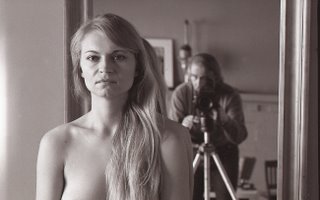
I have a new subject, Jo-Ann (left) who has indicated she will brave the outdoor metal stairs that hug the wall to my studio roof. It is not a Mexican azotea. But come the warm days of summer, it just might do!
¡Hay tiempo! There is time!

In all the various articles in the Vancouver media of the demise of the CBC Radio Orchestra in September none mention that our nation's orchestra was never Canada's but our very own Vancouver's. When it was first founded by Ira Dilworth in 1938 it was the CBC Vancouver Chamber Orchestra. In 1980 it became the CBC Vancouver Orchestra. Toronto took possesion only in 2000 when it acquired its present name the CBC Radio Orchestra.
In the 60s I used to listen to Willis Conover's jazz program in Voice of America. From Mexico City I was able to find the station in short wave. Conover familiarized me with cool jazz, the Westcoast California brand of jazz and performers such as Gerry Mulligan, Les McCann and many others. These were unavailable in Mexico City record stores. I was not aware that I was listening to propaganda.
I now love my Canada with its billboard-free highways. But we have more to offer to the world than that. Consider just Vancouver. My daughter Ale returned from Mexico City, not too long ago with a Mexico City Sunday paper. I noted that it had two pages of dance venues, two for theater and the same for classical music. This was astounding until I noticed the music was a surefire 19th century repertoire, the plays (the best of them) were Travels With My Aunt and the worst glorified soap operas. Dance was a legion of dancing swans. There was no experimental music or theatre or modern dance. There was nothing that cannot be found on any given day in our own "struggling world-class" city with its rich modern and classical dance culture, just penned experimental plays and new music concerts or concerts of the lesser known fantastic period of the 17th century, and a new music scene that struggles but still surprises.
Last night I attended a concert of the Pacific Baroque Orchestra with my daughter Hilary and her two daughters, Rebecca and Lauren. This was a reduced orchestra (the normal one is bigger) of a violin, viola, viola da gamba (or cello), violon and fortepiano. Even the PBO knows of troubled times and often performs in a "pocket orchestra" form. Many national orchestras are beginning to do the same. They spread the work around.
In the 50 and 60s I drew enough maps of Africa using a red pencil to mark the borders of the British properties, protectorates and colonies to learn that the world was being swallowed up into empires. I thought that nationalism was dead and we would soon become one happy capitalist conglomerate nation. I was wrong and so were the experts. Nationalism is alive and well and the concept is spreading.
I was talking to a CBC producer friend. I asked him, "Why didn't the CBC Radio Orchestra travel to the north of Canada to promote its brand of music?" I was astounded when he answered, "They went in September." All the good things that this Vancouver-based orchestra has done to spread culture in Canada has been unreported. That emminent and cultured American Senator, the late Daniel Patrick Moynihan would only smile.
When I wrote about the CBC Radio Orchestra here Bernardi had not yet stepped down (to be replaced by trombonist Alain Trudel, in itself an unique Canadian concept). I did not mention that the patrician conductor, John Eliot Gardiner avoids mentioning his stay in Vancouver in his lofty curriuculum vitae. Benign neglect must have been in full force by then. I state my fears that the CBC Radio Orchestra is one of the last bastions for the performance and (very important) recording of works by Canadian contemporary composers.
All the above and specifically my mentioning Wilis Conover and the Voice of America is patent evidence that the CBC Vancouver Orchestra (as I will always remember it) was a potential Canadian cultural gift to the world that was never used to its true potential. Can you imagine the columns of copy that would have been generated by :
Canadian Cultural Icon Plays To Its Troops in Afghanistan
Or:
Canadian Orchestra Plays In The West Bank.
Our much lauded but strained concept that Canada is a peace keeping nation would be far better promoted with cultural contributions to the world with our music, theater, dance and visual arts. A cultural peace corps of sorts under the umbrella of the CBC would promote our way of life to the world. Unfortunately the concept of culture in the modern CBC is to announce and promote, ad nauseum, the name of Jian Ghomeshi. A one-man-orchestra is cheaper.

Also not generally known nor have they ever been acknowledged is how CBC producers George Laverock and Karen Wilson (in other countries they would have been a legion, not two) and the CBC Radio Orchestra put together wonderful concerts, recorded for the radio and on CDs between 1979 and 1989. I can remember the gaunt and over-worked faces of those two (Laverock and Wilson) who with the help of virtuoso recording engineers like Don Harder made music that dazzled Europe. I know that Harder was often wooed by European recording companies and we all know how happy Cecilia Bartoli is when Mario Bernardi is present in her performances.
In the pictures here that's conductor Mario Bernardi and violinist Corey Cerovsek in rehearsal in the CBC's Studio One.
An Evening In Lillooet - An Afternoon At Vandusen - A Pleasant Routine
Friday, March 28, 2008

There's nothing more comforting for us, specially for Lauren and for Rebecca, than routine. An evening in Lillooet, an afternoon at VanDusen. The seasons change both locations but the places somehow seem the same in a comforting way. The mountains may have snow or not, but they are always there in the same spot. In VanDusen Lauren and Rebecca like to take the same paths. The like to go to the maze or look for turtles having a siesta on the rocks.

Rain or shine, summer or winter, VanDusen is always a delight for them. Lillooet promises the adventure of "camping out", of strange insects or the possible sighting of a bear. Lillooet is getting there. "How long before we get to Lytton?" Rebecca might say or Lauren will count the tunnels. Are there 7 or 8? We always forget. But we like the Alexandra Tunnel as it is almost the longest one.

Lillooet is fire. Ale slashes and burns the grass. She burns the dead wood that falls from the willows. She makes fires for marshmallows. I fire up the small gas Webber for the ham stakes or the meat tacos. Ale chops wood for the wood stove that heats the living room as we sit to watch a DVD film.

We know that the red rhodo at VanDusen would not survive the intense desert cold or the scorching heat of Lillooet. But Lillooet is our experiment. We divide up our plants to see which will slowly (as we think most plants do) adapt to a new climate. We have been taking clumps of Miscanthus sinensis 'Gracillimus" and the smaller 'Yaku Jima'. We think this ornamental grass might survive. I have given Ale some old roses with Japanese Rugosa parentage. They will surely be hardy.

At Ale's you can see forever which is exactly as far as the mountains on both sides of the canyon. When we return to Vancouver it is odd to look out on our garden. The smaller scale plays tricks and it is almost unnerving.

In going to Lillooet I pass the ghosts of my memory. A biker bash in Boston Bar, a night drive to the Charles Hotel (also in Boston Bar) in my blue Fiat X-19 with Les to exorcise daemons with the help of Lou Reed. Taking pictures of elite Canadian Pacific scalers near Lytton. They induced small landslides to prevent big ones from destroying track and rail equipment. Walking through Spences Bridge one afternoon with Mac Parry. I have forgotten why we went and why we did it. I do remember Mac saying, "I want to show you something neat." Mac had a way of pronouncing neat in a special way.
Some day Lauren and Rebecca will have their own memory ghosts to pass on their way to Lillooet. And they might even decide on exactly how many of those tunnels there are.
Un Pan De Dios
Thursday, March 27, 2008

Riding the B-Line bus on Broadway to teach my class at Focalpoint on 10th Avenue I was startled by the sign Transilvania Peasant Bread near Collingwood. I decided that one day I would stop and have a look. I wanted to know if the baker was Hungarian or Romanian. As Erdély, Transylvania was Hungarian until recent times. This area which means beyond the forest in Latin is now Romanian. Yesterday I finally satisfied my curiousity.
The pleasant baker that greeted me in the cozy brick oven store had mostly empty shelves with only five loaves of the Sprouted Wheat Bread to testify that I was indeed in a bakery. Florin Moldovan told me he was Romanian and the brochure he handed me stated that Transilvania (with an i and not with a y as the Romans did not have a y) Peasant Bread bakes only two other varieties besides the one I purchased. These are the Peasant Bread and a Light Rye Bread.
A woman arrived, an obvious steady client who was disappointed not to find her favourite Peasant Bread on the shelf. She bought the Sprouted Wheat Bread and told me I would like mine. This I did as I ate approximately one third of the still warm loaf on my way home.

The whole pleasant affair made me think of bread. It made me think of bread in my native language - Spanish. I realized that even though bread plays an important role in all cultures it plays an innordinate role in my Spanish language.
Consider the word for baker in Spanish is panadero. That means one who sells or bakes bread. In English your baker could bake pies beside bread, pan. We are more bread specific in Spanish! Since bread and water are obvious necessities for our survival the surname Pan y Agua (modernized to Paniagua) has been in existence since the 16th century. The surname originated in the province of León where it spread to Extremadura from whence it came to the New World in the ships of conquistadors like Cortez and Pizarro who were from Extremadura.
Un pan de dios, (literally bread from God) is not equivalent to manna from heaven. In Spanish it describes a kindly person who will do anything to help those in need. There are many more expressions in Spanish with pan in them. My favourite is pan comido (bread that has been eaten). It means that a particular activity or job is an easy job to accomplish. Easy as pie?
When we first came to Canada 37 years ago we missed the tasty Mexican bolillo similar to the Argentine flauta (flute) or what we would call French bread. When we lived in Arboledas I used to buy bolillo dough at a nearby bakery to make the best pizza ever. I never told Rosemary what makes the bolillos in some Mexican bakeries saltier than in others. They say that bakers, who sweat lots being near the hot ovens usually bake topless. Sweat runs down and they wipe it off with the dough they are kneading.
The only bread that had any kind of taste was a Safeway brand of Dutch Crunch Bread. Everything else tasted of cardboard to us. It tasted of that Mexican white bread called Bimbo.
Bimbo, pan Bimbo
¡Hay! Que re-rico
Es el pan Bimbo.
Now I would challenge anybody who would say that a good loaf of bread cannot be found in Vancouver. Rosemary particularly loves the Safeway brand of medias lunas or croissants. I favour the IGA pizza bagels.
And with my discovery of Transilvania Peasant Bread on 3474 West Broadway it has never been more evident.
In the evening when Rebecca and I went to Opera Sushi I was only able to have a miso soup. The bread had filled me. Taking Rebecca home, she asked, "Can you put the Dracula music?" I knew exactly what she meant. I turned on the CD player and we listened to Bach's Toccata in D minor for organ. That piece of organ music is as much the bread of life as Florin Moldovan's loaves.
Two Jorges- A Card Shark, A Deaf Card Reader & Alsatian Food
Wednesday, March 26, 2008

I first met Jorge Urréchaga in 1972. Both of us were teaching at a private high school for rich kids. Jorge was born in Cuba of Basque heritage and he and his family had moved to Mexico City during the Batista defeat by Fidel Castro. We had not spoken much at first. His English, while not perfect was precise and he taught English Literature. His Spanish was perfect and precise. We talked to each other in the formal usted. Instead of ¿Cómo estás? (How are you?) we said ¿Cómo está usted? which was stiffly formal. Until the last day we saw each other, when he came to Vancouver by bus from San Francisco in 1995 we used the usted. Just before Christmas on the first school year both Jorge and I (I am called Jorge Alejandro and Jorge always called me Jorge) had a boy from the Korean Embassy as a student. Jorge was given a bottle of Möet Chandon Champagne and I received a bottle of The Glenlivet Single Malt (the 18 year old one). We both eyed our bottles and without saying any words we exchanged them. The next morning a very terrible looking Jorge with deep bags told me, "No matter how much water I used to dilute that whiskey it was always strong! The colour was always dark." We became very good friends then.
By 1972 we were living in the outskirts of Mexico City in a neighbourhood called Arboledas. Jorge, who lived with his mother and younger sister (his father had died) would visit me in his souped up Ford Falcon. When I was in that car I was always terrified. He drove it as if he wanted to die. Jorge had a fine tenor voice and was a fan of opera. He would would stay late, even after Rosemary had gone up to bed. He would sing his favourite arias. Rosemary would have to close Ale's (our daughter was 4) room door. His favourite opera was Umberto Giordano's Andrea Chénier. I soon knew this opera very well. He also introduced me to Vivaldi's Gloria in D major. He brought the Vivaldi one day and convinced me to buy his Acoustic Research transistor amplifier and his Acoustic Research turntable. I would say that Jorge fine tuned my ears and taught me to appreciate music I was ignorant of.
One of the most interesting moments of our friendship happened one day when he called to tell me that we were going to see Andrea Chénier at Bellas Artes, the Mexico City opera house. A young Mexican tenor was singing the part. His name was Plácido Domingo. Because Domingo's mother sang in a review theatre, el Teatro Blanquita, Mexicans considered him a Mexican then and do so even now. We listened to the first act in a TV station technical van. Jorge had connections. We then went to a loading bay and Jorge knocked in a special way. The doors opened and we were whisked to an empty box. This was the media box which was always empty.
Jorge would call for other reasons. "Tell Rosemary that we are going to the horse races in the afternoon and we are dining in the evening." We would meet Jorge at the Hipódromo de las Américas. Jorge always chatted with a Jewish friend who owned a horse hair brush company. The would do this as the horsed paraded for the paddock inspection. It seems the man knew his horses. He knew his horses by the sheen of their coats. We would pass on most races and then Jorge would tell us to bet on a particular one. I was always cautious but we always won. With part of the money the three of us would then dine at our favourite restaurant, Sep's, which featured Alsatian food. I don't think I ever bought the Jewish horse hair expert know his horses and I suspected that Jorge knew a few of the jockey who probably threw races.
Another time Jorge called and said, "Tell your cousin Robby (he lived nearby) that we want to play some bridge." I told Jorge that Robby was an uncommonly good player. "Don't worry about it. If he asks just tell him we use the Schenken Convention." We of course won all night in spite of the fact that I have never been a good card player. I soon found out why Jorge won at bridge and at any other card game. No matter how perfect a set of cards was, within 15 minutes Jorge had every car memorized by the nicks or irregularities in the back. After 15 minutes our oponents could just as well have been playing with their cards facing the other way.
Jorge was into chess and he told me the history, play by play, of the world's most interesting players. He had a preference for a man called José Raúl Capablanca who happened to be a Cuban diplomat. From Jorge I found out all the ways chess masters cheated and how they bullied their oponents into making mistakes. I felt I knew both Bobby Fischer and Boris Spassky intimately. But then I also knew all about Maria Callas and Alfredo di Stéfano.
But the most unnerving calls were the ones were Jorge asked, "Is your mother deaf?" My mother lived with us and she suffered Meniere's which made her very deaf and very dizzy on some days. When that happened Jorge would come and my mother would read his cards. My mother, according to Jorge, was extremly good at it when she was deaf.
A month before my mother died she read her own cards at a function at the Filipino Embassy. She was reading her cards in the presence of the Cultural Attaché who was also good at card reading. We called her "la bruja", the witch. Something happened (I was there) because there was a sudden silence. We all asked but neither my mother or the Attaché made any comments. After my mother died the Attaché called to tell me that my mother had dealt herself the Queen of Spades and she knew she was going to die.
My mother was very deaf the one last day that Jorge came to visit us. She read his cards and told him he would be flying to Europe soon with a friend who was not good for him and that an accident would happen.
Jorge went to Europe without telling me who his friend was. A couple of months later he called from Rome. "I have to return home now." On the spur of the moment I said, "Did you run over some old lady?" There was silence and Jorge asked, "How did you know? I have to leave town or I will be put in jail.She just stepped from the curb. There was nothing I could do."
Once Jorge returned I was walking in the Zona Rosa in Mexico City when I spotted him wearing a black leather jacket as he emerged from his Falcon with a young man (perhaps a boy). It was then that I realized that Jorge was gay and being gay in macho Mexico was not easy. I kept this to myself and I never asked.
Shortly before we came to Vancouver Jorge called me. We met at a cafe and he told me this story.
When I was in my teens I joined the Cuban Communist Party. It was the fashionable thing to do. I soon lost interest and gave it up. Recently I went to Houston for a nose operation. I had a blockage that prevented me from singing to my best potential. When I entered the US I was asked if I had ever been a member of the Communist party. I knew that if I was affirmative they would have prevented me from entering. So I told them no. The operation was successful and when I returned home my mother gave me a letter that had arrived from the US Government. I was banned for life for ever entering the US. When I returned from Rome after that accident my direct flight to Mexico City was diverted to Miami becaused of engine trouble. As soon as the plane landed two FBI agents met at my seat and took me to a room where they strip searched me and then put me on the first plane out which happened to be to Paris. I had many problems securing enough funds to fly back to Mexico City.
In 1995 Jorge called me, out of the blue. He was in Vancouver to visit a friend and he wanted to see me. I picked him up at the Greyhound Bus Station and he proceded to tell me that he was gay, that he was married to a man and that he lived in San Francisco. He told me had AIDS and that he was alive because of a potent cocktail that he took every day. He had dinner at home and with Rosemary we reminisced about the horse races and dining at Sep's. I looked at Jorge's gaunt and sad face and I knew I would never see him again. He gave me his phone number in San Francisco. By the time I remembered to call the line had been disconnected.
To me Jorge had a little of Byron in him. He was neither good nor bad. He was a complex mixture. He was a faithful friend who introduced me to opera. I respected him for never taking advantage of his talent for cards or for winning horse races to become very rich. He seemed to have in check that ambition all of us have for power and wealth. I think he was a bit of a hood. We all need to know a hood. It makes our life that much more interesting, that much more understandable.
If there was one tragedy in our friendship it is that I never thought to take his picture. The closest I ever got was this snap of our new arctic blue VW which according to Rosemary's (that's Rosemary in the back seat with Ale, an baby Hilary in the front) I took it near the Etchegaray post office were we kept a postal box. That's Jorge's back in the front.
Yumi Eto's Grand Fashion Sense, Mine - Not & Doug Coupland Lends A Hand
Tuesday, March 25, 2008
Since I was a little boy I often heard my mother tell me, "Hay poca gente fina como nosotros." This sort of meant, "There are few people around with our bearing, good sense, taste and manners."

For the spring issue, 2000, of Nuvo Magazine (a magazine for which I worked for short while) I was assigned to photograph an emerging Vancouver fashion designer called Yumi Eto. Because this magazine had foresight (it is now standard editorial procedure) they arranged for me to photograph Miss Eto at a small Vancouver boutique hotel called Le Soleil on Hornby Street. It was not that she ever stayed there but the art director told me it would look good in the photo credit department.
I have never really had much of desire to dress fashionably although I have had my moments. Back in the early 50s in Buenos Aires I was extremely ashamed of my Argentine jeans when my fellow American students at the American School wore Lees, Levis and Wranglers. I could not explain to my mother that all jeans were the same. I remember nagging her until she bought me a pair of black high top Pirelli tennis shoes. We called them tennis shoes then. And in Rosita, Northern Mexico I could never make my Lees look quite like Sammy Simpson's.
In the late 50s I discovered the button-down shirt and black cordovan loafers. I have never lost my love affair with former and I have long lost interest in expensive shoes. In the late 80s I went to New York City and went directly to Brooks Brothers to buy a blue Oxford button-down shirt. When it got time to pay, my American Express Card was rejected and I was most embarrased when the man behind the till (he looked and sounded like a failed Holywood British actor) said, "There seems to be a problem, sir, with your plastic." The problem was resolved to my satisfaction when I called up the folks at American Express but somehow the shine was off in wanting to be fashionable.
I now have no fashion drive or sense. I buy blue and black jeans at Mark's Wear Warehouse. Of late I have been indulging in the stretch variety of blue jeans. They would have been anathema a couple of years ago. I buy my black oxford shoes at Mark's, too. Every couple of years I get some dark blue and black mock turtle neck long sleeved cotton shirts. I used to wear all kinds of T-shirts (my collection hovered around 75) but now I will either wear pictures of my granddaughters on white T-shirts or black or blue plain T-shirts (from Mark's). I buy my boxer shorts at Simpson Sears.
While I insist in writing here that I was never crazy about fashion, my daughters never fail to remind me how I used to carefully dress before going to a punk concert at the Smiling Buddha. I wore tight black jeans, black Big John slip on low cut boots, a black T-shirt and a black leather jacket. The whole package failed on the spot as soon as I pulled out an Irish Peterson pipe (in a stle called Canadian) and filled it with Balkan Sobranie tobacco and lit up.

Vancouver Magazine dispatched me to photograph another fashion designer in the late 80s called Katherine Regehr, (right). A young Doug Coupland, (below, left) insisted in coming as he said he would help me style the photo. He did and my photo looked grand.

Even though I have no desire to be fashionable I remember some of the nice things that did happen thanks to the fact that through my work with magazines I had to at least know something about fashion. Recently after a successful shoot, a red haired woman with many freckles brought me white roses. It made me remember only one other occasion when something similar happened.
Yumi Eto was so pleased with her portrait that she sent me white roses.
"Camping Out" In Lillooet - Lauren Smiles, Rebecca Doesn't
Monday, March 24, 2008

As a boy in Buenos Aires my parents used to send me to the camp. Camp, was word the British living in Argentina had borrowed directly from the Spanish campo as in campo abierto or open country. Right after the Christmas season, when Buenos Aires was its most sweltering, I was sent to some place either in the province of Córdoba, La Pampa or Corrientes. I remember that the one in Córdoba was called Glen Rest and boys and girls from the British and American community in Buenos Aires were shipped there for a couple of weeks to rough it.
According to Rosemary going to Lillooet to visit Ale, our eldest daughter, with our granddaughters, Lauren and Rebecca, is just like camping. But this is a different camping from the one in BA. It is a rougher kind even though my daughter has ammenities that Glen Rest did not have, like central air conditioning. This is so even though the house is not quite one in my opinion and closer to a well appointed shack! Rosemary brings everything we might need, even our own large skillet frying pan so I can make the breakfast pancakes. Watching Ale slash and burn the grass on her property (with the accompanying smell) and her insistence in lighting a fire outside in the evening so that Lauren and Rebecca could cook marshmallows is what made it seem like we were camping. And very pleasant it was!

During our two-night stay over the Easter weekend Lauren and Rebecca planted daffodils and they went fishing but caught nothing. They quickly lost interest in flying a kite (I could barely keep it aloft as it seemed to have stall characteristics that made it suicidal) and it was finally "eaten" by one of Ale's fruit trees. I had to constantly cajole (or force) Rebecca from playing computer games. Lauren was much more willing to follow Ale around outside in the sunny but cold weather. And we cooked a lot, it seems.
I almost did not notice that when Ale's 96 year-old friend Margaret arrived, on Saturday evening, with her daughter Lenora for barbecued ham stakes, Rosemary's scalloped potatoes and Rebecca's salad that she (Margaret) noted that both girls had grown from last fall. Once they had gone we sat to watch the Ben Kingsley, Sissy Spacek and William Hurt version of children's author Natalie Babbitt's novel, Tuck Everlasting. Ale, who had not connected her TV to any cable or satellite dish since she arrived in Lillooet last July, had depended on a DVD player to watch movies. It had finally given up the ghost and we had arrived with a new player. I had carefully chosen Tuck Everlasting and the Walt Disney Treasure Island to give us some family amusement but with a challenge. It was interesting the that challenge happened even though both films were Walt Disney. We all noted that Robert Newton's Long John Silver was a full-fledged complex villain. He was neither all good nor all bad. In the end Silver escapes with the treasure. This was most un-Disney most un-Hollywood. Whe I saw the film in 1951 I was 9. I have a feeling that Rebecca understood the villain's very human behaviour much better than I ever did. In fact I am sure that I never caught on until this second time around.

Rebecca had already seen Tuck Everlasting about a gentle family who after drinking from a spring under an oak tree had all stayed the same age for 100 years and were "doomed" not to die. It was most un-childlike that Rebecca refused to tell us about the plot twists or the ending even when we asked!
But it was the never-aging family Tuck that shocked me into remembering how Margaret had noted that the children had grown. Earlier that day, in the morning I had told Rebecca to grab Lilly, her stuffed cat and to pose for me by a willow tree and under and apricot tree. It felt different. Indeed both Rebecca and Lauren had grown. Paradoxically Lauren who used to be very difficult and fussy (about what she ate, for example) was easygoing and happy, while Rebecca who had always been easygoing and happy was more morose and even became angry when Ale's internet stopped working.

I told her to think about being a child who was becoming a teenager who was currently caught in a bittersweet transition. She seemed to understand and looked at the camera sadly. But when Rebecca asked to take a picture of Lauren (Rebecca had to bring a milk box to stand on so she could look through my large camera) Lauren, the child that she is, saved the day with a pleasant smile.
In a scene in Tuck Everlasting Angus Tuck (William Hurt) takes out Winnie Foster (Alexis Bledel) out in a rowboat to try to explain his and his family's fate. He explains, "We're like rocks stuck a the side of the stream," as all around them leaves rattle in the wind and autumn approaches. I must take Tuck's advice and glory at my own mortality (unlike his immortality) and enjoy every instant as my granddaughters grow up and change.
El Huevo De Colón - Columbus's Egg
Sunday, March 23, 2008

My on line dictionary of the Spanish language the RAE (Real Academia Española) defines el huevo de Colón or Columbus's egg:
huevo ~ de Colón.
1. m. Cosa que aparenta tener mucha dificultad pero resulta ser fácil al conocer su artificio.
This translates as: That which appears to be very difficult but is easy once the trick is known.
Venetian Girolamo Benzoni in his History of the New World wrote that when Columbus returned from his trip to the New World and sat down with nobles of the Spanish court they tried to diminish his accomplishment telling him that sooner or later some other Spaniard would have discovered it if he (Columbus) had not. Spaniards were so enterprising, the nobles said, that it would have been inevitable. Columbus asked a servant to bring an egg and he dared the nobles to stand it up without any help. The egg went around and no enterprising Spaniard was able to accomplish the feat. Columbus gently tapped the bottom of the egg (he dented it without breaking it) and it stood with no help. The nobles then understood the point that Columbus was trying to make - someone had to be first. To this day we say in Spanish that Columbus was the first man to make and egg stand. Most think this story as apocryphal but it sits well with most of Latin America and Spain where Columbus is still seen with some reverence.
In fact there is a monument to the discovery of America by Columbus in the shape of an egg in Sant Antoni de Portmany, Ibiza, Spain. Inside the hole there is a stylized model of one of Columbus's caravels.

And there is a lesser known one in Seville.

Eggs are very important to Latin Americans. I will never forget seeing an early Mexican talk show on TV in the late 60s. Some comedian was asked what he put on his eggs in the morning. Since eggs are testicles to us, his answer brought down the house, "Talcum powdder, madam." A huevo or testicle is also called a cojón and the expression ,"Me importa un huevo," (or cojón) means, "I don't give a damn." Cartagena-born author Arturo Perez Reverte has written a very funny essay on the subject. Part of it is referenced here.
But the funniest story on Columbus's egg is a Catalonian song by the group La Trinca.
EL HUEVO DE COLON
En toda la historia sin discusión
no hay un huevo mas famoso que el de Colón,
Se hizo amigo de la reina
por medios muy singulares
haciéndole con un huevo
unos juegos malabares
Y le dijo: "isabelita,
a ver si me dáis un barco
que quiero echar un vistazo
al otro lado del charco".
La reina se convenció
no se sabe cómo fué
si no fue por lo del huevo
¡vete a saber porqué!
Y embarcó con los Pinzones
que eran unos marineros
y estuvieron en remojo
mas de tres meses enteros
Y cuando todos decían:
"Colón, ¡que te den morcilla!"
escucharon un calipso
"¡Ya estamos en las Antillas!"
Y feliz de estar en tierra
besó el suelo con unción
como hace el papa de Roma
cuando sale de excursión
y volvieron a España
y aquí se termina el cuento
que empezó como una coña
y acabó en descubrimiento.
Y se trajo de recuerdo
para la reina y el rey
cuatro indios con maracas
que cantaban "Siboney"
Y así gracias a Colón
hay tiendas de ultramarinos
tabaco, patatas, mulatas
y psiquiatras argentinos
y lo de la Madre patria
y los trescientos millones
corridos, guarachas, pachangas
y otros ritmos sabrosones
En toda la historia sin discusión
no hay un huevo más famoso
ni ques sea tan vistoso,
más glorioso, más garboso
más rumboso, más marchoso
que el de Colón.
Lletra i música: LA TRINCA
I will only translate this passage to give you an idea:
Y así gracias a Colón
Thanks to Columbus
hay tiendas de ultramarinos
there are grocery stores that sell products from the New World
tabaco, patatas, mulatas
tobbacco, potatoes, mulattas
y psiquiatras argentinos
and Argentine psychiatrists
y lo de la Madre patria
and that thing about the Mother country
y los trescientos millones
and the three hundred million
corridos, guarachas, pachangas
y otros ritmos sabrosones
and other really juicy rythms
Sábado De Gloria - Revisited - And A Pancake Breakfast Not Under The Peach Tree
Saturday, March 22, 2008
Today, Holy Saturday, Rosemary, Lauren, Rebecca and I are visiting our eldest daughter Ale in Lillooet. We will probably have had a pancake breakfast. "I want to have pancakes under the peach tree," Lauren told me on Thursday. I had to explain to her that weather will not permit us to indulge as we did last fall. Sábado de Gloria is such an uncertain day. Will He rise? I wrote the blog below for Saturday, April 7, 2007. Abraham Rogatnick and I are still friends. There will be little of Abraham this Easter. Two Chritsmases ago he gave me some very expensive and beautiful garden tools. I have used all except a small Japanese saw which I gave to Ale. She called a few days ago, "Thank Abraham for that wonderful knife, it is so useful." But it seems that I had forgotten that this is not my second Sabado de Gloria entry. There was another on Saturday, April 15, 2006!

As I sat in the front pew of St Helen's Anglican Church with Abraham Jedediah Rogatnick yesterday evening I had thoughts of my grandmother Lolita and how she directed the Good Friday activities at home in Buenos Aires when I was a boy.
I had called Abraham in the morning to tell him that an unusual version of Mozart's Requiem was being Performed at St Helen's. The Vancouver Voices Quartet and Vancouver Chamber Players were performing the Requiem with only four voices and accompanied by a string quartet.
Many if not most of the patrons seemed to be parishioners of St Helen's (named after Constantine the Great's saintly mother). And there we were, a Catholic and a Jew sitting there discussing how three of the four singers had faulty Latin diction.
Perhaps my grandmother would have been shocked at it all or perhaps her anti-semitic stance was only Spanish 19th century upbringing. On Good Fridays I was not allowed to turn on the radio and sometime around 3 pm we would kneel on the living room floor in our Coghlan home and she would take us through the stations of the cross in Latin. I distinctly remember her telling me how the evil Jews had crucified Him. When describing people's faces she would sometimes say, "She has the map of Jerusalem on her face." Or she would switch to her alternate, "He is one of Jesus' countrymen."
But she never ever uttered a critical word about my best friend who lived across the street on Melián 2779. He was Mario Hertzberg. He, Miguelito (I have long forgotten his Calabrian surname) and I were inseperable and we were known as the inglesito (the english boy) el tano (the Italian) and el judío (the Jew).
Mario had two brothers but he once showed me the photograph of a third who looked much the same as he did except he was fatter and wore glasses. "That was my older brother but he died at a place called Auschwitz."
At age 8 I did not have enough curiousity to pursue the subject any further.
One day Mario and I went to see a Tarzan movie at the Saturday series sponsored by our local Capuchin monks who were building a very large new church next door to the little community center and movie house. They charged us a token fee but we knew our money was going to a good cause. As we left after the show we were approached by a chubby Capucine who asked us our names. He asked me to what church I went to. When he questioned Mario, Mario replied, "I don't go to church I am a Jew." I will never forget the Capuchin's smile as he placed his hand on Mario's arm and told us, "We share the same God and that is what is important." I thought about that for the rest of the day but I never confronted my grandmother with what to me was a clear difference of opinion.
I lost track of Mario Hertzberg when I was 20 but when I am with Abraham, even though he is 85, I find in his warm companionship, traces of that boyhood friendship that I miss but that somehow have come back.
It is appropriate that I write of this today. In Spanish, we call today Sábado de Gloria . It is an important day in Catholic liturgy as Catholics meditate on Easter Sunday. Easter Sunday is the most important feast day of them all. If the Man does not come back from the grave tomorrow it is all words and nothing more.
In my own little way I discovered last night as Abraham and I heard the lyrics:
tuba mirum spagens sonum (the trumpet will send its wondrous sound)
of a friendship reborn.
La Azotea De Edward Weston
Friday, March 21, 2008

I have such a vivid memory about reading this article on Mexican photographer Manuel Alvarez Bravo on December 16, 1993 that I even remember it was a Thursday!
The idea that the 91 year-old man (he died when he was 100) would wake up every day and have a coffee, pan dulce and then go to his studio and photograph a female nude was astounding. What a routine he had! That he did it in a city without snow or cold, a city (as well as the mountains of the dry season) that is ochre (although Bravo's house was called the Blue House) brown, and red, colours that are inviting and not distancing like the greens, blues, cyans and grays of Vancouver gave me nostalgia for my youth in Mexico City. Reading Tim Golden's interview with Bravo I could imagine the smells of earth, water on sidewalks after a winter drought aguacero and the advent of the rainy season. I could imagine and remember the murals of Diego Rivera and paintings by Rufino Tamayo. But most of all I was grabbed by the last two paragraphs of the interview:
For many years, Mr. Alvarez Bravo used to summarize the philosophy of his method on a piece of paper tacked above the developing pans in his darkroom. "Hay tiempo," it read, "There is time."
When asked, he can't remember exactly what happened to the manifesto. He thinks it is back in the house, just up the crooked street from the blue wall of his studio. he isn't sure. But he smiles as he says this, and his meaning is obvious: there is no longer any need for such reminders.
It was around 1993 that I first read the Daybooks of Edward Weston with special emphasis on the first volume. 1 Mexico. But I skimmed through them without giving Weston's words much thought.

Of late I have given those words much thought and I have read them over and over. It was only a few years ago that I realized, that between 1962 and 1964, when I lived in an apartment on Avenida Tamaulipas in Mexico City, that I was but three blocks from Avenida Veracruz 42, corner with Durango. It was in this house that Edward Weston lived for a while in 1924 with some of his sons and his mistress the Italian photographer Tina Modotti. When Modotti was later expelled from Mexico for her communist views she sold one of Weston's 4x5 cameras to a young Manuel Alvarez Bravo. Weston had noticed Bravo's photographs and commented on his talent.
 Ona Grauer in my studio, (right)
Ona Grauer in my studio, (right)On a March 12, 1924 entry Weston writes:
From the negatives made of Tina lying nude on the azotea, (Weston's photograph from his azotea, above left)[a Mexican roof, complete with laundry hanging to dry next to large water tanks] one very excellent result which I have printed: it is among the best nudes I have done...
Or his entry for March 16. 5:30 [Morning or afternoon?] ...Some criticized my latest nude of Tina reclining on the azotea because of "incorrect drawing," but [Jean] Charlot did not mind it: he tells me that Picasso got his "inspiration" to use false perspective from amateur photographs. Diego [Diego Rivera] had another interesting note on Picasso, that he was never influenced or went to nature for inspiration, always to other "schools" of art.
And there is this torrid one, March 23, Sunday Evening:
After a day of loafing and napping, it is well to let the world slip by occasionally in indolent indifference. The twilight was spent in Tina's room and in her arms, for she had sent me a note by Elisa, "Eduardo: Por qué no viene aquí arriba? Es tan bella la luz a esta hora y yo estoy un poco triste. "Why not come up here? The light is beautiful at this hour and I am a little sad.
There is a certain inevitable sadness in the life of a much-sought-for, beautiful woman, one like Tina especially, who, not caring sufficiently for associates among her own sex, craves camaraderie and friendship from men as well as sex love.
There is one entry that mentions a very young and beautiful "starlet" called Dolores del Río. But my favourite is one that sunk in with all its loveliness of a father's affection for his sons, in this case Neil:
March 3. It so happened, Neil, that last night I dreamed of you. I held you on my lap, kissed your broad forehead, and you cuddled close, and asked for stories. We talked long together, of fierce fanged Aztec Gods, of white rabbits in clover fields - and we recalled days of long ago. How it used to be at bed time you would climb upon my back for a good night ride out under the tall black trees, waving farewell to Lady Moon, listening to the little pines whisper, or maybe, picking loquat blossoms fragrant in the night fog. Now you are there[California] and I am here, and perhaps you are so big a boy I could no longer ride you so. Well it came to pass that in my dream your dreamed too...All quiet now, only a distant mocking. I watched your sleeping face, as I looked down upon you, you became not only Neil, but the symbol for all in life of tender hopefulness. They will flout you, insult you, lynch you, but I will protect you, for I have masks that you shall wear, a horned and grinning devil, a sharp beaked bird, a ram in solemn mummery. I have them, I shall keep them for that hour when it must be you shall need them to hide behind and keep inviolate, untouched, the spark within which is yourself. They shall be my only legacy to you, carboard, painted masks, thicker than your thin skin...

Yuliya Kam'yanska in my studio (left)
As I read and re read Weston's diary and look at the icy cyan sky of the North Shore mountains I remember that I have a warm studio on Robson Street. It is either cold or very hot. There is no in between with that steam radiator. And I have my photographic assignations with some beautiful women who consent to my photography with no fixed purpose except to take pictures, to explore what they are and or what I think they are. I happily send them (after all this is the 21st century) digital contact sheets (of negatives scanned) and print up photographs that smell of fixer which almost smells of Mexico City earth.
I sometimes question my obsession with the undraped female form. Since I am unable to explain it all in brief here I decided to look for an answer in my copy of The Photographic Nudes of Erwin Blumenfeld. The book has Berlin-born Blumenfeld's exquisite and classy (tame by today's standards) and it is nicely written by his son Yorick. Of his father he writes:
Women were the truest of his many obsessions and photography was one way of capturing them, of possessing them. The art historian Joachim Gasquet has described how Cézanne symbolically seduced his nudes in his great canvases, stroking them with 'great coloured caresses'. Gasquet wrote: "Nude flesh made him giddy, he wanted to leap at his models; as soon as they came in he wanted to throw them, half undressed, onto a matress...He had found another wasy to adore those nudes...he bedded them in his paintings, tussled with them." To Gasquet's conjectures about Cézzane, I can only add my own about my father. I don't think that his sublimations were all that different, except that he used the intermediary of the lens instead of the brush. Certainly he placed all kinds of separating elements between himself and his models: veils, grids, glass plates, silks muslin sheets...all used effectively to increase distance, to introduce the element of mystery, to heighten the allure of eroticism.

Yorick Blumenfeld has something interesting to say about Edward Weston:
Whatever desires may have been aroused by taking nude pictures were according to Blummenfeld 'sublimated by the lens.' Unlike other contemporary photographers, such as Edward Weston, he rarely focused his camera on the women he loved. He never used his wife, for example, as a nude model.
Of late I have been processing Agfa 400 ISO film after having exposed it to my studio's window lighting and getting blotchy negatives. I have been using the "wrong" developer to get results (the pictures look like they were taken in the 1920s) that Weston would have gone crazy to eliminate or correct. I have revelled in the use of this window lighting that I have so ignored in my years with my American-made, efficient and ever consistent Dynalites. Above you see pictures of two of my former studio muses, both photographed with window lighting. The first is Ona Grauer and the second is Yuliya Kam'yanska who really has the presence of the passionate Latin even though she is from Ukraine.

I have a new subject, Jo-Ann (left) who has indicated she will brave the outdoor metal stairs that hug the wall to my studio roof. It is not a Mexican azotea. But come the warm days of summer, it just might do!
¡Hay tiempo! There is time!
Thursday, March 20, 2008
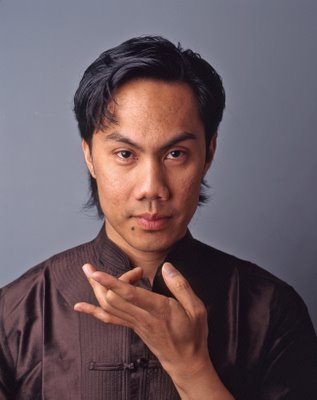
I photographed modern dancer Alvin Erasga Tolentino many years ago and he was but the background to a photograph of Grant Strate and Kathryn Ricketts here. But I finally got to photograph this talented dancer all by himself last Sunday for the Georgia Straight. I have a particular kinship to Tolentino because of his Filipino heritage which is something I share. My mother was born in Manila. I am familiar with the language, the food, the customs and I have long enjoyed watching Filipino folkloric dancers.
It has been exciting to watch those Filipino skills shine in modern dance. Tolentino has a particular talent of ending most dance either in a skirt or with nothing on! I had all the intention of getting him to take it all off and using light and shadow to hide the parts so that my photograph would meet the decency standards of the Straight. But Tolentino gently reminded me that his current work Paradis/Paradise is dedicated to one of his contributors Larisa Fayad who recently died in an accident in Asia. Something with an Asian connections was to be more appropriate and I agreed.
We took a few Polaroids and soon the picture (10 of them) were in the can. I remembered my grandmother who used to tell me, "There are no more graceful hands than the hands of a Filipino dancer." She was right.
Arthur C. Clarke 1917-2008
The theme of my blog on Friday, May 18, 2007 was precipitated by the near death of my Aunt Fermina in Houston (she subsequently died). It made me think of Arthur C. Clarke and my favourite novel of his Rendezvous With Rama. For most people he will always be remembered for his 1951 short story The Sentinel which subsequently led to a four-year collaboration with Stanley Kubrick and the novel and film 2001: A Space Odyssey. I read everything of Clarke that I could find in the 50s and 60s. I was thrilled at the idea of space and its conquest. But it was the 1973 Rendezvous With Rama which I read shortly before my mother's death that affected me perhaps more than any other book I have ever read. Below is that May 18, 2008 blog all over again. Reading of Clarke's death today in the newspaper brought to mind a passage in that other favourite novel of his, the 1954 Childhood's End:
...The ship was leaving the frontiers of the Solar System: the energies that powered the Stardrive were ebbing fast, but they had done their work.
Karellen raised his hand, and the picture changed once more. A single brilliant star glowed in the centre of the screen: no-one could have told, from this distance, that the Sun had ever possessed planets or that one of them had now been lost. For a long time Karellen stared back across that swiftly widening gulf, while many memories raced through his vast and labyrinthine mind. In silent farewell, he saluted the men he had known, whether they had hindered or helped him in his purpose.
No-one dared disturb him or interrupt his thoughts: and presently he turned his back upon the dwindling Sun.
Arthur C. Clarke, Childhood's End
The Ramans Do Everything In Threes
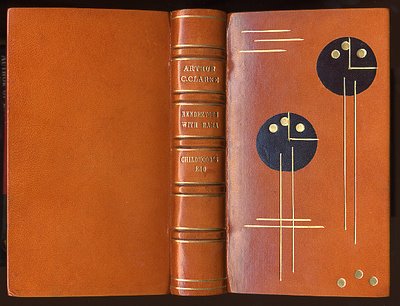
My Tía Fermina 95, lies very sick in a Houston hospital. She has a degenerated mitral valve in her heart that has precipitated a double pneumonia. She is too old for an operation and the medication to control the failed valve is not working. Her family called in the priest who gave her Communion and Extreme Unction. He jokingly told her that if she waited for another five years the statute of limitations on the sacrament (not true!) would enable him to return and give her the holy oils again. This seemed to perk her up and while she had had a doughnut for breakfast yesterday morning by lunch time she was demanding food from her favourite Vietnamese restaurant. Food with my aunt has always been the indicator of her health. It was on Wednesday that one of her daughters, Chayo had written to me, "Unfortunately since Thursday of last week she started sleeping a lot and not eating, not even chocolates!!!!"
I was able to talk to her yesterday. She was deaf so our conversation was one-sided. She floored me when she told me that we were in her prayers specially now.
It made me think of my mother who was nickanamed Sarah Bernhardt because she over-acted her health troubles. We thought she was hypochondriac. But in the late 50s she was diagnosed with Meniere's (I believe it is still incurable) which attacks the inner ears. It begins with loud buzzing sounds that destroy the body's balance mechanism so that one is constantly dizzy with with an ever present nausea. And you become deaf in spite, and because, of the loud ringing in the ears. By the late 60s my mother was in despair and she confessed to me that she was losing her faith in a God that interceded in human affairs. He was aloof and thus prayer had no value. I was hard-pressed to convince her that she was wrong.
The reason is that my loss of faith had been precipitated by Arthur C. Clarke's science fiction novel, A Rendezvous With Rama. A huge craft is detected approaching the solar system.
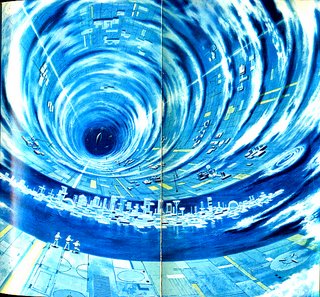
It parks outside and then approaches the Sun. Earthlings investigate the craft but find nothing of the would be pilots. They find out that the craft, on its way to somewhere else, has "gassed up" with hydrogen from our sun. We humans are no more important than a gnat. The novel left me with a feeling that may have been the same one felt by Europeans when Copernicus revealed to his world that the earth was not the centre of the universe and that the sun did not orbit the earth but the other way around. My mother showed no surprise when I told her of the book.
In the early 70s I had Rendezvous With Rama bound together with that other favourite Clarke novel Childhood's End. The French book binder Millioud had a shop in Mexico City and his work was legendary. He never scoffed at the idea of binding my cheap pocket books. When he returned this book he told me it was his interpretaion of Clarke's novel. It did not register on me at all and I just mentioned how lovely the cover was. It was only this morning that I caught on. Millioud must have at least read the last few sentences of Rendezvous:
And on far-off Earth, Dr. Carlisle Perera had as yet told no one of how he had wakened from a restless sleep with the message from his subconscious echoing in his brain:
The Ramans do everything in threes.
--------------------------------------------------------------------------------------------------------------------------------
Tía Fermina is better today and her daughter Carmencita is now worrying of the problem of finding an extended care facility for her. I warrant that the priest will not be called for another five years.
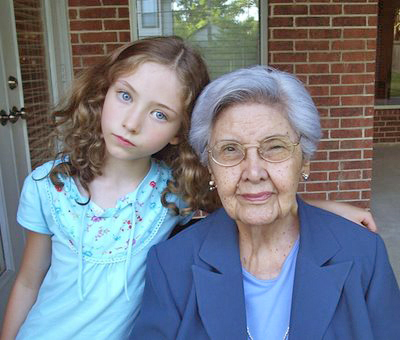
Here is Tia Fermina with Rebecca. I took this photograph last year when we visited her in Houston on our way back from Morelia. I think we need her to keep praying for us.
News Cycle
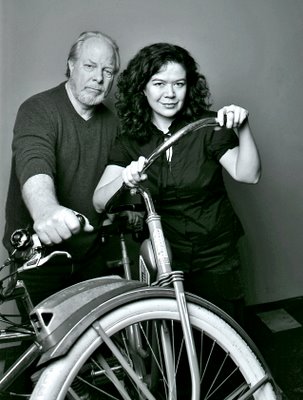
Margaret Gallagher, 41 is a contributor to CBC Radio Ones The Early Edition and as an arts reporter. Paul Grant, 59, is a CBC national arts reporter and host of the jazz program Hot Air. If you never have seen them but heard them, you would find their voices pleasant and welcoming (rare in radio today) and that they convey an interest and enthusiasm in what they do (rare, too).
Both ride to work. Gallagher is her 50s Firestone, which she calls The Rocket, and Grant in a $300 custom Chinese-made Bhodisattva ("seeker of enlightenment").
Before I first met Gallagher she told me, "Expect a short Chinese woman with lots of hair." While she denies being a dragon lady, she says, "I like strong women. I once had a catering company called Komodo House. Southeast Asian women are thought to be named dragon ladies after the Komodo dragon."
Grant, like Gallagher, is from that rare species who are Vancouver-born. With his brother and father (who was the Light Keeper) he lived in Point Atkinson in the 60s. "It was like living in a fishbowl. People would climb the cliffs and look into our lives. I can still remember the hurricane of 1962." His brother became an inspector for Agriculture Canada and Grant a producer and agriculture reporter in Prince Edward Island. Grant is not only an expert on potatoes but also on soft pretzels. He sold them from a wagon at MIT in Cambridge, Massachusetts.
When Gallagher was 11 she made a pretend hour-long radio show on her Radio Shack tape recorder from her bedroom on Chilliwack Mountain. Gallagher sings classical Indonesian music very well and is a passionate but not very good ice-hockey player. If you were to give Grant a Blindfold Test (as he gives his guests in the 61 year-old Hot Air program and then asks them to guess the performer) he would hope it would be the saxophonists Ben Webster and Campbell Ryga.
The above can be found as hard copy in the March, 2008 issue of VLM (Vancouver's Lifestyle Magazine). © 2008 VLM/Alex Waterhouse-Hayward
How we listen to Bach is a problem more of our own circumstances than of his. We must, for example, learn to accept the instrumental sounds of the eighteenth century: the small orchestra, the high trumpets, the Baroque organ, the harpsichord, the clavichord. Bach (late in his life, to be sure) knew the piano, but it does not follow that we may listen to his keyboard works exclusively on the piano; the special characteristics of the other keyboards are too intrinsically a part of his music. And we must scale down our hearing (our ears have been stretched by too much sound) to hear his music in proper sonic perspective.
James Goodfellow, Stereo Review, December 1971
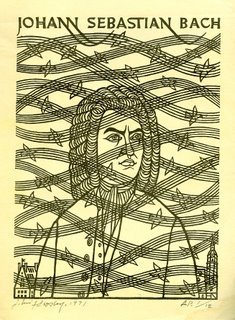
Sometime in the late 70s I read a short story in Penthouse Magazine in which an LA music honcho producer is able to bring, with the help of a time machine, composer Domenico Scarlatti into the 20th century. The whole idea is that the producer will then feature live concerts with the famous virtuoso harpsichordist and make a killing. To the producer's dismay Scarlatti soon tunes in and drops out from the "classical" scene and adopts the wonders of the Moog synthesizer and branches into heavy metal and forms a band.
While I never cut out the story and I have not been able to find it since, I did keep an article on Bach from the December 1971 Stereo Review Magazine. The writer of the fine article is the oddly named James Goodfriend, a musicologist of note at the time who has been almost swallowed into anonimity, courtesy of the Google algorithms which do not have much stuff "up" to find. It is as if the man never existed. The essay included the interesting woodcut by Jacques Hnizdovsky that you see here. Goodfriend was my first help in appreciating composers that seemed remote and difficult.
By 1970 I was convinced that Johann Sebastian Bach was God. My mother had convinced me of this. There must have been few opportunities for my mother to listen to Bach's music being played live. Her exposure to Bach came from being taught to play the piano as a small girl. Until a few weeks before she died she would sit at the piano to play Bach, Mozart, Beethoven and Brahms. Her opinion of Bach's genius must have come from her ability to read his music.
I don't seriously play any instrument. I abandoned the alto saxophone after I left high school. My ability to read music has faded away. But unlike my mother I have gone to many live concerts featuring Bach music and I have heard countless records and CDs and concerts on the radio. I would believe that I have heard more of Bach's works than my mother. This has helped me not dampen my enthusiasm for the man and his music. I have been attempting to transfer it to my granddaughter Rebecca.
Rebecca and I have listened to many many baroque concerts and I have made the mistake of thinking she knew a bit about Bach from simply going to them. I was entirely wrong. But it was not all a lost case. Recently I took her to the Vancouver East Cultural Centre to see theSatchmo Suite which features a cellist playing Bach's first suite for unaccompanied cello. A day before we went I played a Casals recording of the work. She was familiar with it when it was played live at the Vancouver East Cultural Centre performance.
A couple of weeks ago we watched a lively VHS film featuring a little boy and Handel set in Dublin. It is called Handel's Last Chance. The film was so popular not only with Rebecca but with her mother Hilary and my Rosemary. We sat this Saturday evening to watch Bach's Fight for Freedom which is part of the Composers' Specials distributed by Sony.
Ted Dykstra plays Johann Sebastian Bach, working at the court of Duke Wilhelm Ernst of Sachsen-Weimer. Before we even see Bach he is painted as a terrible monster and we were all ready for it. We were pleasantly surprised when Dykstra appears. He is young and handsome (and does not wear that wig all the time!) and soon not only charms the little boy who helps him escape the Duke's clutches but also charmed us.
As soon as the film finished Rebecca asked me, "Do you have any of his music?" I immediately put on one of the featured pieces from the film, Bach's Toccata & Fugue in d-minor for the organ. Rebecca was impressed and asked me, "Would Dracula have played that?" She then asked, "He was the composer who wrote those cello pieces we heard at the Cultch?"
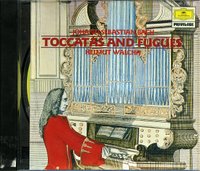
I now know more than ever how important association can be to learning and appreciating music. The film helped Rebecca connect the Satchmo Suite, Bach, Pablo Casals and the next time she accompanies me to a concert she will know a bit about the composer.
And both of us, thanks to Bach's Fight For Freedom will see the composer who loved life, loved his family (a picnic scene helped us understand this) with new eyes. The wood cut and the other pictures circulating of Bach don't help us appreciate him. But it is all not fun and games. Leonard Bernstein in my little music bible The Joy Of Music writes of Bach:
...For Bach, all music was religion; writing it was an act of faith; and performing it was an act of worship. Every note was dedicated to God and to nothing else. And this was true of all his music, no matter how secular its purpose. The six Brandenburg Concertos for orchestra were technically dedicated to the Margrave of Brandenburg, but the notes praised God, not the Margrave. Every last cello suite or violin sonata, every prelude and fugue from The Well Tempered Clavier praises God.
This is the spine of Bach's work: simple faith. Otherwise, how could he have ever turned out all that glorious stuff to order, meeting deadlines, and carrying on so many simultaneous activities? He played the organ, directed the choir, taught school, instructed his army of children, attended board meetings, kept his eye ot for better-paying jobs. Bach was a man, after all, not a god; but he was a man of God, and his godliness informs his music from first to last.
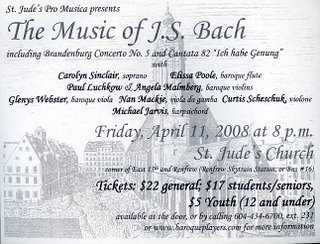
My mother would have agreed with the above even if I would have not considering that I thought Bach was God! For those who may be reading this I would suggest sampling Bach in an intimate surrounding - a church. The following all-Bach concert will be performed this April 11 at St Jude Catholic church on Renfrew. A couple of the performers are Paul Luchkow and Michael Jarvis. And there is Glenys Webster and Nan Mackie.
For many years even though the first ever version of the Brandenburg Concertos that I ever heard were some early long playing recordings by the Dutch Royal Concertgebouw Orchestra, my favourite has been a 60s recording, Pablo Casals - Marlboro Festival Orchestra - Bach Brandenburg Concertos. This recording directed by Casals is lively and spirited and it has a version of the No 2 Brandenburg played in quick time (the trumpet player must have clamoured for oxygen) as if there were no tomorrow. But the No 5 in D Major which features the flute, violin and keyboard is played, (alas!) with a piano. To be able to listen to Michael Jarvis on his harpsichord with a small orchestra in a church should be sublime.

Yesterday was a fine day with our granddaughters. Rebecca and I went to the Arts Club Theatre on Granville Island to see the play Derwent is Different. We both ate too many donuts and felt funny afterwards. But it was a specially good day with Lauren. Before we all went for a walk in VanDusen I read to her and we wrote some numbers. I taught Lauren to start her fives with the straight vertical line and then go to the almost closed circle and then to finish with the horizontal line. I had to explain to Rebecca that this is the efficient way as you are ready to go writing on the right hand side of the number.
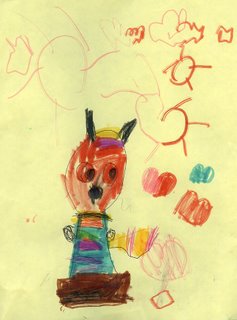
Lauren surprised me with a fine drawing of a cat. She brought the original and I was hit by nostalgia. The plush cat was a gift to Lauren's aunt, my daughter Ale, when she was around 5 which happens to be the same age as Lauren. Ale got the cat from her godfather, Yorkshire man, Andrew Taylor.
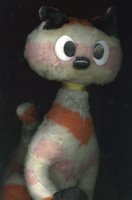
We have managed to stay in touch with Andrew and his wife Ilse since we left Mexico in 1975. In 2005 we saw them in Guanajuato, Mexico with Rebecca. In 2006 we visited Paricutin volcano in Michoacán. You can see Andrew here in what was left of the church after the birth and eruption of the volcano in the 40s.
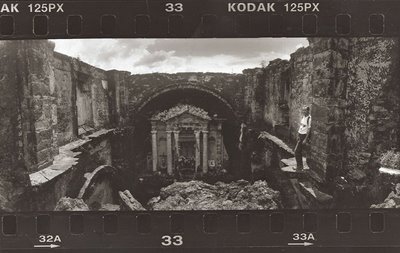
Perhaps we can all (with Lauren) visit the Taylors who live in Guadalajara soon. Ilse Taylor is an accomplished painter. Will she give Lauren, and Rebecca some lessons?
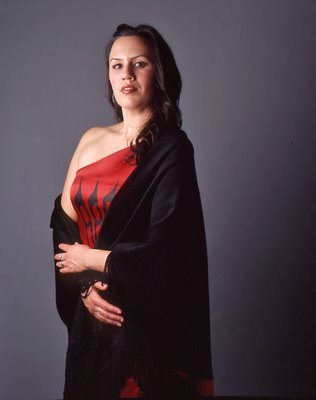
When my granddaughter Rebecca and I watched soprano Melody Mercredi sing at a recent performance of Bruce Reddell's and Bill Reid's The Spirit of Haida Gwaii we could not stop looking at her. Her clear voice and her red Dorothy Grant dress were a striking combination. She wore that dress when I interviewed her and photographed her in my studio in mid- February.
Port Hardy-born Mercredi knew she was going to be singer from the moment she learned to talk. "My mother had a beautiful sweet soprano voice and she played the organ at our church. I sang in the kids'choirs. But it wasn't until I was 14 when I watched Tom Hanks in Philadelphia that I knew I wanted to be an opera singer. I heard Maria Callas sing "La Mamma Morta" from Umberto Giordano's opera Andrea Chenier. It totally moved me. I had to sing like that someday."
Mercredi pursued her musical studies in Capilano College, UBC and the Vancouver Academy of Music. She has been the lead in the touring company of the Vancouver Opera's production of Mozart's The Magic Flute. "I sing Queen of the Night, the Second Lady and Papagena with the Vancouver Opera In School Program. I have entertained kids while being in those three different characters in schools all over BC including Haida Gwaii and the reserve at New Aiyansh."
In her ambition to one day sing Juliette in Charles Gounod's Romeo et Juliette Mercredi excecised all options. She will be in the chorus of the Vancouver Opera's forthcoming production of Beethoven's Fidelio(opens March 22 at the Queen Elizabeth Theatre). "I admire the principal singers, specially Richard Margison and Robyn Drideger-Klassen whith whom I went to school. For me to be on stage for any role is fullfilling. I love to be in costume. I can be someone else for two hours."
Mercredi's favourite food is cheese. "I am thin not only because of my family genes but because I run. I need to keep extending those long singing breaths in many of those arias. You have to be fit and have stamina to be an opera singer." At first her friends could not believe she was an opera singer. "They thougth I had to be large like Brünhilde to sing opera!"
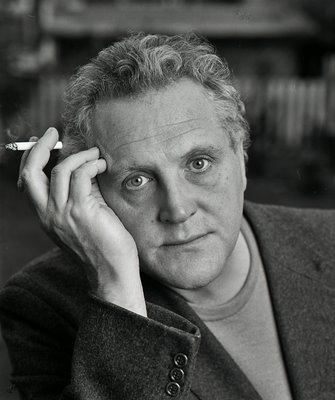
It doesn't seem all that long since I remember entering Duthie's on Robson and Celia Duthie asked me, "Have you read any Michael Dibdin? You should, you know." From there I would go to the Granville Book Company where someone was bound to ask, "Alex, have you read Dibdin?" I finally did and I even met and interviewed the author a few times.
I have read 6 (of 8) of Dibdin's "stand alone" novels and all 12 of his Aurelio Zen mysteries. The last one, End Games - The Last Aurelio Zen Mystery I read last night with a somehow special approach. How does one read a novel in which the author has recently died (1997) and where his main character, the sad Aurelio Zen has always been the author himself for me? I read it with a deep melancholy. I read it (slowly) as if I were sipping the last of a bottle of precious manzanilla from San Lucar de Barrameda. Certainly while I liked Dibdin and Zen I never did agree with their preference for grappa.
But what struck me the most and saddened me about End Games is a sense that Aurelio Zen almost feels a stranger in a world. With technology, an all prevailing event, from his vantage point in a small town in Calabria where he is temporarily replacing the police chief who shot himself in the foot Zen seems tired of it all. Not that the tiredness would ever prevent him from solving a complex crime where nobody can be pursuaded to talk.
After a pleasant sleep in a train to Rome Zen faces:
It was only when he was ejected from this sanctuary in the commuter rush hour at Rome that he realized to what extent he had become a provincial after just a few months in Calabria. He found it both physically difficult and emotionally repugnant to battle his way through the riptide of people coming at him from every direction, empty eyes trained like a gun on the personal zone immediately in front of them, attention absorbed by the loud songs or little voices in their heads, fingers fiddling with iPods and mobile phones, all oblivious of each other and their surroundings, marching relentlessly onwards like the ranks of the damned.
Then Zen says this of faxes:
I remember when we first got fax machines at work, Zen thought. They were cutting edge then, a status marker. If you didn't have one, you weren't important. Now they were virtually obsolete and sat gathering dust in some unvisited corner of the building. I've witnessed the birth and decay of an entire technology, he thought, not just in my lifetime but within recent memory.
I have a writer friend who says that thanks to the internet he can do all his reasearch from home. He has special (and expensive) permits to access such publications (from the 1880s) as the Globe & Mail and The New Yorker. He told me he no longer has to visit libraries. That contrasts with my knowledge that for many years Jonathan Raban and Michael Dibdin (both expatriots from the United Kingdom but Seattle residents) would meet to compare notes on what it was like to live in the foreign country of the United States. Both authors have a special talent for injecting authentic sounding conversation (the lingo, Raban would say) into the dialogue of their books. Their books are full of live content that comes from listening to people in real cafes, in the street and yes, perhaps even in libraries.
Two characters in End Games meet at a restaurant:
Jake and Martin met at SooChic, a Japanese-Peruvian fusion place with accents on the Deep South. The furnishings were 1950s Scandanavian, easy on the eye but hard on the ass. A waitperson showed up and dispensed some intense culinary talk therapy.
"So?" said Jake.
"Yeah,"said Martin.
I will never know exactly how well Dibdin adjusted to living in the 21st century but I find it appropriate (even if it is a loss to Aurelio Zen fans) that Zen has moved on to some heaven-in-the-sky for novel characters where he will live in comfortable silence, with the smell of the sea that one only gets while living in Venice and that he will never again have to be subjected to pasta with that New World monstrosity, the tomato.
A couple of days ago I found myself 75 cents short of $2.50 for the bus. I was returning home from shooting in my Robson Street studio. I got on the Granville trolley and put in $1.75 which is the rate for those 65 or over. I was 65 last August but a birth certificate mess up in Argentina has me officially almost a year younger. The driver did not even look at me and I picked up my transfer.
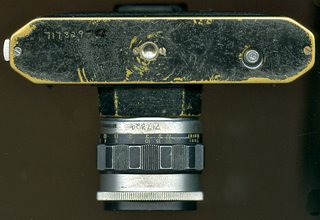
It all had to do with wanting more candy corn. I was 6 or 7 and my mother had a big bag of candy corn that she had obtained from a friend from the American Embassy in Buenos Aires. She would hand me a few that I would greedily eat in one blow. I noticed that she put the bag away in a drawer of her armoire in her bedroom of our house in Coghlan. One day when my mother was not around I went into the bedroom and opened the armoire and helped myself to the whole bag. The armoire had a mirror and I suddenly noticed myself in it. I stopped to look at myself and I think that for the first time I realized that I was an individual. I remember thinking , "Soy yo." (I'm me.) When my mother found out I received a sound spanking.
Now the time elapsed between seeing myself in that mirror with candy corn in my mouth and the arrival yesterday of my gold Care Card seems to be as fast as the flutter of a butterly wing and as compressed as a butterfly's existence. Can that be possible?

When we arrived in Vancouver within months I had lost my Social Insurance card. I have never bothered to get another one. The few times anybody has requested my SIN, I always ask them to wait. I tell that I have to find one of my cameras. In the late 70s many of us in Burnaby engraved our SIN number on our valuables. I engraved it on to my cameras. Here you can see the number (three digits have been Photoshopped out) on the bottom of my Pentax S3 as well as on the Takumar 55mm F-2 lens. For years I have used a torn Care Card that I repaired with transparent tape. It seemed like these cards weren't all that useful and could not even be used as an ID as they had no picture on them.
The impact of that Gold Card yesterday was very much like the one of the candy corn and the mirror. For a while I have equated my life with that of a slipping clutch. The Gold Card has made it that much more obvious. But there is one difference and that is the whole image of the senior that retires to golf or who might winter in Florida. Or the repellant image that I used to have of taking pictures of Canadian Pacific Limited executives who were given retirement roasts at the Terminal City Club. The roasts used to depress me to no end and only the frown in Rosemary's face (a frown that said, "We need the money. You need to take those pictures.") made me stick to the job. Powerful executives on one day were given on the next rocking chairs, gold watches, fishing rods and golf clubs. They were told to have a long and happy retirement. I never quite understood what that meant.
To me the Gold Card means that I must perhaps be more careful about falling. As a freelancer I cannot afford to be out of action for long. The Gold Card means I will be able to go to my beloved Pacific Baroque Orchestra and Early Music Vancouver concerts and pay a bit less for the pleasure.
But perhaps the most comforting aspect of my Gold Card is the sudden awareness that this is the last and only card I will ever need.
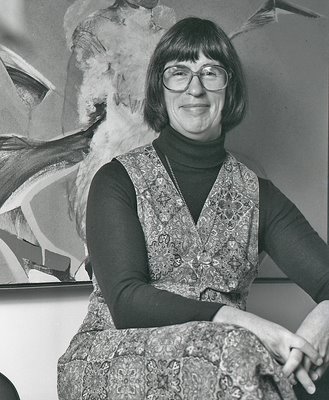
Next Friday Rosemary, Lauren, Rebecca and I will visit our daughter Ale in Lillooet. We will have to make the decision, the day before, as to which of the least dangerous highways we will travel to get there. The road between Pemberton and Lillooet is nicely banked but it is one continuous curve that is most dangerous in snow and ice. Plus we have to brave the nuts that will be driving to Whistler. The other option, the road between Lillooet and Lytton via Hope is very narrow, full of holes and huge rocks that come rumbling down from the side of the mountain. Often it is closed and then there is no way to get to Lillooet except by going back in some other way.
If you live in Lillooet and you don't own a car you cannot leave town unless you know someone else who is leaving in a car. There are no buses and there is no train. Lillooet has a very beautiful train station.
Sometime in the late 70s, Malcolm Parry, the editor of Vancouver Magazine dispatched me to photograph people he called movers and shakers of culture. One of them was a woman with an addictive smile who very definitely seemed to think we lived in the best of all possible worlds. I photographed her. She gave me a card and said, "How would you like to work for me?" I didn't answer her and promptly put the card in my wallet. In the beginning of the 80s my photographic fortune had its ups and downs, but mostly downs and I searched for Nini Baird's card.
For close to 13 years I worked ( on weekends, three or four times a year) as an artist teacher for Nini Baird's baby, The Outreach Program of Emily Carr College of Art as the institute was known then. Baird had explained to me that a portion of the provincial tax that every tax payer in British Columbia paid was a culture tax. Baird's mandate was to bring culture to those who lived in the interior who were definitely short-changed by the tax. Artist teachers went to remote areas to teach printmaking, painting, sculpture, photography and many more art techniques. The school even had a huge trailer truck that was a "portable" printmaking studio. I went to places like Cassiar, Uclulet, Atlin and all the forts. My students would invite me for dinner in order to squeeze me of more information. They were passionate and perhaps the most eager students I ever had in my life.
When Baird moved to other activities (including shaking up the Knowledge Network and pushing it forward) her Outreach baby died. Baird has worked behind the scenes promoting culture since. She may be one of the only American born women with an Order of Canada.
Every time I drive to Lillooet I think of the remoteness of the place and its dependance on TV and the internet. What do high school graduates do? To they stay? For what? Where do they go?
I had a well known ex BC politician in my studio last week and I asked him how it seemed that we were in a process of densification of our cities by simply ignoring the future of the interior communities. He said, "Towns have come and gone and this will always be a pattern." "There is not way of getting there unless you own a car." He countered this with, "Tour buses can get there."
As I think that those in the interior are still paying that culture tax and getting nothing (except for the accasional tour of the Vancouver Opera touring company or the Vancouver Symphony Orchestra) I feel a certain rage and I would almost want to rant here. This I will not do. But I would suggest that we need to get Nini Baird back to see the we all get our culture, plenty of it and with her smile. And we need more women like her and the Celia Duthies, and the Carole Taylors, to help us bring those interior communities back to the fold but not through this forced densification of Vancouver. We need to give the people of those communities a reason for staying.
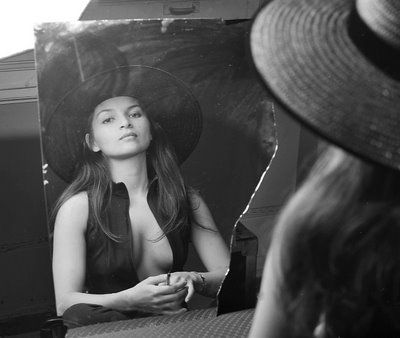
It is sometimes very difficult to be a Canadian. Four years ago I went to Buenos Aires with Rosemary and Rebecca and I was shocked to see large displays of women in small bikinis advertising tooth paste, soup, and housing developments. After years of indoctrination in Vancouver I could not understand the relevance of the female body to toothpaste. I tried to explain my concern to my cousins who simply laughed at me and said I was a fool. I further got into trouble by telling them that I was no longer turned on by women wearing highheels. In fact I felt sorry for them because of the possible pain and how it affects their posture and back. My cousin Georgito made the comment that perhaps Canada must be a boring place to live, after all, looking at an attractive woman selling toothpaste was a pleasant endeavour.
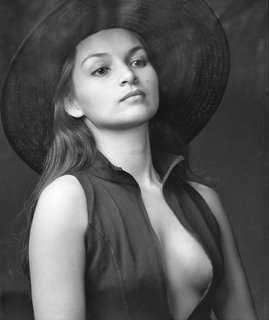
Georgito would very much approve of the subject of today's blog. It is cleavage. It is about Jo Drake's cleavage. She has great cleavage. But Georgito would have a problem as there is no real word for cleavage in Spanish. This is simply an elegant omission of the language in accepting that in actual fact we men adore something that does not exist. The word escote in Spanish means cut. A vestido escotado is a low cut dress. Sin escote suggests that a dress or sweater is al the way up to the neck. Sometimes an escote lindo refers to an attractive show of upper breast by a low cut dress. But we don't have an exact word for cleavage. Hendidura can mean the scoop or depression of space between something higher. Hendidura could mean cleavage but it is rarely used. My on line dictionary of the Spanish language the RAE (Real Academia Española) states:
hendidura.
(De hendido).
1. f. Corte en una superficie o en un cuerpo sólido cuando no llega a dividirlo del todo.
A cut in a surface or in a solid body when it (the cut) is not entirely divided.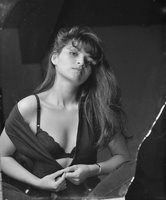
That seems to be a rather prosaic definition for something we all get so excited about!
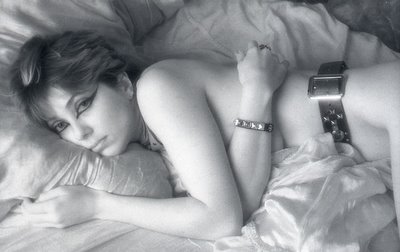
I have known Maddalena di Gregorio for 34 years. I have not seen her since she moved to Milan about 12 years ago. But we keep in touch via email. With my recent blogs on voluptuous Latin women and how I have almost been jealous when I read Edward Weston's Day Diary I have been thinking a lot about the Montreal born, Italian heritage Maddalena. I went into her files and found a treasure of photographs, some of which I can show here without offending potential youth who might accidentally discover this blog.
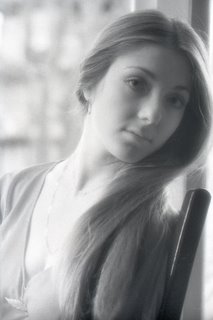
Maddalena first faced my camera in the late 70s when I was shooting photographs for Ron Langen's gay publication Bi-Line. Langen had the idea that I take two handsome young men and Maddalena to a forrest in Surrey in late November and photograph them nude as a trio in paradise before the fall of Adam.
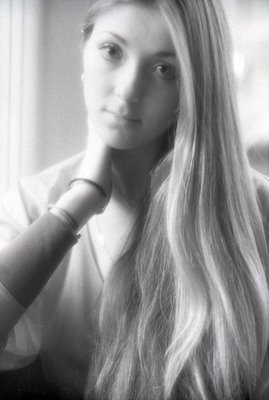
The story was about two Adams and one snake, Maddalena. My subjects kept warm with a bottle of brandy and the pictures were a success. The photograph of Maddalena from the rear is one of the pictures (but cropped!).

For the next shoot we added one more woman, my friend Inga Vollmer and shot it inside an old railway parlour car that I got from my friend Harry Atterton. He was a PR man for Air Canada who happened to own a few railway cars on the side.
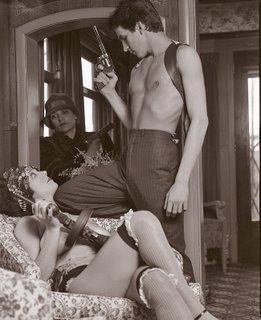
Through the years I photographed Maddalena lots. I would run into her at alternative band concerts at the Commodore and we would set dates to take pictures. With her and with the Reid sisters Virve and Julia I learned all I know now about the photography of the undraped female.
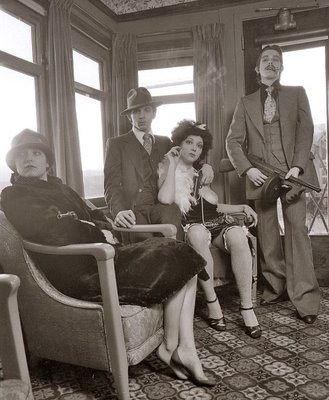
Unfortunately Maddalena left for Toronto about 16 or 17 years ago and the photography stopped. One year she came back and insisted I photograph the new hard bodied Maddalena wearing black lace gloves, etc. It wasn't exactly my cup of tea but I obliged. Maddalena never saw the results (the last three here are from that session) but with the ease of use that comes with a home scanner I am sure that today she will be looking at them from Milan.
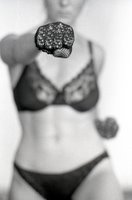
Looking at her pictures I can see that I could have done a series on Mary Magdalene. I could have photographed a contemporary Mona Lisa. And there is more.
My friend Jim Christy has always been interested in Catholic saints. He has an extensive collection of images and statues. One of his favourites is one of the Holy Family in which Saint Joseph uncharacteristically places his hand on the Virgin Mary's shoulder.
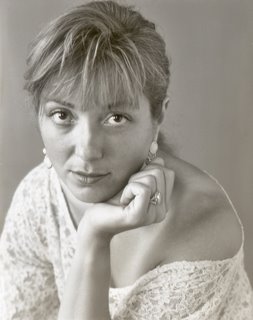
Until recently the idea that Joseph would touch Mary was strictly verboten. In the last few years I have taken a few ethnic Virgin Mary's (fully undraped). I have a Vietnamese, a Chilean and an Argentine Mary. But Maddalena's interpretation of the Virgin Mary would make Mary a real woman. A real woman which I have no doubt Mary was.
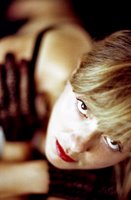
Addendum March 10, 2008
Dear Alex, you did get a smile out of me. Quite amusing the association to Monalisa, the Virgin Mary and the not so virgin Mary Magdalen.
A series on Mary Magdalen or Monalisa would have been right up my ally.
I have only been in Milan for 7 years, although it feels like a lifetime, but I imagine it's at least 12 years since we last ran into each other in Toronto.
Been a while since i stood in front of a camera except for some self portraits along the way. I have attached a couple of self portraits I took 2 years ago. A contemporary interpretation of Mary Magdalen..... and a penitent Mary Magdalen.
Thank you Alex.
Madda
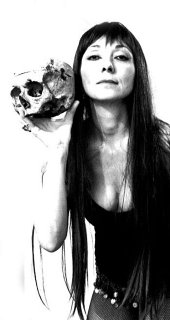
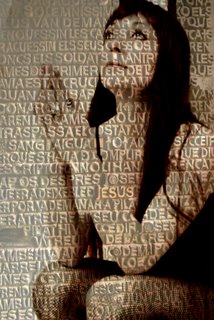
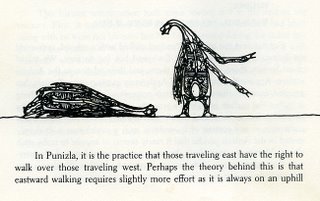
Last night I received a communication from A.K. Dewdney re my recent blog on a lecture I gave at the 2008 Northern Voice Conference at UBC. A.K. Dewdney writes:
Dear Alex,
You certainly have a point, but consider the plight of our Planiversal friends who find great (?) aesthetic fascination in one-dimensional images like this one:
....---.-..-..-----.- -..- -.- -...- -... .
the Mona Pizza (with apologies to Mr. Morse))
I don't think I have anything to add to your blog, except to say that the continual viewing of images on glowing screens has a debilitating effect on the brain, rendering it by degrees increasingly passive and decreasingly alert. The final stage is a form of benign idiocy.
All the best
Kee (Dewdney)
ps: The Dewdney Trail in BC commemorates Edgar Dewdney, one of the first governors-general of BC, I believe. My grandfather happened to take the same steamer to England with E. Dewdney back in the 20s. They could not find a common ancestor.
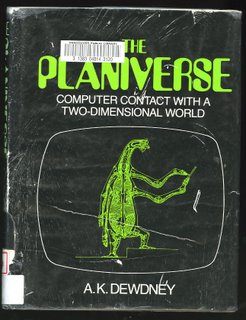
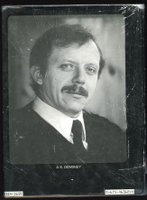

I photographed modern dancer Alvin Erasga Tolentino many years ago and he was but the background to a photograph of Grant Strate and Kathryn Ricketts here. But I finally got to photograph this talented dancer all by himself last Sunday for the Georgia Straight. I have a particular kinship to Tolentino because of his Filipino heritage which is something I share. My mother was born in Manila. I am familiar with the language, the food, the customs and I have long enjoyed watching Filipino folkloric dancers.
It has been exciting to watch those Filipino skills shine in modern dance. Tolentino has a particular talent of ending most dance either in a skirt or with nothing on! I had all the intention of getting him to take it all off and using light and shadow to hide the parts so that my photograph would meet the decency standards of the Straight. But Tolentino gently reminded me that his current work Paradis/Paradise is dedicated to one of his contributors Larisa Fayad who recently died in an accident in Asia. Something with an Asian connections was to be more appropriate and I agreed.
We took a few Polaroids and soon the picture (10 of them) were in the can. I remembered my grandmother who used to tell me, "There are no more graceful hands than the hands of a Filipino dancer." She was right.
The Ramans Do Everything In Threes - Revisited
Wednesday, March 19, 2008
Arthur C. Clarke 1917-2008
The theme of my blog on Friday, May 18, 2007 was precipitated by the near death of my Aunt Fermina in Houston (she subsequently died). It made me think of Arthur C. Clarke and my favourite novel of his Rendezvous With Rama. For most people he will always be remembered for his 1951 short story The Sentinel which subsequently led to a four-year collaboration with Stanley Kubrick and the novel and film 2001: A Space Odyssey. I read everything of Clarke that I could find in the 50s and 60s. I was thrilled at the idea of space and its conquest. But it was the 1973 Rendezvous With Rama which I read shortly before my mother's death that affected me perhaps more than any other book I have ever read. Below is that May 18, 2008 blog all over again. Reading of Clarke's death today in the newspaper brought to mind a passage in that other favourite novel of his, the 1954 Childhood's End:
...The ship was leaving the frontiers of the Solar System: the energies that powered the Stardrive were ebbing fast, but they had done their work.
Karellen raised his hand, and the picture changed once more. A single brilliant star glowed in the centre of the screen: no-one could have told, from this distance, that the Sun had ever possessed planets or that one of them had now been lost. For a long time Karellen stared back across that swiftly widening gulf, while many memories raced through his vast and labyrinthine mind. In silent farewell, he saluted the men he had known, whether they had hindered or helped him in his purpose.
No-one dared disturb him or interrupt his thoughts: and presently he turned his back upon the dwindling Sun.
Arthur C. Clarke, Childhood's End
The Ramans Do Everything In Threes

My Tía Fermina 95, lies very sick in a Houston hospital. She has a degenerated mitral valve in her heart that has precipitated a double pneumonia. She is too old for an operation and the medication to control the failed valve is not working. Her family called in the priest who gave her Communion and Extreme Unction. He jokingly told her that if she waited for another five years the statute of limitations on the sacrament (not true!) would enable him to return and give her the holy oils again. This seemed to perk her up and while she had had a doughnut for breakfast yesterday morning by lunch time she was demanding food from her favourite Vietnamese restaurant. Food with my aunt has always been the indicator of her health. It was on Wednesday that one of her daughters, Chayo had written to me, "Unfortunately since Thursday of last week she started sleeping a lot and not eating, not even chocolates!!!!"
I was able to talk to her yesterday. She was deaf so our conversation was one-sided. She floored me when she told me that we were in her prayers specially now.
It made me think of my mother who was nickanamed Sarah Bernhardt because she over-acted her health troubles. We thought she was hypochondriac. But in the late 50s she was diagnosed with Meniere's (I believe it is still incurable) which attacks the inner ears. It begins with loud buzzing sounds that destroy the body's balance mechanism so that one is constantly dizzy with with an ever present nausea. And you become deaf in spite, and because, of the loud ringing in the ears. By the late 60s my mother was in despair and she confessed to me that she was losing her faith in a God that interceded in human affairs. He was aloof and thus prayer had no value. I was hard-pressed to convince her that she was wrong.
The reason is that my loss of faith had been precipitated by Arthur C. Clarke's science fiction novel, A Rendezvous With Rama. A huge craft is detected approaching the solar system.

It parks outside and then approaches the Sun. Earthlings investigate the craft but find nothing of the would be pilots. They find out that the craft, on its way to somewhere else, has "gassed up" with hydrogen from our sun. We humans are no more important than a gnat. The novel left me with a feeling that may have been the same one felt by Europeans when Copernicus revealed to his world that the earth was not the centre of the universe and that the sun did not orbit the earth but the other way around. My mother showed no surprise when I told her of the book.
In the early 70s I had Rendezvous With Rama bound together with that other favourite Clarke novel Childhood's End. The French book binder Millioud had a shop in Mexico City and his work was legendary. He never scoffed at the idea of binding my cheap pocket books. When he returned this book he told me it was his interpretaion of Clarke's novel. It did not register on me at all and I just mentioned how lovely the cover was. It was only this morning that I caught on. Millioud must have at least read the last few sentences of Rendezvous:
And on far-off Earth, Dr. Carlisle Perera had as yet told no one of how he had wakened from a restless sleep with the message from his subconscious echoing in his brain:
The Ramans do everything in threes.
--------------------------------------------------------------------------------------------------------------------------------
Tía Fermina is better today and her daughter Carmencita is now worrying of the problem of finding an extended care facility for her. I warrant that the priest will not be called for another five years.

Here is Tia Fermina with Rebecca. I took this photograph last year when we visited her in Houston on our way back from Morelia. I think we need her to keep praying for us.
Paul Grant & Margaret Gallagher - For The Arts At The CBC
Tuesday, March 18, 2008
News Cycle

Margaret Gallagher, 41 is a contributor to CBC Radio Ones The Early Edition and as an arts reporter. Paul Grant, 59, is a CBC national arts reporter and host of the jazz program Hot Air. If you never have seen them but heard them, you would find their voices pleasant and welcoming (rare in radio today) and that they convey an interest and enthusiasm in what they do (rare, too).
Both ride to work. Gallagher is her 50s Firestone, which she calls The Rocket, and Grant in a $300 custom Chinese-made Bhodisattva ("seeker of enlightenment").
Before I first met Gallagher she told me, "Expect a short Chinese woman with lots of hair." While she denies being a dragon lady, she says, "I like strong women. I once had a catering company called Komodo House. Southeast Asian women are thought to be named dragon ladies after the Komodo dragon."
Grant, like Gallagher, is from that rare species who are Vancouver-born. With his brother and father (who was the Light Keeper) he lived in Point Atkinson in the 60s. "It was like living in a fishbowl. People would climb the cliffs and look into our lives. I can still remember the hurricane of 1962." His brother became an inspector for Agriculture Canada and Grant a producer and agriculture reporter in Prince Edward Island. Grant is not only an expert on potatoes but also on soft pretzels. He sold them from a wagon at MIT in Cambridge, Massachusetts.
When Gallagher was 11 she made a pretend hour-long radio show on her Radio Shack tape recorder from her bedroom on Chilliwack Mountain. Gallagher sings classical Indonesian music very well and is a passionate but not very good ice-hockey player. If you were to give Grant a Blindfold Test (as he gives his guests in the 61 year-old Hot Air program and then asks them to guess the performer) he would hope it would be the saxophonists Ben Webster and Campbell Ryga.
The above can be found as hard copy in the March, 2008 issue of VLM (Vancouver's Lifestyle Magazine). © 2008 VLM/Alex Waterhouse-Hayward
Bach, Bernstein, Dracula & A Goodfellow Persists
Monday, March 17, 2008
How we listen to Bach is a problem more of our own circumstances than of his. We must, for example, learn to accept the instrumental sounds of the eighteenth century: the small orchestra, the high trumpets, the Baroque organ, the harpsichord, the clavichord. Bach (late in his life, to be sure) knew the piano, but it does not follow that we may listen to his keyboard works exclusively on the piano; the special characteristics of the other keyboards are too intrinsically a part of his music. And we must scale down our hearing (our ears have been stretched by too much sound) to hear his music in proper sonic perspective.
James Goodfellow, Stereo Review, December 1971

Sometime in the late 70s I read a short story in Penthouse Magazine in which an LA music honcho producer is able to bring, with the help of a time machine, composer Domenico Scarlatti into the 20th century. The whole idea is that the producer will then feature live concerts with the famous virtuoso harpsichordist and make a killing. To the producer's dismay Scarlatti soon tunes in and drops out from the "classical" scene and adopts the wonders of the Moog synthesizer and branches into heavy metal and forms a band.
While I never cut out the story and I have not been able to find it since, I did keep an article on Bach from the December 1971 Stereo Review Magazine. The writer of the fine article is the oddly named James Goodfriend, a musicologist of note at the time who has been almost swallowed into anonimity, courtesy of the Google algorithms which do not have much stuff "up" to find. It is as if the man never existed. The essay included the interesting woodcut by Jacques Hnizdovsky that you see here. Goodfriend was my first help in appreciating composers that seemed remote and difficult.
By 1970 I was convinced that Johann Sebastian Bach was God. My mother had convinced me of this. There must have been few opportunities for my mother to listen to Bach's music being played live. Her exposure to Bach came from being taught to play the piano as a small girl. Until a few weeks before she died she would sit at the piano to play Bach, Mozart, Beethoven and Brahms. Her opinion of Bach's genius must have come from her ability to read his music.
I don't seriously play any instrument. I abandoned the alto saxophone after I left high school. My ability to read music has faded away. But unlike my mother I have gone to many live concerts featuring Bach music and I have heard countless records and CDs and concerts on the radio. I would believe that I have heard more of Bach's works than my mother. This has helped me not dampen my enthusiasm for the man and his music. I have been attempting to transfer it to my granddaughter Rebecca.
Rebecca and I have listened to many many baroque concerts and I have made the mistake of thinking she knew a bit about Bach from simply going to them. I was entirely wrong. But it was not all a lost case. Recently I took her to the Vancouver East Cultural Centre to see theSatchmo Suite which features a cellist playing Bach's first suite for unaccompanied cello. A day before we went I played a Casals recording of the work. She was familiar with it when it was played live at the Vancouver East Cultural Centre performance.
A couple of weeks ago we watched a lively VHS film featuring a little boy and Handel set in Dublin. It is called Handel's Last Chance. The film was so popular not only with Rebecca but with her mother Hilary and my Rosemary. We sat this Saturday evening to watch Bach's Fight for Freedom which is part of the Composers' Specials distributed by Sony.
Ted Dykstra plays Johann Sebastian Bach, working at the court of Duke Wilhelm Ernst of Sachsen-Weimer. Before we even see Bach he is painted as a terrible monster and we were all ready for it. We were pleasantly surprised when Dykstra appears. He is young and handsome (and does not wear that wig all the time!) and soon not only charms the little boy who helps him escape the Duke's clutches but also charmed us.
As soon as the film finished Rebecca asked me, "Do you have any of his music?" I immediately put on one of the featured pieces from the film, Bach's Toccata & Fugue in d-minor for the organ. Rebecca was impressed and asked me, "Would Dracula have played that?" She then asked, "He was the composer who wrote those cello pieces we heard at the Cultch?"

I now know more than ever how important association can be to learning and appreciating music. The film helped Rebecca connect the Satchmo Suite, Bach, Pablo Casals and the next time she accompanies me to a concert she will know a bit about the composer.
And both of us, thanks to Bach's Fight For Freedom will see the composer who loved life, loved his family (a picnic scene helped us understand this) with new eyes. The wood cut and the other pictures circulating of Bach don't help us appreciate him. But it is all not fun and games. Leonard Bernstein in my little music bible The Joy Of Music writes of Bach:
...For Bach, all music was religion; writing it was an act of faith; and performing it was an act of worship. Every note was dedicated to God and to nothing else. And this was true of all his music, no matter how secular its purpose. The six Brandenburg Concertos for orchestra were technically dedicated to the Margrave of Brandenburg, but the notes praised God, not the Margrave. Every last cello suite or violin sonata, every prelude and fugue from The Well Tempered Clavier praises God.
This is the spine of Bach's work: simple faith. Otherwise, how could he have ever turned out all that glorious stuff to order, meeting deadlines, and carrying on so many simultaneous activities? He played the organ, directed the choir, taught school, instructed his army of children, attended board meetings, kept his eye ot for better-paying jobs. Bach was a man, after all, not a god; but he was a man of God, and his godliness informs his music from first to last.

My mother would have agreed with the above even if I would have not considering that I thought Bach was God! For those who may be reading this I would suggest sampling Bach in an intimate surrounding - a church. The following all-Bach concert will be performed this April 11 at St Jude Catholic church on Renfrew. A couple of the performers are Paul Luchkow and Michael Jarvis. And there is Glenys Webster and Nan Mackie.
For many years even though the first ever version of the Brandenburg Concertos that I ever heard were some early long playing recordings by the Dutch Royal Concertgebouw Orchestra, my favourite has been a 60s recording, Pablo Casals - Marlboro Festival Orchestra - Bach Brandenburg Concertos. This recording directed by Casals is lively and spirited and it has a version of the No 2 Brandenburg played in quick time (the trumpet player must have clamoured for oxygen) as if there were no tomorrow. But the No 5 in D Major which features the flute, violin and keyboard is played, (alas!) with a piano. To be able to listen to Michael Jarvis on his harpsichord with a small orchestra in a church should be sublime.
Lauren & Papi Remembers Andrew's Cat
Sunday, March 16, 2008

Yesterday was a fine day with our granddaughters. Rebecca and I went to the Arts Club Theatre on Granville Island to see the play Derwent is Different. We both ate too many donuts and felt funny afterwards. But it was a specially good day with Lauren. Before we all went for a walk in VanDusen I read to her and we wrote some numbers. I taught Lauren to start her fives with the straight vertical line and then go to the almost closed circle and then to finish with the horizontal line. I had to explain to Rebecca that this is the efficient way as you are ready to go writing on the right hand side of the number.

Lauren surprised me with a fine drawing of a cat. She brought the original and I was hit by nostalgia. The plush cat was a gift to Lauren's aunt, my daughter Ale, when she was around 5 which happens to be the same age as Lauren. Ale got the cat from her godfather, Yorkshire man, Andrew Taylor.

We have managed to stay in touch with Andrew and his wife Ilse since we left Mexico in 1975. In 2005 we saw them in Guanajuato, Mexico with Rebecca. In 2006 we visited Paricutin volcano in Michoacán. You can see Andrew here in what was left of the church after the birth and eruption of the volcano in the 40s.

Perhaps we can all (with Lauren) visit the Taylors who live in Guadalajara soon. Ilse Taylor is an accomplished painter. Will she give Lauren, and Rebecca some lessons?
Melody Mercredi - Queen Of The Night
Saturday, March 15, 2008

When my granddaughter Rebecca and I watched soprano Melody Mercredi sing at a recent performance of Bruce Reddell's and Bill Reid's The Spirit of Haida Gwaii we could not stop looking at her. Her clear voice and her red Dorothy Grant dress were a striking combination. She wore that dress when I interviewed her and photographed her in my studio in mid- February.
Port Hardy-born Mercredi knew she was going to be singer from the moment she learned to talk. "My mother had a beautiful sweet soprano voice and she played the organ at our church. I sang in the kids'choirs. But it wasn't until I was 14 when I watched Tom Hanks in Philadelphia that I knew I wanted to be an opera singer. I heard Maria Callas sing "La Mamma Morta" from Umberto Giordano's opera Andrea Chenier. It totally moved me. I had to sing like that someday."
Mercredi pursued her musical studies in Capilano College, UBC and the Vancouver Academy of Music. She has been the lead in the touring company of the Vancouver Opera's production of Mozart's The Magic Flute. "I sing Queen of the Night, the Second Lady and Papagena with the Vancouver Opera In School Program. I have entertained kids while being in those three different characters in schools all over BC including Haida Gwaii and the reserve at New Aiyansh."
In her ambition to one day sing Juliette in Charles Gounod's Romeo et Juliette Mercredi excecised all options. She will be in the chorus of the Vancouver Opera's forthcoming production of Beethoven's Fidelio(opens March 22 at the Queen Elizabeth Theatre). "I admire the principal singers, specially Richard Margison and Robyn Drideger-Klassen whith whom I went to school. For me to be on stage for any role is fullfilling. I love to be in costume. I can be someone else for two hours."
Mercredi's favourite food is cheese. "I am thin not only because of my family genes but because I run. I need to keep extending those long singing breaths in many of those arias. You have to be fit and have stamina to be an opera singer." At first her friends could not believe she was an opera singer. "They thougth I had to be large like Brünhilde to sing opera!"
No More Tomatoes Or iPods For Aurelio Zen
Friday, March 14, 2008

It doesn't seem all that long since I remember entering Duthie's on Robson and Celia Duthie asked me, "Have you read any Michael Dibdin? You should, you know." From there I would go to the Granville Book Company where someone was bound to ask, "Alex, have you read Dibdin?" I finally did and I even met and interviewed the author a few times.
I have read 6 (of 8) of Dibdin's "stand alone" novels and all 12 of his Aurelio Zen mysteries. The last one, End Games - The Last Aurelio Zen Mystery I read last night with a somehow special approach. How does one read a novel in which the author has recently died (1997) and where his main character, the sad Aurelio Zen has always been the author himself for me? I read it with a deep melancholy. I read it (slowly) as if I were sipping the last of a bottle of precious manzanilla from San Lucar de Barrameda. Certainly while I liked Dibdin and Zen I never did agree with their preference for grappa.
But what struck me the most and saddened me about End Games is a sense that Aurelio Zen almost feels a stranger in a world. With technology, an all prevailing event, from his vantage point in a small town in Calabria where he is temporarily replacing the police chief who shot himself in the foot Zen seems tired of it all. Not that the tiredness would ever prevent him from solving a complex crime where nobody can be pursuaded to talk.
After a pleasant sleep in a train to Rome Zen faces:
It was only when he was ejected from this sanctuary in the commuter rush hour at Rome that he realized to what extent he had become a provincial after just a few months in Calabria. He found it both physically difficult and emotionally repugnant to battle his way through the riptide of people coming at him from every direction, empty eyes trained like a gun on the personal zone immediately in front of them, attention absorbed by the loud songs or little voices in their heads, fingers fiddling with iPods and mobile phones, all oblivious of each other and their surroundings, marching relentlessly onwards like the ranks of the damned.
Then Zen says this of faxes:
I remember when we first got fax machines at work, Zen thought. They were cutting edge then, a status marker. If you didn't have one, you weren't important. Now they were virtually obsolete and sat gathering dust in some unvisited corner of the building. I've witnessed the birth and decay of an entire technology, he thought, not just in my lifetime but within recent memory.
I have a writer friend who says that thanks to the internet he can do all his reasearch from home. He has special (and expensive) permits to access such publications (from the 1880s) as the Globe & Mail and The New Yorker. He told me he no longer has to visit libraries. That contrasts with my knowledge that for many years Jonathan Raban and Michael Dibdin (both expatriots from the United Kingdom but Seattle residents) would meet to compare notes on what it was like to live in the foreign country of the United States. Both authors have a special talent for injecting authentic sounding conversation (the lingo, Raban would say) into the dialogue of their books. Their books are full of live content that comes from listening to people in real cafes, in the street and yes, perhaps even in libraries.
Two characters in End Games meet at a restaurant:
Jake and Martin met at SooChic, a Japanese-Peruvian fusion place with accents on the Deep South. The furnishings were 1950s Scandanavian, easy on the eye but hard on the ass. A waitperson showed up and dispensed some intense culinary talk therapy.
"So?" said Jake.
"Yeah,"said Martin.
I will never know exactly how well Dibdin adjusted to living in the 21st century but I find it appropriate (even if it is a loss to Aurelio Zen fans) that Zen has moved on to some heaven-in-the-sky for novel characters where he will live in comfortable silence, with the smell of the sea that one only gets while living in Venice and that he will never again have to be subjected to pasta with that New World monstrosity, the tomato.
Candy Corn - A Mirror & My Gold Care Card
Thursday, March 13, 2008
A couple of days ago I found myself 75 cents short of $2.50 for the bus. I was returning home from shooting in my Robson Street studio. I got on the Granville trolley and put in $1.75 which is the rate for those 65 or over. I was 65 last August but a birth certificate mess up in Argentina has me officially almost a year younger. The driver did not even look at me and I picked up my transfer.

It all had to do with wanting more candy corn. I was 6 or 7 and my mother had a big bag of candy corn that she had obtained from a friend from the American Embassy in Buenos Aires. She would hand me a few that I would greedily eat in one blow. I noticed that she put the bag away in a drawer of her armoire in her bedroom of our house in Coghlan. One day when my mother was not around I went into the bedroom and opened the armoire and helped myself to the whole bag. The armoire had a mirror and I suddenly noticed myself in it. I stopped to look at myself and I think that for the first time I realized that I was an individual. I remember thinking , "Soy yo." (I'm me.) When my mother found out I received a sound spanking.
Now the time elapsed between seeing myself in that mirror with candy corn in my mouth and the arrival yesterday of my gold Care Card seems to be as fast as the flutter of a butterly wing and as compressed as a butterfly's existence. Can that be possible?

When we arrived in Vancouver within months I had lost my Social Insurance card. I have never bothered to get another one. The few times anybody has requested my SIN, I always ask them to wait. I tell that I have to find one of my cameras. In the late 70s many of us in Burnaby engraved our SIN number on our valuables. I engraved it on to my cameras. Here you can see the number (three digits have been Photoshopped out) on the bottom of my Pentax S3 as well as on the Takumar 55mm F-2 lens. For years I have used a torn Care Card that I repaired with transparent tape. It seemed like these cards weren't all that useful and could not even be used as an ID as they had no picture on them.
The impact of that Gold Card yesterday was very much like the one of the candy corn and the mirror. For a while I have equated my life with that of a slipping clutch. The Gold Card has made it that much more obvious. But there is one difference and that is the whole image of the senior that retires to golf or who might winter in Florida. Or the repellant image that I used to have of taking pictures of Canadian Pacific Limited executives who were given retirement roasts at the Terminal City Club. The roasts used to depress me to no end and only the frown in Rosemary's face (a frown that said, "We need the money. You need to take those pictures.") made me stick to the job. Powerful executives on one day were given on the next rocking chairs, gold watches, fishing rods and golf clubs. They were told to have a long and happy retirement. I never quite understood what that meant.
To me the Gold Card means that I must perhaps be more careful about falling. As a freelancer I cannot afford to be out of action for long. The Gold Card means I will be able to go to my beloved Pacific Baroque Orchestra and Early Music Vancouver concerts and pay a bit less for the pleasure.
But perhaps the most comforting aspect of my Gold Card is the sudden awareness that this is the last and only card I will ever need.
Nini Baird's Baby & The Densification of Vancouver Through The Population Depletion Of BC's Interior
Wednesday, March 12, 2008

Next Friday Rosemary, Lauren, Rebecca and I will visit our daughter Ale in Lillooet. We will have to make the decision, the day before, as to which of the least dangerous highways we will travel to get there. The road between Pemberton and Lillooet is nicely banked but it is one continuous curve that is most dangerous in snow and ice. Plus we have to brave the nuts that will be driving to Whistler. The other option, the road between Lillooet and Lytton via Hope is very narrow, full of holes and huge rocks that come rumbling down from the side of the mountain. Often it is closed and then there is no way to get to Lillooet except by going back in some other way.
If you live in Lillooet and you don't own a car you cannot leave town unless you know someone else who is leaving in a car. There are no buses and there is no train. Lillooet has a very beautiful train station.
Sometime in the late 70s, Malcolm Parry, the editor of Vancouver Magazine dispatched me to photograph people he called movers and shakers of culture. One of them was a woman with an addictive smile who very definitely seemed to think we lived in the best of all possible worlds. I photographed her. She gave me a card and said, "How would you like to work for me?" I didn't answer her and promptly put the card in my wallet. In the beginning of the 80s my photographic fortune had its ups and downs, but mostly downs and I searched for Nini Baird's card.
For close to 13 years I worked ( on weekends, three or four times a year) as an artist teacher for Nini Baird's baby, The Outreach Program of Emily Carr College of Art as the institute was known then. Baird had explained to me that a portion of the provincial tax that every tax payer in British Columbia paid was a culture tax. Baird's mandate was to bring culture to those who lived in the interior who were definitely short-changed by the tax. Artist teachers went to remote areas to teach printmaking, painting, sculpture, photography and many more art techniques. The school even had a huge trailer truck that was a "portable" printmaking studio. I went to places like Cassiar, Uclulet, Atlin and all the forts. My students would invite me for dinner in order to squeeze me of more information. They were passionate and perhaps the most eager students I ever had in my life.
When Baird moved to other activities (including shaking up the Knowledge Network and pushing it forward) her Outreach baby died. Baird has worked behind the scenes promoting culture since. She may be one of the only American born women with an Order of Canada.
Every time I drive to Lillooet I think of the remoteness of the place and its dependance on TV and the internet. What do high school graduates do? To they stay? For what? Where do they go?
I had a well known ex BC politician in my studio last week and I asked him how it seemed that we were in a process of densification of our cities by simply ignoring the future of the interior communities. He said, "Towns have come and gone and this will always be a pattern." "There is not way of getting there unless you own a car." He countered this with, "Tour buses can get there."
As I think that those in the interior are still paying that culture tax and getting nothing (except for the accasional tour of the Vancouver Opera touring company or the Vancouver Symphony Orchestra) I feel a certain rage and I would almost want to rant here. This I will not do. But I would suggest that we need to get Nini Baird back to see the we all get our culture, plenty of it and with her smile. And we need more women like her and the Celia Duthies, and the Carole Taylors, to help us bring those interior communities back to the fold but not through this forced densification of Vancouver. We need to give the people of those communities a reason for staying.
Plenty Of Nothing
Tuesday, March 11, 2008

It is sometimes very difficult to be a Canadian. Four years ago I went to Buenos Aires with Rosemary and Rebecca and I was shocked to see large displays of women in small bikinis advertising tooth paste, soup, and housing developments. After years of indoctrination in Vancouver I could not understand the relevance of the female body to toothpaste. I tried to explain my concern to my cousins who simply laughed at me and said I was a fool. I further got into trouble by telling them that I was no longer turned on by women wearing highheels. In fact I felt sorry for them because of the possible pain and how it affects their posture and back. My cousin Georgito made the comment that perhaps Canada must be a boring place to live, after all, looking at an attractive woman selling toothpaste was a pleasant endeavour.

Georgito would very much approve of the subject of today's blog. It is cleavage. It is about Jo Drake's cleavage. She has great cleavage. But Georgito would have a problem as there is no real word for cleavage in Spanish. This is simply an elegant omission of the language in accepting that in actual fact we men adore something that does not exist. The word escote in Spanish means cut. A vestido escotado is a low cut dress. Sin escote suggests that a dress or sweater is al the way up to the neck. Sometimes an escote lindo refers to an attractive show of upper breast by a low cut dress. But we don't have an exact word for cleavage. Hendidura can mean the scoop or depression of space between something higher. Hendidura could mean cleavage but it is rarely used. My on line dictionary of the Spanish language the RAE (Real Academia Española) states:
hendidura.
(De hendido).
1. f. Corte en una superficie o en un cuerpo sólido cuando no llega a dividirlo del todo.
A cut in a surface or in a solid body when it (the cut) is not entirely divided.

That seems to be a rather prosaic definition for something we all get so excited about!
The Gangster's Moll - The Mona Lisa - The Virgin Mary
Monday, March 10, 2008

I have known Maddalena di Gregorio for 34 years. I have not seen her since she moved to Milan about 12 years ago. But we keep in touch via email. With my recent blogs on voluptuous Latin women and how I have almost been jealous when I read Edward Weston's Day Diary I have been thinking a lot about the Montreal born, Italian heritage Maddalena. I went into her files and found a treasure of photographs, some of which I can show here without offending potential youth who might accidentally discover this blog.

Maddalena first faced my camera in the late 70s when I was shooting photographs for Ron Langen's gay publication Bi-Line. Langen had the idea that I take two handsome young men and Maddalena to a forrest in Surrey in late November and photograph them nude as a trio in paradise before the fall of Adam.

The story was about two Adams and one snake, Maddalena. My subjects kept warm with a bottle of brandy and the pictures were a success. The photograph of Maddalena from the rear is one of the pictures (but cropped!).

For the next shoot we added one more woman, my friend Inga Vollmer and shot it inside an old railway parlour car that I got from my friend Harry Atterton. He was a PR man for Air Canada who happened to own a few railway cars on the side.

Through the years I photographed Maddalena lots. I would run into her at alternative band concerts at the Commodore and we would set dates to take pictures. With her and with the Reid sisters Virve and Julia I learned all I know now about the photography of the undraped female.

Unfortunately Maddalena left for Toronto about 16 or 17 years ago and the photography stopped. One year she came back and insisted I photograph the new hard bodied Maddalena wearing black lace gloves, etc. It wasn't exactly my cup of tea but I obliged. Maddalena never saw the results (the last three here are from that session) but with the ease of use that comes with a home scanner I am sure that today she will be looking at them from Milan.

Looking at her pictures I can see that I could have done a series on Mary Magdalene. I could have photographed a contemporary Mona Lisa. And there is more.
My friend Jim Christy has always been interested in Catholic saints. He has an extensive collection of images and statues. One of his favourites is one of the Holy Family in which Saint Joseph uncharacteristically places his hand on the Virgin Mary's shoulder.

Until recently the idea that Joseph would touch Mary was strictly verboten. In the last few years I have taken a few ethnic Virgin Mary's (fully undraped). I have a Vietnamese, a Chilean and an Argentine Mary. But Maddalena's interpretation of the Virgin Mary would make Mary a real woman. A real woman which I have no doubt Mary was.

Addendum March 10, 2008
Dear Alex, you did get a smile out of me. Quite amusing the association to Monalisa, the Virgin Mary and the not so virgin Mary Magdalen.
A series on Mary Magdalen or Monalisa would have been right up my ally.
I have only been in Milan for 7 years, although it feels like a lifetime, but I imagine it's at least 12 years since we last ran into each other in Toronto.
Been a while since i stood in front of a camera except for some self portraits along the way. I have attached a couple of self portraits I took 2 years ago. A contemporary interpretation of Mary Magdalen..... and a penitent Mary Magdalen.
Thank you Alex.
Madda


A.K.Dewdney Replies

Last night I received a communication from A.K. Dewdney re my recent blog on a lecture I gave at the 2008 Northern Voice Conference at UBC. A.K. Dewdney writes:
Dear Alex,
You certainly have a point, but consider the plight of our Planiversal friends who find great (?) aesthetic fascination in one-dimensional images like this one:
....---.-..-..-----.- -..- -.- -...- -... .
the Mona Pizza (with apologies to Mr. Morse))
I don't think I have anything to add to your blog, except to say that the continual viewing of images on glowing screens has a debilitating effect on the brain, rendering it by degrees increasingly passive and decreasingly alert. The final stage is a form of benign idiocy.
All the best
Kee (Dewdney)
ps: The Dewdney Trail in BC commemorates Edgar Dewdney, one of the first governors-general of BC, I believe. My grandfather happened to take the same steamer to England with E. Dewdney back in the 20s. They could not find a common ancestor.


Sunday, March 09, 2008
A couple of weeks ago I photographed Kathleen Bartels, the Director of the Vancouver Art Gallery. It was a pleasant occasion and it all led me to think that I should renew my lapsed family membership to the gallery. This I did.
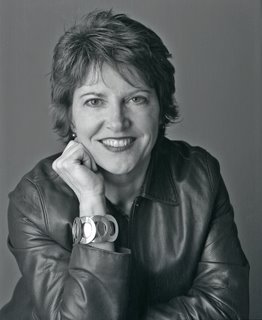
Yesterday Rebecca, Lauren, Rosemary and I visited the Vancouver Art Gallery. We only saw Truth Beauty - Pictorialism and the Photograph as Art, 1845-1945 because short and sweet visits to art galleries do not ruin a child's perception that a gallery can be fun. And fun it was. Rebecca was interested in many more of the photographs that I thought she would be.
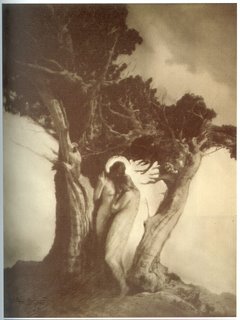
Her favourite (one of mine ) was The Heart of the Storm, 1902 by American photographer Anne Brigman (right). Rebecca laughed and tried to stand on her head to look at Paul Lewis Anderson's Woman Boarding Double-Decker Bus, 1909 when I told her that Anderson's formula for a good photograph was its ability was to hold it upside down to see if the composition remained strong.
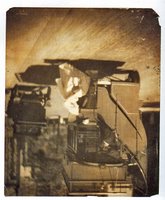
Lauren (5) was getting a bit ansy but I was able to show Rebecca Frederick H. Evans's F. Holland Day in Algerian Costume, 1901. F. Holland Day had just returned from a trip to Northern Africa. With friend and photographer Alvin Langdon Coburn they dressed up in Algerian clothes and rang Evan's doorbell. The housekeeper almost fainted but a unperturbed Evans invited the men in and took their portraits.
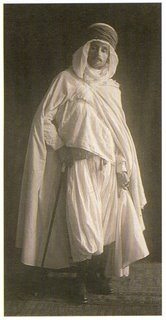
We finished our VAG visit with Rebecca's favourite chocolate brownie at the VAG's coffee shop. While there I waved at travel writer John Masters who makes the coffee shop his office when he is in Vancouver. I thought of all the ghosts that haunt the gallery for me. The Vancouver Art Gallery has litle content on the history or mantions any of the former gallery directors. I photographed all of them with the exception of Willard Holmes. I particularly enjoyed the affable J. Brooks Joyner and I remember the very silent and cold Luke Rombout whom I photographed in the late 70s at the 1145 West Georgia location of the VAG.
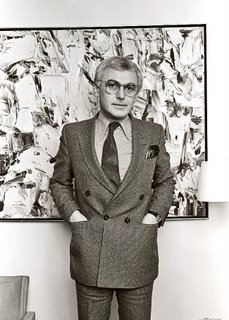
I don't rant in this blog but I do have a minor beef. The situation reminds me of the jealous pharaohs of Ancient Egypt who would rub out the cartouches of their predecessors and would thus have never ever existed. To find the correct spelling of Rombout I had to call former VAG director Abraham Rogatnick. To remember the first name (and the last, too) of former director Alf Bogusky (in the photograph with Michael Audain and curator Daina Augaitis) I had to call Malcolm Parry.
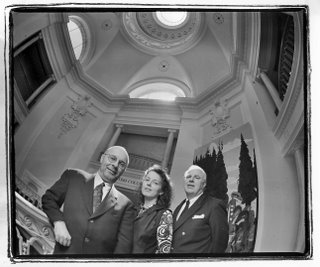
Only the Wikipedia entry for the VAG explained that the gallery building had been built by English architect Francis Rattenbury or that my picture of Arthur Erickson at the formal opening of the gallery had been taken in 1983. The VAG's excellent website will be even better when they add a history.
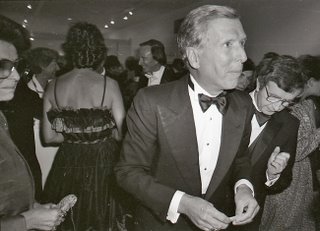
With Lauren a bit bored we walked to the Vancouver Public Library where we all had a pleasant time in the children's library. Rebecca insisted in bringing Howie Mandel (the narrator) Where Did I Come From? video which she watched with Rosemary and Lauren. I found it a bit on the shocking side particularly when the handsome (and married) couple stand up in the bathtub to reveal perfectly sharp (but as cartoons) and perfectly manicured (Brazilian wax jobs) pudenda. It was only later when Hilary (Rebecca and Lauren's mother) found out at the dinner table that Rebecca had allowed Lauren to watch that all hell broke loose. Rosemary's assertion that it had all gone over Lauren's head prevented our evening from being spoiled (Rebecca was not grounded) as we watched the other library video, the perfectly charming Handel's Last Chance where a little Irish beggar/thief boy saves and makes the Messiah a resounding success.
Ojos Que No Ven, Corazón Que No Siente
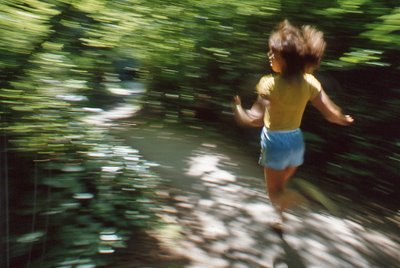
The September 1980 Vancouver Magazine was unique in many ways. Art director Rick Staehling gave my cover photograph a treatment that is rare. He ran the picture with the first paragraph of the copy of the article by Judi Lees. It was a story about a woman who had been raped during a jogging run in Stanley Park.
Staehling had told me, "Go to Stanley Park with a model and photographer her running. Use a long lens to give the idea of someone staking her out and about to pounce." The cover was special for me because I did the opposite. I used an extreme wide angle lens, a 20 mm rectilinear lens and stood a mere four or five feet from my model as she jogged back and forth. I was very pleased with the results as was Staehling who I think would consider this cover one of his most memorable designs.
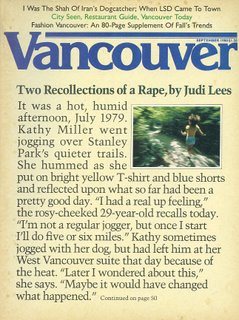
But there is another story behind this cover that is also interesting and I will not be able to provide all the fine details as reputations and feelings have to be respected.
For many years one of my favourite Vancouver musicians has been Stephen Drake. His brother Adam Drake is one of the strongest drummers the city has ever had particularly when he played with Art Bergmann. Brother Stephen was a master of the guitar and is currently a well respected music producer and technician.
The Drake's parents, Sally and Tom were early pioneers in the Vancouver film industry. They both wrote and write screenplays. One day I was having a chat with Tom who told me a strange story.
It seems that they were somehow friends of jazz pianist who was having a need for a fix. It was somewhere in California near Los Angeles and the Drakes had to deliver him to a jazz festival. The pianist was adamant that he was not going anywhere until he got his methodone fix. But his papers were all screwed up so the Drakes drove from one methodone clinic to another tring to convince addicts to volunteer their methodone to help a pianist and they even offered money. But none of the drug addicts knew who Bill Evans was so it took a while before they scored a fix for Evans. By then the concert was about to begin and the highway was jammed with motorists going to it. Finally in desperation Drake stopped his car to plead with a policeman and explained the problem. The cop understood and inidicated to Drake that they should follow him. With sirens blaring Evans made his concert.
The curious fact is that the young woman in my picture was girlfriend to both Stephen Drake and Bill Evans.
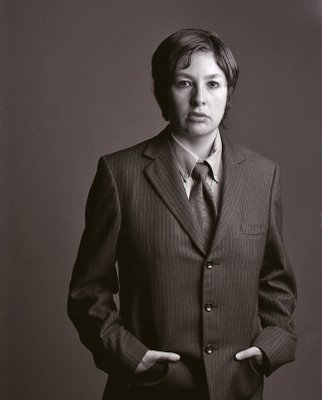
Every once in a while I read the Daybooks of Edward Weston, particularly the one on Mexico and I am jealous at the descriptions of the women that posed for him in the roof of his Mexico City home. I long for those hot days of Mexico with the long shadows and I long for the women that Weston describes. They were earthy, women of a time before we tried to make them our equals and somehow failed in the process.
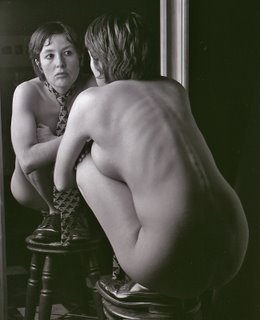
But in actual fact I should not feel at all jealous of Weston. I have "had" my women in the photographic sense and one of the best was Chilean Claudia Paez. I photographed her while my Argentine artists friends Nora Patrich and Juan Manuel Sanchez sketched her. We had many sessions. Some were in my studio the others at the Patrich home. Few of those pictures can I show here. In particular I am fond of a series I did with Claudia and her husband who played the wolf to Claudia's Little Red Riding Hood. In the sequence (alas you can only view two of them) the surprised Caperucita Roja turns the tables on the wolf and takes charge of the situation.
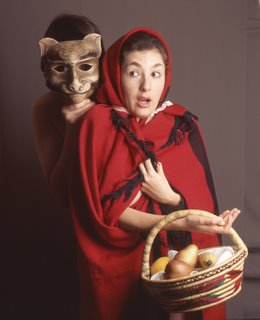
Claudia and husband are back in Chile and I long for them coming back. Perhaps I, too would start my Daybook and title it Vancouver II.
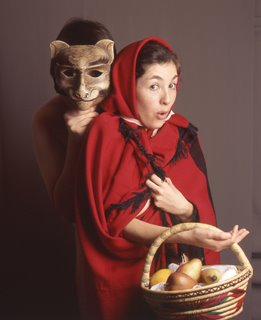
Addendum: An email from Claudia on March 9, 2008
Hola!
Que alegría recibir al menos una línea de ti.
Claro q no me molesto. Al contrario, me alaga. Y ojalá más sesiones vengan pronto. Nosotros estamos esperando respuesta de la Embajada por la residencia.
Te mando un abrazo y muchos cariños
Clau
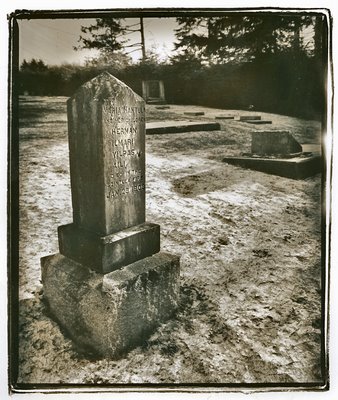
In the 15 years I lived in Mexico I never bothered to find out who Vasco de Quiroga was. I thought he was some old Spanish priest involved in the conquest of Mexico and I left it at that.
Some 12 years ago I visited Mexico City and in a shopping mall in the San Angel Inn area of the city I ran into a most unlikely event. In the mall cinema they were having a festival of the films of German director Wim Wenders. His two angel films, Wings of Desire and Faraway, So Close! are favourites of mine. While I did not have time to catch a film I bought what is now one of my most prized T-shirts, one about Faraway, So Close! but in Spanish, Tan Lejos y Tan Cerca. Reflecting on the T-shirt (I wore it last week) I thought of a place that seems remote in time and location and yet is relatively close. I thought of Sointula and utopias. Let me explain.
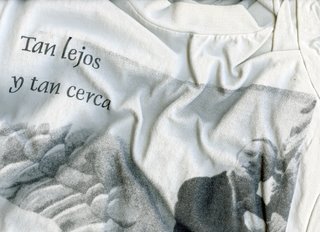
Two years ago Rosemary, Rebecca and I went to the state of Michoacán in Mexico and the presence of Bishop Vasco de Quiroga was everywhere. I found out that this priest, who came to New Spain in 1530, somehow had read a copy of Thomas More's Utopia and seeing the plight of the Mexican Indians he decided to communize them. Vasco de Quiroga staked not only his reputation but his money in this project. His communes somehow survived into the 1850s.
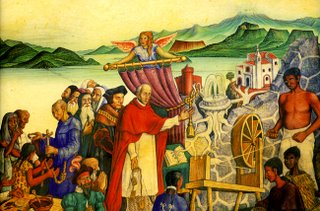
When I returned to Vancouver I found the most delightful biography on Quiroga called Thomas More's Magician - A Novel Of Utopia In Mexico. Writer Toby Green follows the footsteps of Quiroga from his birthplace in Spain all the way to Mexico. The biography is a novel in that Green injects conversations that Quiroga may have had in this account that suddenly made our trip to Michoacán and the cities of Morelia, Pátzcuaro and Uruapan make all the sense in the world.
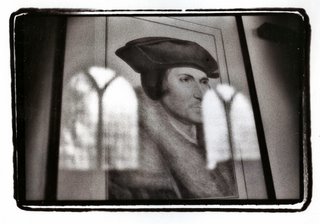
Looking back I remember two other indications of utopia. One was my visit to Thomas More's Chelsea Old Church in London where I photographed the reflections of gothic windows on an illustration of Thomas More that was on the wall. The other connection with utopia was an assignment in December 1994 to illustrate an essay by Taras Grescoe on the utopian Finnish settlement of Sointula on Malcolm Island, B.C. for the Georgia Straight. Photograph, above left is of the graveyard in Sointula.
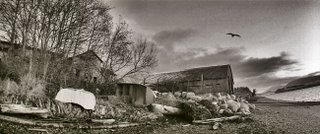
The founder of the settlement in the beginning of the 19th century was Matti Kurrica (below). Like all utopias this one failed. Its failure was hastened by a terrible fire in 1903.
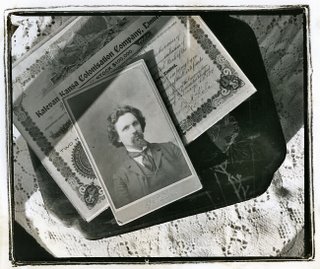
I look at my picture of the two youngsters, Finnish descendants Jess Willims and Alysha Turner on the 3:40 pm school ferry from Port MacNeil (in 1994 there was no high school in Sointula) and I wonder if they are still on the island or if they have left to search for utopia elsewhere.
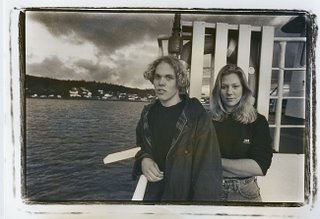
Why did Sointula fail? Taras Grescoe, concludes his story with this:
In British Columbia, there has never been much middle ground, no countryside between wilderness and the city. As the frontier shifted westward across North America in the 19th century, the province seemed to be one of the few places left where the remaining territory was commensurate with man's capacity to imagine a completely different social order.
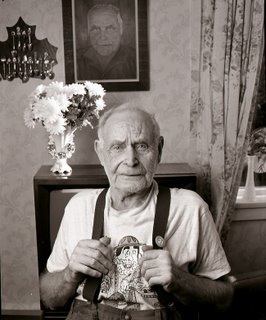
Kurrika's utopia failed - as did thousands of other communes across the continent - because his dreams had something in common with the clearcutting and strip-mining of the most ruthless venture capitalist: they turned the "wilderness" into an abstraction, transforming it into a terrain for ideologies, an enemy to conquer rather than an entity to learn from. Utopia has always been the fragile, pastoral dream of city dwellers. As a site for transforming human nature, it demands a denatured environment. But utopia has a flip side: it is the blank space that appears on the map whenever an equals sign is scrawled between the words "resources" and "nature".
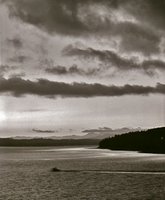
Unlike B.C.'s idealistic utopias this dystopia thrives by creating barren land.
Left a view of Malcolm Island and right, Mauno Ahola, a son of one of the original settlers.
Addendum, February 24, 2008
name: Nicole Laughlin
comments: Every now and then I like to return home and to do
that from Abbotsford it is always easiest to do so by
logging on to the net and typing in Sointula and
waiting to see what loads up. This is how I came to
your site. I am actually Jess' and Alyshas' cousin and
when I read your comment on wondering if they were
still on the Island I thought I would drop a line to
say... no, both have moved away and both now have
families of their own but no matter what, no matter
where you live... home is always Sointula and you
are drawn back for holidays and summer vacations.
Nikki

Anne, Sarah and Mary Macaulay are the three most interesting and fascinating sisters in Vancouver. I know all three and I have photographed Anne and Sarah. After much consideration and without disrespect to the glamourous and sexy Anne, the ethereal and graceful Sarah I think that I would consider Mary the most interesting as her charms and talents are hidden beneath tailored suits and a lawyer's demeanor.

When Sarah (the youngest of the three) approached me for photographs some years ago she was a model who had just returned from Europe. I have never considered myself a fashion photographer but I gave it a try. Sarah, If I remember well said, "I don't mean disrespect to your photography but I really did not like any of the pictures you took of me." And that was the end of that. I looked at them today and I find that some do charm me. The last picture is one of Sarah making up her sister Anne in my studio for a shoot that was a bit more recent, October 2002.
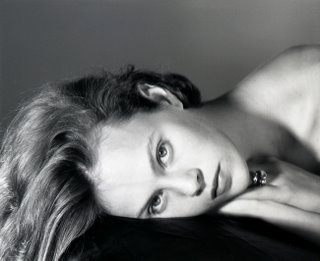
Sarah is involved in town as a curator of many art projects. She and Natalia Tkachev own and run the Blanket Gallery.

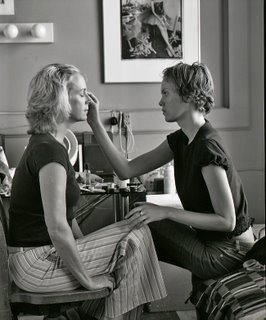
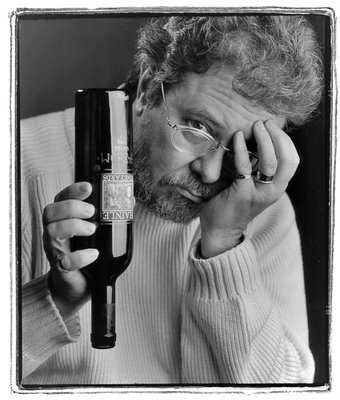
When I first came to Vancouver from Mexico some 38 years ago my knowledge of Canada was limited to having seen the totem pole in Retiro Station in Buenos Aires and the one in Chapultepec Park in Mexico City. From my New Dublin, Ontario wife Rosemary I knew all about an exciting man called Pierre Trudeau. According to her the most beautiful city in Canada was Quebec City. She didn't think I could cope with the snow in those parts so we (she) decided on Vancouver for our family.
I was soon made welcome by the CBC in that my first job as a photographer was there. In that first year in Canada I had been a counter agent for Tilden Rent-Car on Alberni Street. Interesting men with longish hair and or beards came to rent blue Ford station wagons. They said they were from the CBC. They would rent them for months and money seemed to be no problem. They would stuff the wagons with all kinds of sound and TV camera equipment. I wanted a piece of that action so I made my enquiries and finally landed a job taking station ID slides for the new French TV station. From there I crossed that border that still seems to exist at the CBC from the French side to the English side. Through the years I have made lasting friends and I have been proud of whatever I did there. I am particularly thankful for having learned a lot about Canada by listening to CBC Radio or watching (not so much now as I watch very little TV) CBC TV. I was a fan of Wayne & Shuster. One of the most thrilling moments of my life was when cameraman Mike Varga took me to the trailer outside the Coliseum where a man directed all the cameras of Hockey Night In Canada. He sat in front of multiple screens and directed the show. In many ways I almost feel like I have always lived in Canada. The CBC helped me feel at home.
Part of it came from meeting the people of the CBC. I remember one day when I was driving down town and I was listening to Bob Kerr's program Off The Record. He was playing a version of Sergei Rachmaninoff's Vocalise. It featured many cellos. I stopped the car. Kerr said, "That was Rachmaninoff's Vocalise played by the Yale Cellos with Aldo Parisot conductor." I wrote it all down madly. I parked my car in a back alley (I had and have municipal plates) and bought the record at A&B Sound. I was thrilled to meet and photograph Kerr in his studio. I loved his fussy ways and his attention to detail.
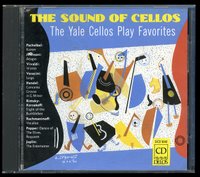
I first met Jurgen Gothe in 1985 when he had just started with Disc Drive. We were in a train going to Whistler, I believe. He entertained me going and coming. I was charmed. I have been lucky to photograph him many times through the years. I have photographed him at home and met his wife and his dog. I have seen his CD collection. Gothe's address is...
I understand that his show is going to end in September. While I don't listen to him every day it is comforting to know he is there and that when I switch him on I will hear a voice with no speech impediment, lisp or mannerism. I will listen to intelligence and good English. This is rare in radio today.
For a long time I suffered a bit (but I liked the music he played and in particular the live concerts he hosted) listening to Eric Friesen. He has an attractive booming voice and perfect diction. Unfortunately he sounds a bit too serious sometimes. I remember listening to one of his former In Performance broadcasts and he was talking to a female string quartet backstage. Friesen made the mistake of asking one of them what it was like in the dressing room. The woman answered that they didn't wear much. Friesen stammered, uncharacteristically he had lost his cool! At that point I understood and began to appreciate the man and I have been a fan since. He came to Vancouver to MC a show and I met him. He did not look at all like the stuffed shirt I pictured him to be. He was tall, blonde and handsome and charming in a quiet way. I will miss him when he departs on December 31st. His "seriousness" had me fooled for a while.
CBC, here is a hint. Show the faces of those radio people more often. We will grow to like them even more.
The above photograph of Gothe ran in the Georgia Straight on March 18, 1999. Gothe wrote about his almost lifelong obsession with wine. His little essay is exactly like his radio show. It relaxes you. The world is just fine and here a sample:
...The best wine ever? I hope I haven't had it yet. The worst? Something pale and pink, made from nectarines, in a non-wine friendly area of Oregon.
And when the wine's all gone? Green tea, Red Zinger, expresso, a shot of cognac, some Aqua Libra, lots of bubbly water. And so to bed.
Once, I was driving over a mountain pass in Montana and stopped for lunch in a tiny town. Main-street bar, limited lunch menu, smell of grease, George Jones on the jukebox. I ordered the burger'n'fries and then asked - it is an obsession - "Have you got any wine?"
She said: "Yeah, but it ain't open."
So all's not all that bad in the world.
A couple of weeks ago I photographed Kathleen Bartels, the Director of the Vancouver Art Gallery. It was a pleasant occasion and it all led me to think that I should renew my lapsed family membership to the gallery. This I did.

Yesterday Rebecca, Lauren, Rosemary and I visited the Vancouver Art Gallery. We only saw Truth Beauty - Pictorialism and the Photograph as Art, 1845-1945 because short and sweet visits to art galleries do not ruin a child's perception that a gallery can be fun. And fun it was. Rebecca was interested in many more of the photographs that I thought she would be.

Her favourite (one of mine ) was The Heart of the Storm, 1902 by American photographer Anne Brigman (right). Rebecca laughed and tried to stand on her head to look at Paul Lewis Anderson's Woman Boarding Double-Decker Bus, 1909 when I told her that Anderson's formula for a good photograph was its ability was to hold it upside down to see if the composition remained strong.

Lauren (5) was getting a bit ansy but I was able to show Rebecca Frederick H. Evans's F. Holland Day in Algerian Costume, 1901. F. Holland Day had just returned from a trip to Northern Africa. With friend and photographer Alvin Langdon Coburn they dressed up in Algerian clothes and rang Evan's doorbell. The housekeeper almost fainted but a unperturbed Evans invited the men in and took their portraits.

We finished our VAG visit with Rebecca's favourite chocolate brownie at the VAG's coffee shop. While there I waved at travel writer John Masters who makes the coffee shop his office when he is in Vancouver. I thought of all the ghosts that haunt the gallery for me. The Vancouver Art Gallery has litle content on the history or mantions any of the former gallery directors. I photographed all of them with the exception of Willard Holmes. I particularly enjoyed the affable J. Brooks Joyner and I remember the very silent and cold Luke Rombout whom I photographed in the late 70s at the 1145 West Georgia location of the VAG.

I don't rant in this blog but I do have a minor beef. The situation reminds me of the jealous pharaohs of Ancient Egypt who would rub out the cartouches of their predecessors and would thus have never ever existed. To find the correct spelling of Rombout I had to call former VAG director Abraham Rogatnick. To remember the first name (and the last, too) of former director Alf Bogusky (in the photograph with Michael Audain and curator Daina Augaitis) I had to call Malcolm Parry.

Only the Wikipedia entry for the VAG explained that the gallery building had been built by English architect Francis Rattenbury or that my picture of Arthur Erickson at the formal opening of the gallery had been taken in 1983. The VAG's excellent website will be even better when they add a history.

With Lauren a bit bored we walked to the Vancouver Public Library where we all had a pleasant time in the children's library. Rebecca insisted in bringing Howie Mandel (the narrator) Where Did I Come From? video which she watched with Rosemary and Lauren. I found it a bit on the shocking side particularly when the handsome (and married) couple stand up in the bathtub to reveal perfectly sharp (but as cartoons) and perfectly manicured (Brazilian wax jobs) pudenda. It was only later when Hilary (Rebecca and Lauren's mother) found out at the dinner table that Rebecca had allowed Lauren to watch that all hell broke loose. Rosemary's assertion that it had all gone over Lauren's head prevented our evening from being spoiled (Rebecca was not grounded) as we watched the other library video, the perfectly charming Handel's Last Chance where a little Irish beggar/thief boy saves and makes the Messiah a resounding success.
Ojos Que No Ven, Corazón Que No Siente
Bill Evans Makes It To The Festival
Saturday, March 08, 2008

The September 1980 Vancouver Magazine was unique in many ways. Art director Rick Staehling gave my cover photograph a treatment that is rare. He ran the picture with the first paragraph of the copy of the article by Judi Lees. It was a story about a woman who had been raped during a jogging run in Stanley Park.
Staehling had told me, "Go to Stanley Park with a model and photographer her running. Use a long lens to give the idea of someone staking her out and about to pounce." The cover was special for me because I did the opposite. I used an extreme wide angle lens, a 20 mm rectilinear lens and stood a mere four or five feet from my model as she jogged back and forth. I was very pleased with the results as was Staehling who I think would consider this cover one of his most memorable designs.

But there is another story behind this cover that is also interesting and I will not be able to provide all the fine details as reputations and feelings have to be respected.
For many years one of my favourite Vancouver musicians has been Stephen Drake. His brother Adam Drake is one of the strongest drummers the city has ever had particularly when he played with Art Bergmann. Brother Stephen was a master of the guitar and is currently a well respected music producer and technician.
The Drake's parents, Sally and Tom were early pioneers in the Vancouver film industry. They both wrote and write screenplays. One day I was having a chat with Tom who told me a strange story.
It seems that they were somehow friends of jazz pianist who was having a need for a fix. It was somewhere in California near Los Angeles and the Drakes had to deliver him to a jazz festival. The pianist was adamant that he was not going anywhere until he got his methodone fix. But his papers were all screwed up so the Drakes drove from one methodone clinic to another tring to convince addicts to volunteer their methodone to help a pianist and they even offered money. But none of the drug addicts knew who Bill Evans was so it took a while before they scored a fix for Evans. By then the concert was about to begin and the highway was jammed with motorists going to it. Finally in desperation Drake stopped his car to plead with a policeman and explained the problem. The cop understood and inidicated to Drake that they should follow him. With sirens blaring Evans made his concert.
The curious fact is that the young woman in my picture was girlfriend to both Stephen Drake and Bill Evans.
Little Red Riding Hood - Vancouver Daybook
Friday, March 07, 2008

Every once in a while I read the Daybooks of Edward Weston, particularly the one on Mexico and I am jealous at the descriptions of the women that posed for him in the roof of his Mexico City home. I long for those hot days of Mexico with the long shadows and I long for the women that Weston describes. They were earthy, women of a time before we tried to make them our equals and somehow failed in the process.

But in actual fact I should not feel at all jealous of Weston. I have "had" my women in the photographic sense and one of the best was Chilean Claudia Paez. I photographed her while my Argentine artists friends Nora Patrich and Juan Manuel Sanchez sketched her. We had many sessions. Some were in my studio the others at the Patrich home. Few of those pictures can I show here. In particular I am fond of a series I did with Claudia and her husband who played the wolf to Claudia's Little Red Riding Hood. In the sequence (alas you can only view two of them) the surprised Caperucita Roja turns the tables on the wolf and takes charge of the situation.

Claudia and husband are back in Chile and I long for them coming back. Perhaps I, too would start my Daybook and title it Vancouver II.

Addendum: An email from Claudia on March 9, 2008
Hola!
Que alegría recibir al menos una línea de ti.
Claro q no me molesto. Al contrario, me alaga. Y ojalá más sesiones vengan pronto. Nosotros estamos esperando respuesta de la Embajada por la residencia.
Te mando un abrazo y muchos cariños
Clau
Utopia - Sointula B.C. - Faraway So Close!
Thursday, March 06, 2008

In the 15 years I lived in Mexico I never bothered to find out who Vasco de Quiroga was. I thought he was some old Spanish priest involved in the conquest of Mexico and I left it at that.
Some 12 years ago I visited Mexico City and in a shopping mall in the San Angel Inn area of the city I ran into a most unlikely event. In the mall cinema they were having a festival of the films of German director Wim Wenders. His two angel films, Wings of Desire and Faraway, So Close! are favourites of mine. While I did not have time to catch a film I bought what is now one of my most prized T-shirts, one about Faraway, So Close! but in Spanish, Tan Lejos y Tan Cerca. Reflecting on the T-shirt (I wore it last week) I thought of a place that seems remote in time and location and yet is relatively close. I thought of Sointula and utopias. Let me explain.

Two years ago Rosemary, Rebecca and I went to the state of Michoacán in Mexico and the presence of Bishop Vasco de Quiroga was everywhere. I found out that this priest, who came to New Spain in 1530, somehow had read a copy of Thomas More's Utopia and seeing the plight of the Mexican Indians he decided to communize them. Vasco de Quiroga staked not only his reputation but his money in this project. His communes somehow survived into the 1850s.

When I returned to Vancouver I found the most delightful biography on Quiroga called Thomas More's Magician - A Novel Of Utopia In Mexico. Writer Toby Green follows the footsteps of Quiroga from his birthplace in Spain all the way to Mexico. The biography is a novel in that Green injects conversations that Quiroga may have had in this account that suddenly made our trip to Michoacán and the cities of Morelia, Pátzcuaro and Uruapan make all the sense in the world.

Looking back I remember two other indications of utopia. One was my visit to Thomas More's Chelsea Old Church in London where I photographed the reflections of gothic windows on an illustration of Thomas More that was on the wall. The other connection with utopia was an assignment in December 1994 to illustrate an essay by Taras Grescoe on the utopian Finnish settlement of Sointula on Malcolm Island, B.C. for the Georgia Straight. Photograph, above left is of the graveyard in Sointula.

The founder of the settlement in the beginning of the 19th century was Matti Kurrica (below). Like all utopias this one failed. Its failure was hastened by a terrible fire in 1903.

I look at my picture of the two youngsters, Finnish descendants Jess Willims and Alysha Turner on the 3:40 pm school ferry from Port MacNeil (in 1994 there was no high school in Sointula) and I wonder if they are still on the island or if they have left to search for utopia elsewhere.

Why did Sointula fail? Taras Grescoe, concludes his story with this:
In British Columbia, there has never been much middle ground, no countryside between wilderness and the city. As the frontier shifted westward across North America in the 19th century, the province seemed to be one of the few places left where the remaining territory was commensurate with man's capacity to imagine a completely different social order.

Kurrika's utopia failed - as did thousands of other communes across the continent - because his dreams had something in common with the clearcutting and strip-mining of the most ruthless venture capitalist: they turned the "wilderness" into an abstraction, transforming it into a terrain for ideologies, an enemy to conquer rather than an entity to learn from. Utopia has always been the fragile, pastoral dream of city dwellers. As a site for transforming human nature, it demands a denatured environment. But utopia has a flip side: it is the blank space that appears on the map whenever an equals sign is scrawled between the words "resources" and "nature".

Unlike B.C.'s idealistic utopias this dystopia thrives by creating barren land.
Left a view of Malcolm Island and right, Mauno Ahola, a son of one of the original settlers.
Addendum, February 24, 2008
name: Nicole Laughlin
comments: Every now and then I like to return home and to do
that from Abbotsford it is always easiest to do so by
logging on to the net and typing in Sointula and
waiting to see what loads up. This is how I came to
your site. I am actually Jess' and Alyshas' cousin and
when I read your comment on wondering if they were
still on the Island I thought I would drop a line to
say... no, both have moved away and both now have
families of their own but no matter what, no matter
where you live... home is always Sointula and you
are drawn back for holidays and summer vacations.
Nikki
The Little Sister
Wednesday, March 05, 2008

Anne, Sarah and Mary Macaulay are the three most interesting and fascinating sisters in Vancouver. I know all three and I have photographed Anne and Sarah. After much consideration and without disrespect to the glamourous and sexy Anne, the ethereal and graceful Sarah I think that I would consider Mary the most interesting as her charms and talents are hidden beneath tailored suits and a lawyer's demeanor.

When Sarah (the youngest of the three) approached me for photographs some years ago she was a model who had just returned from Europe. I have never considered myself a fashion photographer but I gave it a try. Sarah, If I remember well said, "I don't mean disrespect to your photography but I really did not like any of the pictures you took of me." And that was the end of that. I looked at them today and I find that some do charm me. The last picture is one of Sarah making up her sister Anne in my studio for a shoot that was a bit more recent, October 2002.

Sarah is involved in town as a curator of many art projects. She and Natalia Tkachev own and run the Blanket Gallery.


Jurgen Gothe, Good To The Last Drop, Eric Friesen Stammers
Tuesday, March 04, 2008

When I first came to Vancouver from Mexico some 38 years ago my knowledge of Canada was limited to having seen the totem pole in Retiro Station in Buenos Aires and the one in Chapultepec Park in Mexico City. From my New Dublin, Ontario wife Rosemary I knew all about an exciting man called Pierre Trudeau. According to her the most beautiful city in Canada was Quebec City. She didn't think I could cope with the snow in those parts so we (she) decided on Vancouver for our family.
I was soon made welcome by the CBC in that my first job as a photographer was there. In that first year in Canada I had been a counter agent for Tilden Rent-Car on Alberni Street. Interesting men with longish hair and or beards came to rent blue Ford station wagons. They said they were from the CBC. They would rent them for months and money seemed to be no problem. They would stuff the wagons with all kinds of sound and TV camera equipment. I wanted a piece of that action so I made my enquiries and finally landed a job taking station ID slides for the new French TV station. From there I crossed that border that still seems to exist at the CBC from the French side to the English side. Through the years I have made lasting friends and I have been proud of whatever I did there. I am particularly thankful for having learned a lot about Canada by listening to CBC Radio or watching (not so much now as I watch very little TV) CBC TV. I was a fan of Wayne & Shuster. One of the most thrilling moments of my life was when cameraman Mike Varga took me to the trailer outside the Coliseum where a man directed all the cameras of Hockey Night In Canada. He sat in front of multiple screens and directed the show. In many ways I almost feel like I have always lived in Canada. The CBC helped me feel at home.
Part of it came from meeting the people of the CBC. I remember one day when I was driving down town and I was listening to Bob Kerr's program Off The Record. He was playing a version of Sergei Rachmaninoff's Vocalise. It featured many cellos. I stopped the car. Kerr said, "That was Rachmaninoff's Vocalise played by the Yale Cellos with Aldo Parisot conductor." I wrote it all down madly. I parked my car in a back alley (I had and have municipal plates) and bought the record at A&B Sound. I was thrilled to meet and photograph Kerr in his studio. I loved his fussy ways and his attention to detail.

I first met Jurgen Gothe in 1985 when he had just started with Disc Drive. We were in a train going to Whistler, I believe. He entertained me going and coming. I was charmed. I have been lucky to photograph him many times through the years. I have photographed him at home and met his wife and his dog. I have seen his CD collection. Gothe's address is...
I understand that his show is going to end in September. While I don't listen to him every day it is comforting to know he is there and that when I switch him on I will hear a voice with no speech impediment, lisp or mannerism. I will listen to intelligence and good English. This is rare in radio today.
For a long time I suffered a bit (but I liked the music he played and in particular the live concerts he hosted) listening to Eric Friesen. He has an attractive booming voice and perfect diction. Unfortunately he sounds a bit too serious sometimes. I remember listening to one of his former In Performance broadcasts and he was talking to a female string quartet backstage. Friesen made the mistake of asking one of them what it was like in the dressing room. The woman answered that they didn't wear much. Friesen stammered, uncharacteristically he had lost his cool! At that point I understood and began to appreciate the man and I have been a fan since. He came to Vancouver to MC a show and I met him. He did not look at all like the stuffed shirt I pictured him to be. He was tall, blonde and handsome and charming in a quiet way. I will miss him when he departs on December 31st. His "seriousness" had me fooled for a while.
CBC, here is a hint. Show the faces of those radio people more often. We will grow to like them even more.
The above photograph of Gothe ran in the Georgia Straight on March 18, 1999. Gothe wrote about his almost lifelong obsession with wine. His little essay is exactly like his radio show. It relaxes you. The world is just fine and here a sample:
...The best wine ever? I hope I haven't had it yet. The worst? Something pale and pink, made from nectarines, in a non-wine friendly area of Oregon.
And when the wine's all gone? Green tea, Red Zinger, expresso, a shot of cognac, some Aqua Libra, lots of bubbly water. And so to bed.
Once, I was driving over a mountain pass in Montana and stopped for lunch in a tiny town. Main-street bar, limited lunch menu, smell of grease, George Jones on the jukebox. I ordered the burger'n'fries and then asked - it is an obsession - "Have you got any wine?"
She said: "Yeah, but it ain't open."
So all's not all that bad in the world.
Monday, March 03, 2008

When Buck Cherry, a.k.a. John Armstrong called me in late 1985 to ask me if I wanted to take a band photograph, "No," came up immediately. Band photographs for the then popular album covers (before they were done in by the small image on a CD cover) could be classified as follows:
1. A one member band was relatively easy. You only had to cope with one ego.
2. A two-member band. Not so easy but easy enough.
3. A three-member band. This setup was one of my favourites it was nicely symetrical for a square album shot.
4. A four-member or more band became a boring group shot. One could imitate (usually on the request of the band!) a Rolling Stones or Beatles album. I hated these jobs with a passion. They all wanted to look different but yet be recognizable by their mother. They never had a decent budget and would trash my studio.
When Armstrong told me it was five member band I simply said, "No." He insisted and I finally gave in when he told me the band had a star female singer.
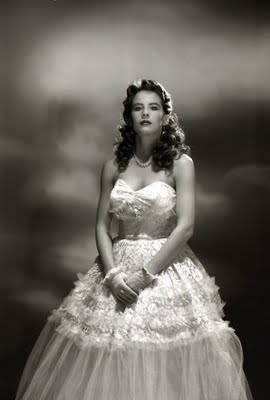
The band (The Lost Durangos) called the album Evil Town and it included one of those quintessential Vancouver rain songs, I've Seen The Rain. Someone should compile Vancouver rain songs. Another would have to be The Young Canadians's Hawaii.
Inga Vollmer did her wonderful makeup and with some complex 40s lighting we made the band look like film noir stars. Lead singer Kelly Brock reminded me of a combination queen bee and Scarlet O'Hara.
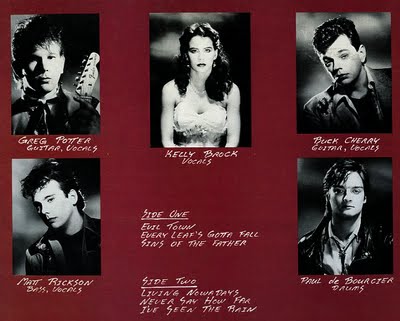
When the five clustered for my group shot I felt it was magical. It was. As I see the record cover today and look at the individual pictures, I feel the sadness of lost youth. They were so young.
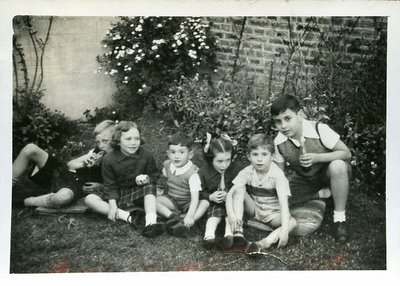
Robby Miranda entered my life just a bit before these pictures were taken in Buenos Aires in 1950. He is on the far right, just next to me (my shirt has a central stripe). In the second picture (his birthday) he is in the top row on the far left and I am the gaucho. He and I were distantly related through his father Luís Miranda who was my grandfather Tirso's first cousin. Through most of my life until Luís died he was my favourite uncle and his wife Fermina was my favourite aunt until she died last year in Houston at age 95.
Robby is singly responsible that I am a photographer today. In the late 60s in Mexico City I was flaundering at university not being sure what I wanted to do with my life. In 1967 I had gone to San Francisco for a month and I lived with a friend Robert Hijar in the Haight-Ashbury area and times. One day I took the cable car to the waterfront and watched some young students get off before the cable car went downhill. They went to a quaint place that was called the San Francisco Art Institute. I also got off. I was curious. I asked one of the young men what he was studying there. I remember his reply which was like a lightning bolt, "I am studying photography. I want to be a photographer." Until that moment I did not know one could study photography or that it could be a profession. At that moment I considered all I had done in my life until then to have been a waste.
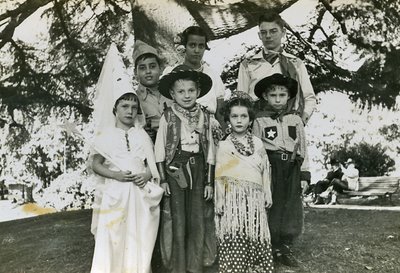
Robby in the late 60s was making lots of money distributing a new item for the kitchen called a Tefal Frying Pan. I kept telling him that I could never be a photographer now that I wanted to be one. He asked me, "What do you need? I have an American Express Card. Let's go and get what you need." Robby was true to his word and we purchased a Durst enlarger, a darkroom timer, trays, a thermometer and a safelight. I realized when we went home that I was in trouble. I no longer had an excuse for failure.
In 1950 Robby had recently arrived to Buenos Aires via New York. Their sumptuous home in Manila had been taken over by the Japanese High Command during the duration of the war. Robby who was three years older than I was seemed to be a strange boy. If you pointed a toy gun at him he would cry and hide under a table. I knew nothing of real war. It was Robby who told me of WWII and Hitler and the Japanese. He told me stories of how Hitler had survived the war and was living in an oasis (there were pockets of warm air) near the South Pole. In his Belgrano home I was fascinated by his father's (my Uncle Luis) complete collection of Life magazine from Pearl Harbour until Victory in the Pacific Day. I stared at Sherman tank ads by Buick (they had Dynaflow transmissions) and saw some of my first photographs of real dead people.
The Mirandas and Robby moved to Mexico City and we followed in 1955. It was there that I would have sleepovers at Robbys and we would go for walks on Balderas Street and he would tell me of Aristotle and his Unmovable Mover who was God. He knew of these things because he was going to a private school of Catholic Marista Brothers. From Robby I learned to be interested in being interested. We went to many movies and somehow since he was older and bigger they never stopped us when the content of the film was not for children. But it wasn't all just Aristotle, Hitler and films. Robby took me to my first American football game (University of Mexico versus Mexico City College) and my first baseball game (a double A match between the Diablos Rojos and the Mexico City Tigers). After 14 long innings the game was postponed for the next day and we were given rain cheques. We did not return.
Last night I thought about Robby as I had a tremendous confrontation with Rebecca in the mornign. I had the intention of taking her and Lauren to see Roughhouse at the Vancouver East Cultural Centre. The show was to begin at 2pm. It was 1pm. I had seen this brilliantly funny piece of one-hour pantomime on Tuesday. It was perfect for them. But Rebecca said, "I don't want culture (that C word). I want to be a kid." And she called her father to say she didn't want to go. I was shocked, angry and aghast. I could not take Lauren as Lauren will not go anywhere without her sister.
Another plan for the day was to buy a one year membership to the Vancouver Art Gallery. We were going to look at the exhibition of photographs from the Eastman House Collection. In my fury I acted like another child and refused to go anywhere. Rosemary suggested we walk in VanDusen. I shook my head. She said, "Alex, you are acting like a child." I just answered, "I like acting like one, perhaps because I am still one." For the rest of the day I felt guilty as hell.
The morning had not begun well. Rebecca had come in, and after a perfunctory, "Que tal, Papi," she had turned on the TV. At age 10 my parents had taught me what in Spanish we call educación (sort of like manners). Would I in Rebecca's place have made some conversation, asked if I was still sick, offer a hug, something?
If there is any despair in all this it is in the realization on how lucky I was to have Robby and his challenging brand of friendship. Will Rebecca ever have such a friend? A friend that will interest her to be interested?
And Robby, thank you.

When Buck Cherry, a.k.a. John Armstrong called me in late 1985 to ask me if I wanted to take a band photograph, "No," came up immediately. Band photographs for the then popular album covers (before they were done in by the small image on a CD cover) could be classified as follows:
1. A one member band was relatively easy. You only had to cope with one ego.
2. A two-member band. Not so easy but easy enough.
3. A three-member band. This setup was one of my favourites it was nicely symetrical for a square album shot.
4. A four-member or more band became a boring group shot. One could imitate (usually on the request of the band!) a Rolling Stones or Beatles album. I hated these jobs with a passion. They all wanted to look different but yet be recognizable by their mother. They never had a decent budget and would trash my studio.
When Armstrong told me it was five member band I simply said, "No." He insisted and I finally gave in when he told me the band had a star female singer.

The band (The Lost Durangos) called the album Evil Town and it included one of those quintessential Vancouver rain songs, I've Seen The Rain. Someone should compile Vancouver rain songs. Another would have to be The Young Canadians's Hawaii.
Inga Vollmer did her wonderful makeup and with some complex 40s lighting we made the band look like film noir stars. Lead singer Kelly Brock reminded me of a combination queen bee and Scarlet O'Hara.

When the five clustered for my group shot I felt it was magical. It was. As I see the record cover today and look at the individual pictures, I feel the sadness of lost youth. They were so young.
That C Word - A Tefal Frying Pan & A Useful AMEX Card
Sunday, March 02, 2008

Robby Miranda entered my life just a bit before these pictures were taken in Buenos Aires in 1950. He is on the far right, just next to me (my shirt has a central stripe). In the second picture (his birthday) he is in the top row on the far left and I am the gaucho. He and I were distantly related through his father Luís Miranda who was my grandfather Tirso's first cousin. Through most of my life until Luís died he was my favourite uncle and his wife Fermina was my favourite aunt until she died last year in Houston at age 95.
Robby is singly responsible that I am a photographer today. In the late 60s in Mexico City I was flaundering at university not being sure what I wanted to do with my life. In 1967 I had gone to San Francisco for a month and I lived with a friend Robert Hijar in the Haight-Ashbury area and times. One day I took the cable car to the waterfront and watched some young students get off before the cable car went downhill. They went to a quaint place that was called the San Francisco Art Institute. I also got off. I was curious. I asked one of the young men what he was studying there. I remember his reply which was like a lightning bolt, "I am studying photography. I want to be a photographer." Until that moment I did not know one could study photography or that it could be a profession. At that moment I considered all I had done in my life until then to have been a waste.

Robby in the late 60s was making lots of money distributing a new item for the kitchen called a Tefal Frying Pan. I kept telling him that I could never be a photographer now that I wanted to be one. He asked me, "What do you need? I have an American Express Card. Let's go and get what you need." Robby was true to his word and we purchased a Durst enlarger, a darkroom timer, trays, a thermometer and a safelight. I realized when we went home that I was in trouble. I no longer had an excuse for failure.
In 1950 Robby had recently arrived to Buenos Aires via New York. Their sumptuous home in Manila had been taken over by the Japanese High Command during the duration of the war. Robby who was three years older than I was seemed to be a strange boy. If you pointed a toy gun at him he would cry and hide under a table. I knew nothing of real war. It was Robby who told me of WWII and Hitler and the Japanese. He told me stories of how Hitler had survived the war and was living in an oasis (there were pockets of warm air) near the South Pole. In his Belgrano home I was fascinated by his father's (my Uncle Luis) complete collection of Life magazine from Pearl Harbour until Victory in the Pacific Day. I stared at Sherman tank ads by Buick (they had Dynaflow transmissions) and saw some of my first photographs of real dead people.
The Mirandas and Robby moved to Mexico City and we followed in 1955. It was there that I would have sleepovers at Robbys and we would go for walks on Balderas Street and he would tell me of Aristotle and his Unmovable Mover who was God. He knew of these things because he was going to a private school of Catholic Marista Brothers. From Robby I learned to be interested in being interested. We went to many movies and somehow since he was older and bigger they never stopped us when the content of the film was not for children. But it wasn't all just Aristotle, Hitler and films. Robby took me to my first American football game (University of Mexico versus Mexico City College) and my first baseball game (a double A match between the Diablos Rojos and the Mexico City Tigers). After 14 long innings the game was postponed for the next day and we were given rain cheques. We did not return.
Last night I thought about Robby as I had a tremendous confrontation with Rebecca in the mornign. I had the intention of taking her and Lauren to see Roughhouse at the Vancouver East Cultural Centre. The show was to begin at 2pm. It was 1pm. I had seen this brilliantly funny piece of one-hour pantomime on Tuesday. It was perfect for them. But Rebecca said, "I don't want culture (that C word). I want to be a kid." And she called her father to say she didn't want to go. I was shocked, angry and aghast. I could not take Lauren as Lauren will not go anywhere without her sister.
Another plan for the day was to buy a one year membership to the Vancouver Art Gallery. We were going to look at the exhibition of photographs from the Eastman House Collection. In my fury I acted like another child and refused to go anywhere. Rosemary suggested we walk in VanDusen. I shook my head. She said, "Alex, you are acting like a child." I just answered, "I like acting like one, perhaps because I am still one." For the rest of the day I felt guilty as hell.
The morning had not begun well. Rebecca had come in, and after a perfunctory, "Que tal, Papi," she had turned on the TV. At age 10 my parents had taught me what in Spanish we call educación (sort of like manners). Would I in Rebecca's place have made some conversation, asked if I was still sick, offer a hug, something?
If there is any despair in all this it is in the realization on how lucky I was to have Robby and his challenging brand of friendship. Will Rebecca ever have such a friend? A friend that will interest her to be interested?
And Robby, thank you.
Saturday, March 01, 2008
A few months ago Abraham Rogatnick and I went to a preview performance of sections of the new opera Dream Healer based on Timothy Findley's 1999 novel Pilgrim. We were both pleased and looked forward to the premiere. That premiere is upon us as we will be attending that premiere on Sunday at the Chan at UBC.
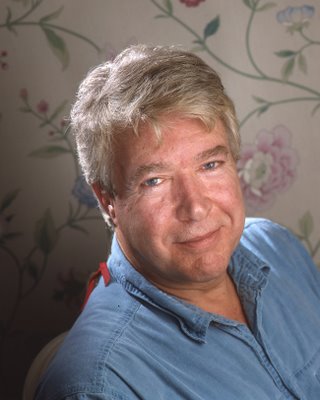
Rogatnick introduced me to the composer Lloyd Burritt (below, right) an affable man with a catchy smile. I asked him if he thought his opera (The original adaptation and libretto were by Christopher Allan. The revised libretto and additional material are by Don Mowat) would have legs. With that smile of his he responded, "It is the only opera that I know in which one of the characters is a practising psychiatrist, and he is no other than Carl Jung."
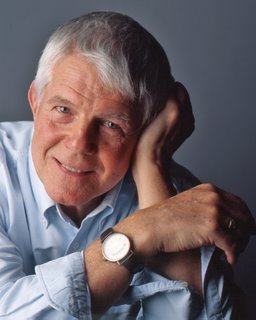
In Findley's novel Pilgrim Jung is fascinated by a man called Pilgrim who is obsessed with the idea that he cannot die and has many failed suicide attempts. He recounts in details meetings with da Vinci, Teresa de Ávila and Oscar Wilde.
With singers Judith Forst, Mezzo-soprano as Lady Sybil, John Avey, Baritone as Carl Jung and, Roelof Oostwoud, Tenor as Pilgrim this promises to be the opera premiere of the season.
But there is more!
In 1988 writer Peter Buitenhuis interviewed Timothy Findley and I photographed him in a suite at the Hotel Vancouver for Books In Canada. Both Findley and his friend, William Whitehead, while not being able to penetrate the serious and studious professorial demeanor of Buitenhuis, charmed me. It was easy to photograph Findley. Whitehead became my de facto art director.
Buitenhuis made up for his seriousness with his research of the man. He asked Findley some interesting questions. These questions surely were in the Burritt's mind when he composed this opera.
Buitenhuis: I want to turn from questions of influence to subject. Your first novel, The Last of the Crazy People , might in fact be said to be the first of the crazy people you've dealt with in almost all your fiction. You certainly have a concern for the mentally obsessed and the unbalanced. Is this largely for dramatic effect, or is it because you yourself have a fascination with the world of the mentally excessive and unbalanced?
Findley: I think the latter. It's a conception of what other people call crazy. It is the ultimate simplicity. It may be focused on one gesture or one passion, but the way in which it is focused, with the mentally troubled, tells me so much about the human spirit and mind and the obsession with perfection.
Buitenhuis: Is there any other comment you'd like to make abou this collection (Stones) of stories?
Findley: No, except that I enjoyed writing it. It was a deliberate attempt to put a book of stories together rather than to collect stories that I had been writing randomly over time. I am not a short story writer, in the sense that Alice Munro is -a writer, by the way that I admire immensly. It was a new kind of writing, a new way of organizing a book. I set them all in Toronto, deliberately, and kept discovering that they were about brothers and sisters, husbands and wives, and parents and children, deeply committed relationships and the crises they provoke - the whole book had that. The copy editor giggled at the end of her work and said to me: "I don't think you realize this, but are you aware that the Queen Street Mental Health Centre is a character in every single one of these stories?" And by God it is!
Buitinhuis": And a very powerful character too.
Findley: And I literally didn't know that.
Buitinhuis: Back to the Crazy People!
Findley: Yes, back to the Crazy People.
A few months ago Abraham Rogatnick and I went to a preview performance of sections of the new opera Dream Healer based on Timothy Findley's 1999 novel Pilgrim. We were both pleased and looked forward to the premiere. That premiere is upon us as we will be attending that premiere on Sunday at the Chan at UBC.

Rogatnick introduced me to the composer Lloyd Burritt (below, right) an affable man with a catchy smile. I asked him if he thought his opera (The original adaptation and libretto were by Christopher Allan. The revised libretto and additional material are by Don Mowat) would have legs. With that smile of his he responded, "It is the only opera that I know in which one of the characters is a practising psychiatrist, and he is no other than Carl Jung."

In Findley's novel Pilgrim Jung is fascinated by a man called Pilgrim who is obsessed with the idea that he cannot die and has many failed suicide attempts. He recounts in details meetings with da Vinci, Teresa de Ávila and Oscar Wilde.
With singers Judith Forst, Mezzo-soprano as Lady Sybil, John Avey, Baritone as Carl Jung and, Roelof Oostwoud, Tenor as Pilgrim this promises to be the opera premiere of the season.
But there is more!
In 1988 writer Peter Buitenhuis interviewed Timothy Findley and I photographed him in a suite at the Hotel Vancouver for Books In Canada. Both Findley and his friend, William Whitehead, while not being able to penetrate the serious and studious professorial demeanor of Buitenhuis, charmed me. It was easy to photograph Findley. Whitehead became my de facto art director.
Buitenhuis made up for his seriousness with his research of the man. He asked Findley some interesting questions. These questions surely were in the Burritt's mind when he composed this opera.
Buitenhuis: I want to turn from questions of influence to subject. Your first novel, The Last of the Crazy People , might in fact be said to be the first of the crazy people you've dealt with in almost all your fiction. You certainly have a concern for the mentally obsessed and the unbalanced. Is this largely for dramatic effect, or is it because you yourself have a fascination with the world of the mentally excessive and unbalanced?
Findley: I think the latter. It's a conception of what other people call crazy. It is the ultimate simplicity. It may be focused on one gesture or one passion, but the way in which it is focused, with the mentally troubled, tells me so much about the human spirit and mind and the obsession with perfection.
Buitenhuis: Is there any other comment you'd like to make abou this collection (Stones) of stories?
Findley: No, except that I enjoyed writing it. It was a deliberate attempt to put a book of stories together rather than to collect stories that I had been writing randomly over time. I am not a short story writer, in the sense that Alice Munro is -a writer, by the way that I admire immensly. It was a new kind of writing, a new way of organizing a book. I set them all in Toronto, deliberately, and kept discovering that they were about brothers and sisters, husbands and wives, and parents and children, deeply committed relationships and the crises they provoke - the whole book had that. The copy editor giggled at the end of her work and said to me: "I don't think you realize this, but are you aware that the Queen Street Mental Health Centre is a character in every single one of these stories?" And by God it is!
Buitinhuis": And a very powerful character too.
Findley: And I literally didn't know that.
Buitinhuis: Back to the Crazy People!
Findley: Yes, back to the Crazy People.






